
Admin
-
Posts
7,448 -
Joined
-
Last visited
Content Type
Profiles
Forums
Events
Store
Gallery
Community Map
Posts posted by Admin
-
-
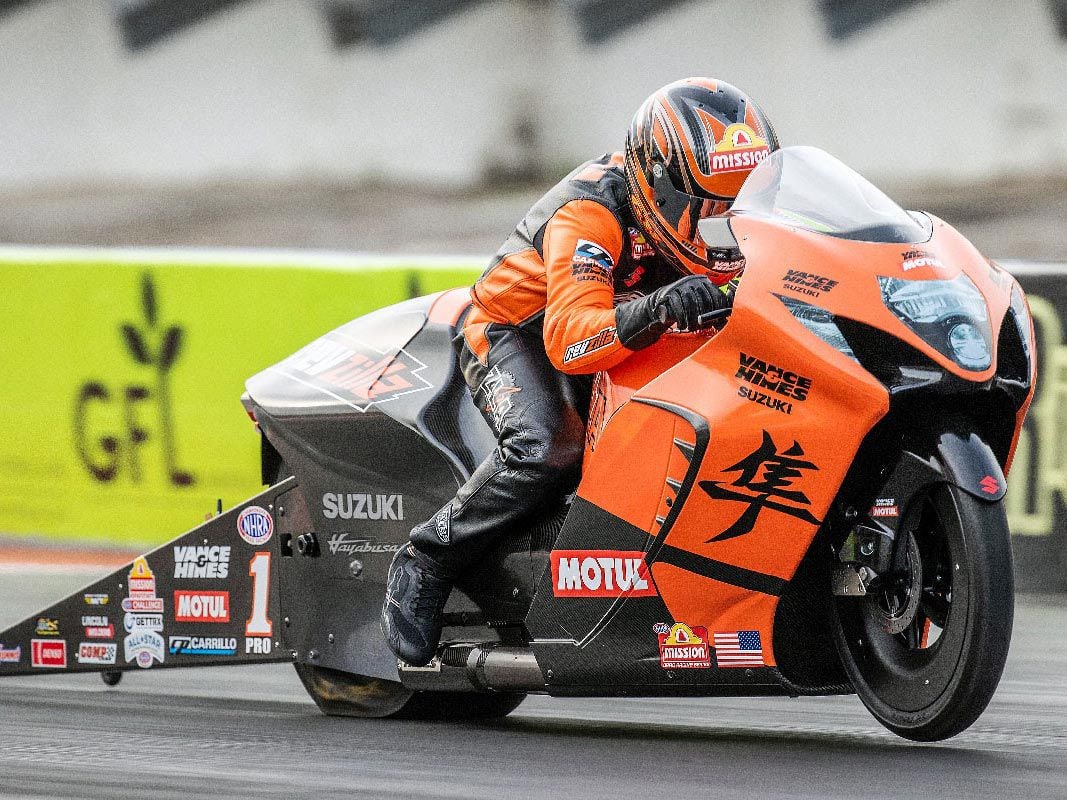
Defending NHRA Pro Stock Motorcycle Champion Gaige Herrera (1) backs up his incredible 2023 season with a dominant win at the 2024 Gatornationals on the Gen 3 Hayabusa. (Matt Polito/)Suzuki Press Release:
Reigning NHRA Pro Stock Motorcycle World Champion Gaige Herrera opened the defense of his 2023 crown Sunday with a dominant win aboard his RevZilla/Mission/Vance & Hines Suzuki Gen 3 Hayabusa at the NHRA Gatornationals in Gainesville, Florida, the first round of the 2024 season.
Race Highlights:
- Gaige Herrera qualified No. 1 and set a new track elapsed time record earning a second-consecutive season-opening win at the Gatornationals, the 12th win of his career.
- Richard Gadson qualified sixth in his rookie NHRA season debut and advanced to the second round of eliminations.
Following one of the most dominant seasons in NHRA history, Herrera picked up in Gainesville right where he left off at the end of 2023, a year that saw him set class records for wins (11) and number-one qualifiers (14).
Herrera led qualifying with a 6.746-second/200.50mph run to earn the top starting spot for the 15th time in his career and the tenth race in a row dating back to last year.
In round one, Herrera defeated Joey Gladstone (6.949 seconds/194.16mph) with a 6.639-second/204.35mph pass to set a new Gainesville elapsed time track record. Herrera reset that mark in round two against John Hall (6.801 seconds/201.37mph) with a blistering 6.629-second/204.54mph pass, the second quickest in class history and only 0.002-seconds slower than the national record he set last season in Dallas. Herrera now owns the top 10 quickest passes in NHRA Pro Stock Motorcycle history, all on a Gen III Suzuki Hayabusa.
In the semi-final round, Herrera ran 6.684-seconds at 202.27mph to defeat Angie Smith (6.735 seconds/202.91mph), setting up a final-round matchup against her husband, Matt Smith. Herrera defeated Smith (6.748 seconds/200.83mph) with a 6.636-second/204.39mph run to notch the 12th win of his career and second straight at the Gatornationals.
A year ago, Herrera rolled into Gainesville as a relative unknown. Now with a history-making season of superlatives behind him, he stands atop the class with a target on his back and high expectations for his sophomore season in the class.
”I put a lot of pressure on myself coming into this race. I set pretty high expectations for myself, wanting to duplicate what I did last year. I came focused and ready to go, whereas last year I came here just not wanting to make a fool out of myself,” Herrera said. “I had a great feeling all weekend beginning in Q1. My Hayabusa is very consistent and rides like it’s on rails. Andrew Hines and the rest of the team worked extremely hard during the offseason to make sure our motorcycles run great, and it shows. Once I’m in the burnout box, all I focus on is what I need to do as a rider. There’s nothing better for my mindset than having that kind of confidence in the team.”
Richard Gadson, who joined the RevZilla/Mission/Vance & Hines Suzuki team in the offseason, is riding the Gen 3 Suzuki Hayabusa previously piloted and now tuned by four-time NHRA champion Eddie Krawiec. Although technically a rookie with only two previous Pro Stock Motorcycle starts to his credit, the Philadelphia native and nephew of legendary drag racer Ricky Gadson, brings the experience of multiple AMA Pro Star series championships and consistent success in high-stakes grudge racing to the team.
Gadson qualified in sixth position with a 6.817-second/198.32 mph run. He achieved the primary goal of his season debut by turning on the win light in round one with a career-best 6.724-second/201.97mph victory over Kelly Clontz (6.829 seconds/197.39mph). In round two, Gadson left the starting line too soon, resulting in a redlight loss to LE Tonglet and an early end to the weekend.
“Coming up against a tough competitor in the second round, I felt like I had to go hard on the tree, and I ended up on the wrong side of it, Gadson said. “It’s a new bike, new team, new everything for me. We’re still working to find the best chassis and clutch setup that works for me. We came to Florida early with the intent to test but Mother Nature had different plans. The lack of testing set us back a little on that, but I still ran my personal best, had my first-round win, and made my first 200mph pass. You can’t wipe the smile off my face.”
With leading motorcycle parts retailer RevZilla assuming a primary sponsorship alongside Mission Foods and Suzuki this season, crew chief Andrew Hines was happy to begin the season in strong form and eager to show that last year was no fluke.
“The weather we had today was just what the doctor ordered for our four-valve Hayabusas. Working off the notes from last year, we didn’t have to change much in the setup for Gaige’s bike and here we are back in the winner’s circle,” Hines said. “You can’t ask for a more fantastic way to start a season, with new people on board and new partnerships that are pushing us to keep raising our level of performance. Striking these new deals over the winter was pivotal in our ability to continue running a top-notch program. We have Richard on board now taking Eddie’s spot on the bike, and it’s just a matter of time before we get everything clicking with him. It’s exciting.”
After the first of 16 races in the 2024 season, Herrera and Gadson sit first and sixth in the Pro Stock Motorcycle standings with 127 and 54 points, respectively.
The RevZilla/Mission/Vance & Hines Suzuki team returns to action April 26-28 at the NHRA Four-Wide Nationals at zMax Dragway in Concord, NC.
-
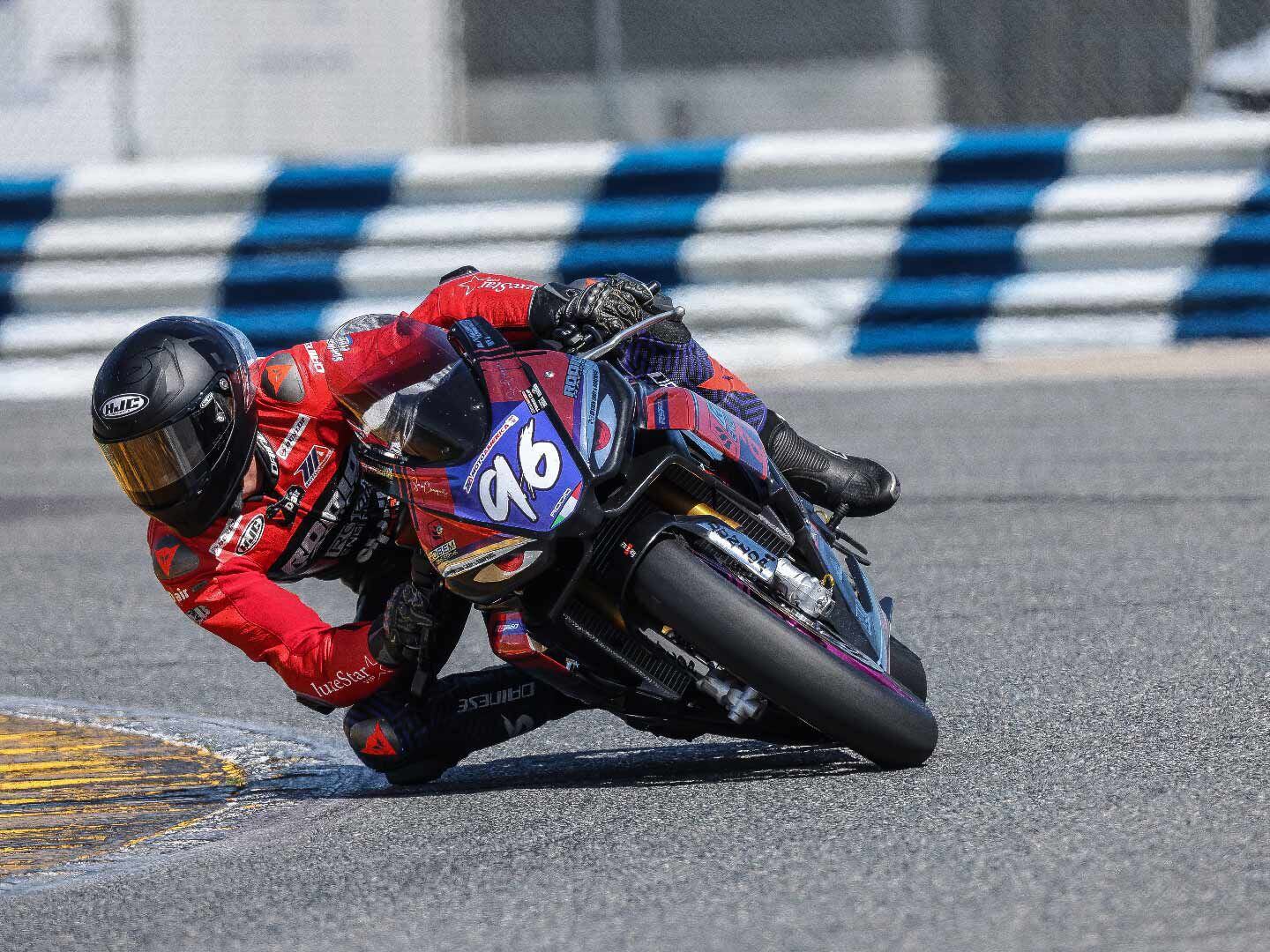
Gus Rodio Rides Aprilia RS 660 to Victory in MotoAmerica Twins Cup Season Opener at Daytona (Brian J. Nelson/)Aprilia Press Release:
Aprilia rider Gus Rodio’s campaign to clinch the MotoAmerica Twins Cup title he narrowly missed out on in 2023 could not have started in a better way. The Hammonton, N.J., resident piloted his Rodio Racing – Powered by Robem Engineering Aprilia RS 660 to two victories by impressive margins at the season-opening round of MotoAmerica’s 2024 Twins Cup at Daytona International Speedway.
Rodio’s two wins were just a couple of the successes Aprilia RS 660 riders had on Friday and Saturday on the iconic facility’s 3.51-mile motorcycle road course layout. Rodio’s teammates – Twins Cup rookie Alessandro Di Mario and veteran Ben Gloddy – and TopPro Racing’s Avery Dreher scored two podium finishes and three additional top-five finishes between them. In total, Aprilia riders claimed 11 of the 20 total Top-10 finishes on the double race weekend.
Rodio’s eye-popping pace was evident from the first on-track session of the round, as his best lap in the Thursday practice session was more than 1.5 seconds faster than the rest of the field. Dreher posted the second-best time, followed by Gloddy in third, Di Mario in eighth, Dreher’s TopPro Racing teammate, Romeo Chiavini, in ninth and Righteous Racing’s Ray Hofman in 10th.
The first of two qualifying sessions took place later Thursday, and Rodio was again at the top of the time sheets with a lap time that more than a second faster than his best time in practice. Dreher was third-fastest in the session, with Gloddy sixth-fastest, Di Mario seventh-fastest, Chiavini ninth-fastest and Hofman 10th.
Qualifying concluded on Friday morning with Rodio having secured the first pole position of the 2024 MotoAmerica Twins Cup season by 0.822 seconds. Dreher qualified third, giving Aprilia two machines on the front row of the grid. Gloddy ended up qualifying fifth, Di Mario seventh, and Chiavini 10th.
Friday afternoon’s Race 1 saw Rodio gradually pull away at the front while Dreher, Gloddy and Di Mario battled it out with two other riders for the last two steps on the podium. Rodio narrowly missed out on taking the holeshot but had assumed the race lead by the end of Lap 1 and led every lap thereafter – taking victory by a margin of more than 11 seconds. Gloddy, Dreher and Di Mario found themselves in a four-way – and in the closing laps five-way – fight for the podium, as the group took turns drafting and re-drafting each other during the nine-lap race. On the run to the finish line, Dreher edged out Di Mario for the last step on the podium by 0.087 seconds. Gloddy finished sixth, missing out on a top-five finish by 0.343 seconds.
Other Aprilia riders who finished in the Top-10 include Chiavini in eighth and Hofman in 10th.
In Saturday morning’s Race 2, it took Rodio a little longer to break away from the field – but the result was the same. Like in Race 1, Rodio slotted into second place as the field reached Turn 1 for the first time and moved into the lead later on the first lap. Though another front runner drafted by Rodio to lead at the end of Lap 1, Rodio reassumed the lead on Lap 2 and led the remainder of the race.
Unfortunately for Dreher, an incident on Lap 1, Turn 1, caused him to crash heavily, and he was unable to rejoin the race. When the rider running in second place retired from the race on Lap 4, it allowed Gloddy, Di Mario and two other riders to have a four-way go at the last two podium places. Like in Race 1, riders in the group took turns drafting and re-drafting each other. Di Mario finished in third place – 0.044 seconds behind the second-place rider – and Gloddy clinched a top-five finish.
The other Aprilia riders who scored top-10 finishes include Hofman in eighth and Chiavini in ninth.
After two races, Rodio has amassed a 19-point lead in the points standings. Di Mario sits in third place in the standings, Gloddy fifth, Dreher eighth, Chiavini ninth and Hofman in 10th.
Of the 26 riders registered for MotoAmerica Twins Cup at the Daytona round, 12 were slated to compete with Aprilia RS 660s.
The next MotoAmerica Twins Cup race takes place April 21-23 at the Road Atlanta circuit in Braselton, Ga.
Gus Rodio / Rodio Racing – Powered by Robem Engineering
“I’m super happy with a perfect weekend in Daytona. We couldn’t ask for anymore, and I’m excited to keep this momentum going into the next round.”
Alessandro Di Mario / Rodio Racing – Powered by Robem Engineering
“I’m really happy with how my first time at Daytona turned out. It was a challenging weekend for sure, but we were able to get some solid points for the championship. I want to thank the team for all the work they did behind the scenes, and I am really looking forward to the next rounds. Bring on Atlanta!”
-
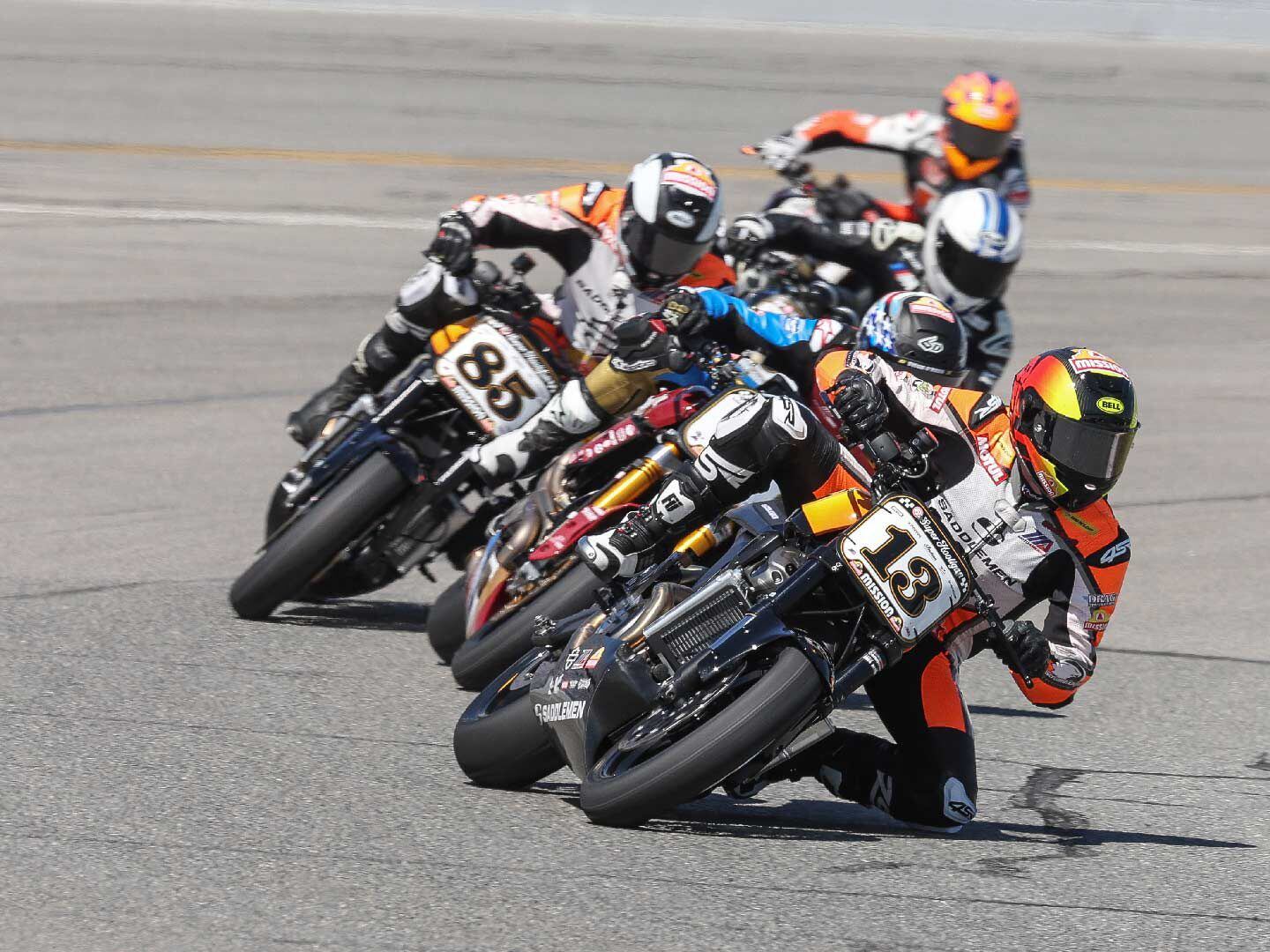
Harley-Davidson Factory Rider Kyle Wyman Snags Double Daytona Victories to Open 2024 King of the Baggers Race Season (Harley-Davidson/)Harley-Davidson Press Release:
Harley-Davidson® Factory Racing rider Kyle Wyman scored a Daytona double by winning the first two MotoAmerica Mission King of the Baggers races of the 2024 season at Daytona International Speedway in Daytona Beach, Florida. Harley-Davidson® Factory Racing rider James Rispoli finished in third place in both races. Wyman and Rispoli were aboard the team’s new race-prepared 2024 Road Glide® motorcycles.
Team Saddlemen rider Cory West rode a race-prepared Harley-Davidson® Pan America® 1250 Special motorcycle to victory and topped an all-Harley podium in the Mission Super Hooligan race on Saturday. Team Saddlemen rider Jake Lewis finished second, and Gator Harley/KWR rider Cody Wyman was third completing the sweep. West also finished in third place in the Super Hooligan race on Friday and leads the series points after two of 10 scheduled rounds.
The first King of the Baggers race on Friday saw a thundering pack of 17 bagger race motorcycles topping 185 mph on the high-banked oval portion of the 3.52-mile Daytona International Speedway road course. Wyman and Rispoli were part of a four-bike group that battled for the lead for the entire race and started the last of six laps separated by less than one second. Wyman had been quick through the backstraight chicane all race and on the last lap got a strong drive out of the final corner to pass Factory Indian rider Troy Herfoss for the lead heading onto the last section of the oval. Wyman had enough momentum to hold off Herfoss and Rispoli across the finish line with a 0.018 second advantage over Herfoss and 0.137 second over Rispoli. Defending King of the Baggers series champion Hayden Gillim finished fourth on the RevZilla/Vance & Hines Harley-Davidson Road Glide, 0.837 seconds behind Wyman.
“On that last lap we were just about parked, but I refused to pass to lead the race until the moment it counted,” said Wyman. “I saw a window coming out of the chicane and was just able to hold them off for the win.”
The second King of the Baggers race on Saturday saw Wyman, Rispoli, Herfoss, Gillim, and Factory Indian rider Tyler O’Hara break away from the pack early in the race and swap positions on each lap. On the final lap, Herfoss gapped Wyman on the back stretch but braked late and over-shot the entry to the chicane, giving Wyman an opportunity to pounce. Wyman again got a strong drive onto the last section of the high-bank oval and was able to out-run Herfoss to the finish by 0.137 seconds. Rispoli finished 1.518 seconds back in third place.
“I was in survival mode on the last lap,” said Wyman. “I lost my quick-shifter and I was going to be happy to finish second, but Herfoss gave me a chance and we made it work. Hats off to my entire Harley-Davidson crew for all their hard work this weekend.”
“What an unreal weekend,” said Rispoli. “There was so much nervousness before the races. So, it was a massive relief to get two podiums in my first weekend with the Factory Harley-Davidson team. I am so stoked for the entire team, and I know we will be a force for the future rounds.”
After 2 of 18 rounds in the 2024 MotoAmerica Mission King of the Baggers series Kyle Wyman leads with 50 points. Herfoss is second with 40 points, followed by Rispoli with 32 points and Gillim with 24 points.
Harley-Davidson® Factory Racing returns to action at the Red Bull Grand Prix of The Americas, April 12-13 at the Circuit of The Americas in Austin, Texas.
The Mission King of the Baggers series features race-prepared American V-Twin touring motorcycles. Harley-Davidson® Factory Racing Road Glide® motorcycles are powered by modified Screamin’ Eagle® Milwaukee-Eight® 131 Performance Crate Engines. The team bikes also feature upgraded suspension components, including Screamin’ Eagle/Öhlins Remote Reservoir Rear Shocks, plus competition exhaust, race tires and lightweight bodywork.
Harley-Davidson® Factory Racing is sponsored by Mission® Foods, Rockford Fosgate®, Brembo®, Öhlins®, Protolabs®, SYN3® lubricants, and Screamin’ Eagle® Performance Parts and Accessories.
MotoAmerica King of the Baggers Race Results – Daytona International Speedway Race 1
- Kyle Wyman (H-D) Harley-Davidson Factory Racing
- Troy Herfoss (Ind) S&S/Indian Motorcycle
- James Rispoli (H-D) Harley-Davidson Factory Racing
- Hayden Gillim (H-D) RevZilla/Vance & Hines Harley-Davidson
- Rocco Landers (H-D) RevZilla/Vance & Hines Harley-Davidson
- Kyle Ohnsorg (Ind) RydFast Racing
- Bobby Fong (Ind) SDI/Roland Sands Racing
- Travis Wyman (H-D) Saddleman/Harley-Davidson
- Max Flinders (Ind) Mad Monkey Motorsports
- Tyler O’Hara (Ind) S&S/Indian Motorcycle
MotoAmerica King of the Baggers Race Results – Daytona International Speedway Race 2
- Kyle Wyman (H-D) Harley-Davidson Factory Racing
- Troy Herfoss (Ind) S&S/Indian Motorcycle
- James Rispoli (H-D) Harley-Davidson Factory Racing
- Tyler O’Hara (Ind) S&S/Indian Motorcycle
- Hayden Gillim (H-D) RevZilla/Vance & Hines Harley-Davidson
- Kyle Ohnsorg (Ind) RydFast Racing
- Jake Lewis (H-D) Saddleman/Harley-Davidson
- Cory West (H-D) Saddleman/Harley-Davidson
- Travis Wyman (H-D) Saddleman/Harley-Davidson
- Rocco Landers (H-D) RevZilla/Vance & Hines Harley-Davidson
- Max Flinders (Ind) Mad Monkey Motorsports
- Jesse Janisch (H-D) Suburban Motors H-D/Slyfox/Trask Performance
- Zachary Schumacher (H-D) Nowaskey Extreme Performance
- Gunnar Ouellette (H-D) Trask Performance
- Ruben Xaus (H-D) Feuling Parts
-
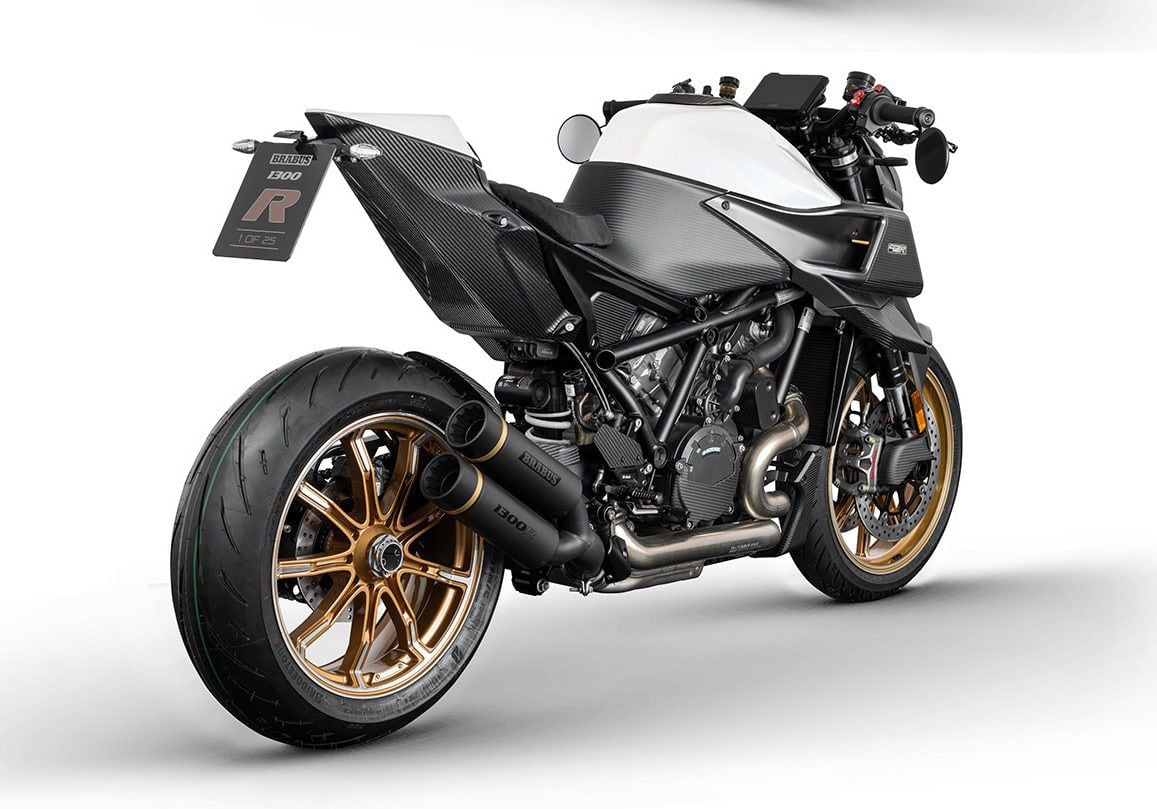
The Brabus and KTM collaboration continues with an upcoming trio of models similar to the 1300 R Masterpiece Edition seen here. (Brabus/)Brabus has been a name synonymous with modified Mercedes since the late ‘70s but made the leap to two wheels with the Brabus 1300 R in 2022 and has found there’s plenty of customers prepared to pay high prices for a Brabus-branded bike. Now the company has filed three trademark applications for new Brabus 1400 R models—essentially confirming its collaboration with KTM is set to extend with more Super Duke–based bikes.
The original Brabus 1300 R was based on the KTM 1290 Super Duke Evo, adopting its engine and chassis (unaltered) and wrapping them in distinct styling that included a round headlight borrowed from Husqvarna. The first generation was made in a limited run of 154 bikes (77 in red and 77 in black) to mark the company’s foundation in 1977. Despite a price equivalent to nearly $45,000 and no performance advantage over the $19,000 Super Duke Evo it was based on, all 154 were sold within two minutes of the order book opening.
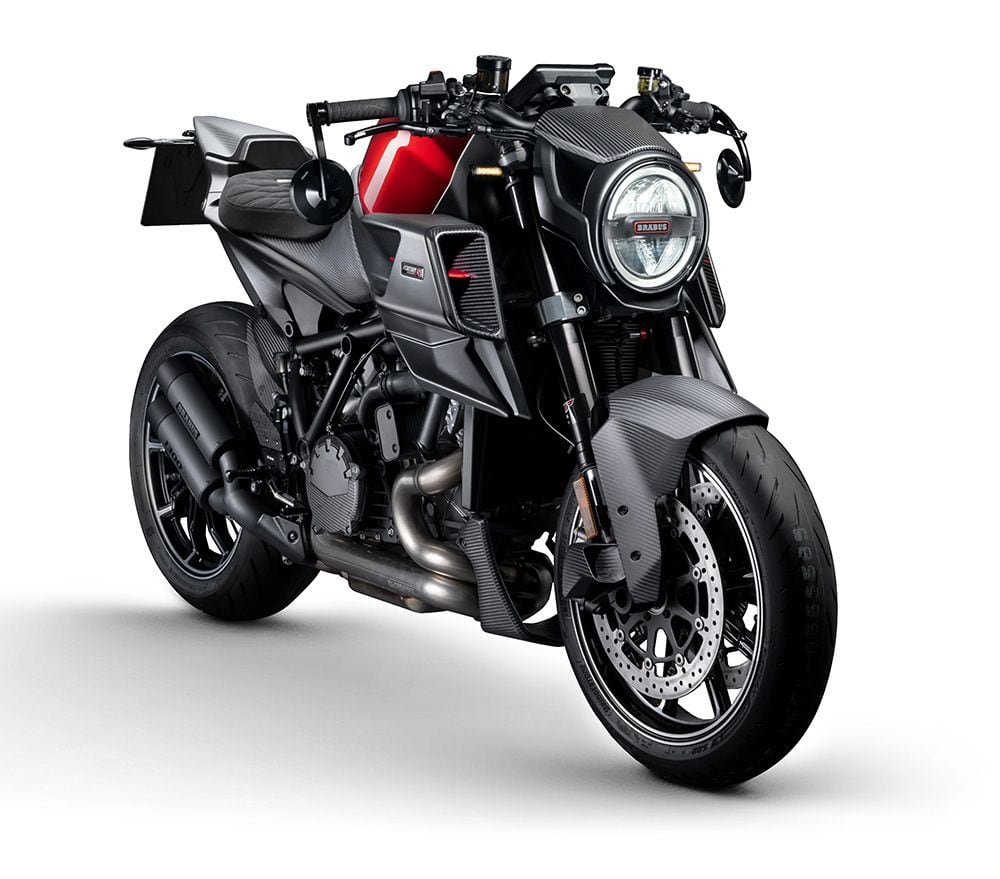
The original Brabus 1300 R. (Brabus/)Unsurprising, then, that Brabus added a second-generation version of the bike in 2023, the 1300 R Edition 23, with production increased to 290 examples. Again, these were split 50/50 between two colors, Superblack and Stealth Gray, and there were tweaks to the styling including a new headlight cowl and air intakes. Once again, they were snapped up fast, and Brabus launched the third version, the 1300 R Masterpiece Edition, just a few months later. This was more exclusive with just 50 made, 25 in white and 25 in black, and Brabus promised it was the last in the line.
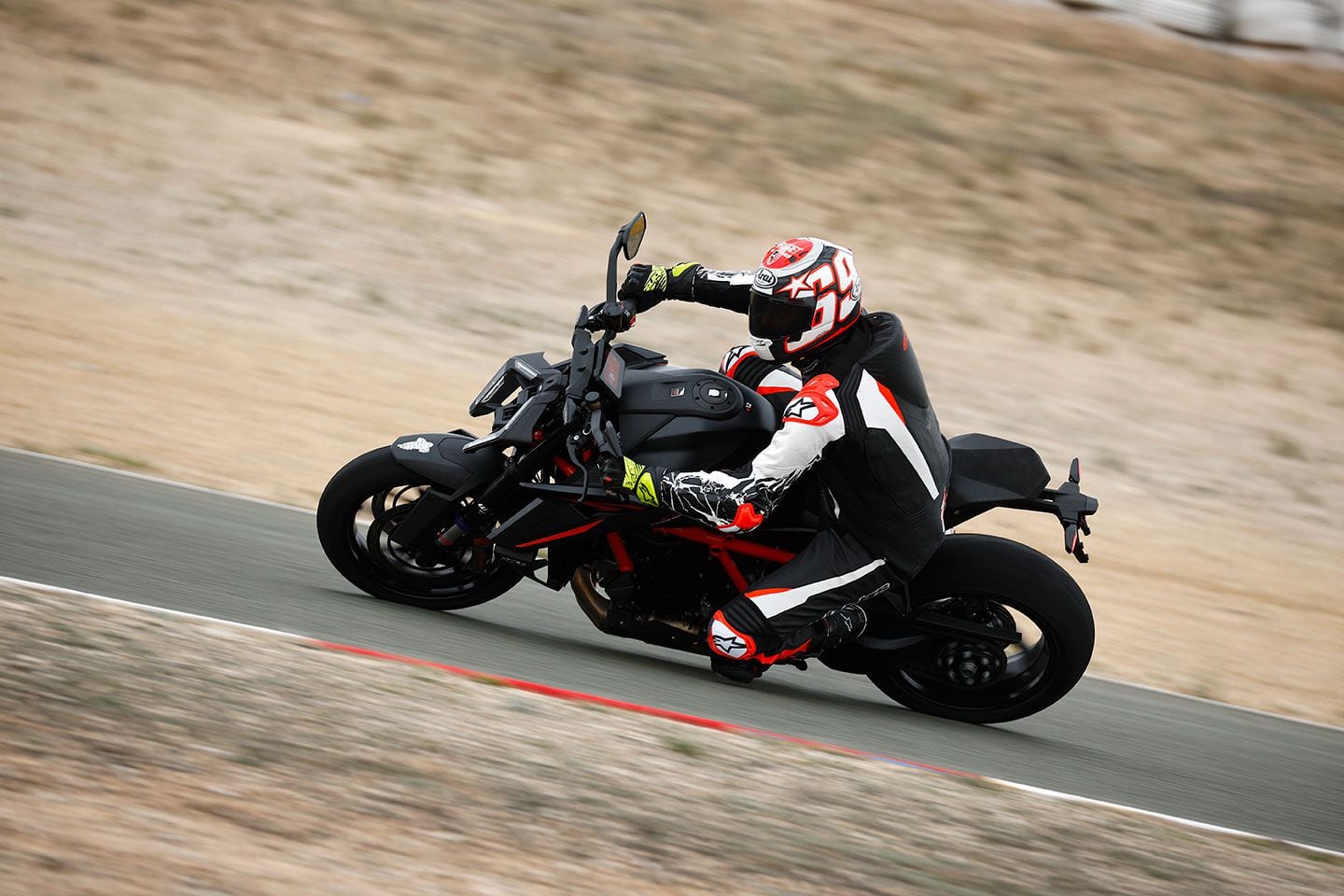
The latest Brabus is based on KTM’s new-for-2024 1390 Super Duke. (KTM/)Now, of course, the KTM 1290 Super Duke is gone, replaced for 2024 by the 1390 Super Duke, so there’s scope for Brabus to do it all over again with a line of bikes using the updated 1,350cc LC8 V-twin engine from the new model. Complete with a shiftcam-style variable valve timing and lift system, the new motor puts out a claimed 190 hp at 10,000 rpm and 107 lb.-ft. at 8,000 rpm, up from 177 hp and 103 lb.-ft.
That engine, along with the latest Super Duke Evo’s chassis, suspension, and brakes, is sure to be the underpinnings of the new generation of Brabus bikes. The three trademark applications filed so far suggest that Brabus might be looking at the same idea as before, of offering three separate runs of bikes. The first trademark is for the name Brabus 1300 R Rocket. “Rocket” is a title that Brabus already applies to some of its limited-edition, high-end Mercedes cars so it’s a logical way to connect the two- and four-wheeled output of the brand. We’ve already seen with the Ducati Streetfighter Lamborghini and Diavel for Bentley limited-edition bikes that there’s an appetite from collectors to buy bikes that match their high-end automobiles. But it’s not hard to imagine that Triumph, which already sells bikes using the name Rocket, might object to Brabus’ plans to make a Rocket-branded motorcycle. We’ll have to wait and see whether the trademark application gets approved.
The second trademark application is for the term “Brabus 1400 R Signature.” Again, Brabus already uses the term “Signature” on its existing output, but for its range of high-end boats rather than its cars. Nothing says you’ve got money to spare more than an exotic boat, except perhaps having a matching motorcycle to go with it.
Finally, at least for the moment, there’s the trademark application for the title “Brabus 1400 Tailor Made.” The Tailor Made name digs back into the past for Brabus, as the company made a line of expensive, modified versions of the Smart ForTwo minicar under the same branding back in 2010.
-
 1
1
-
-
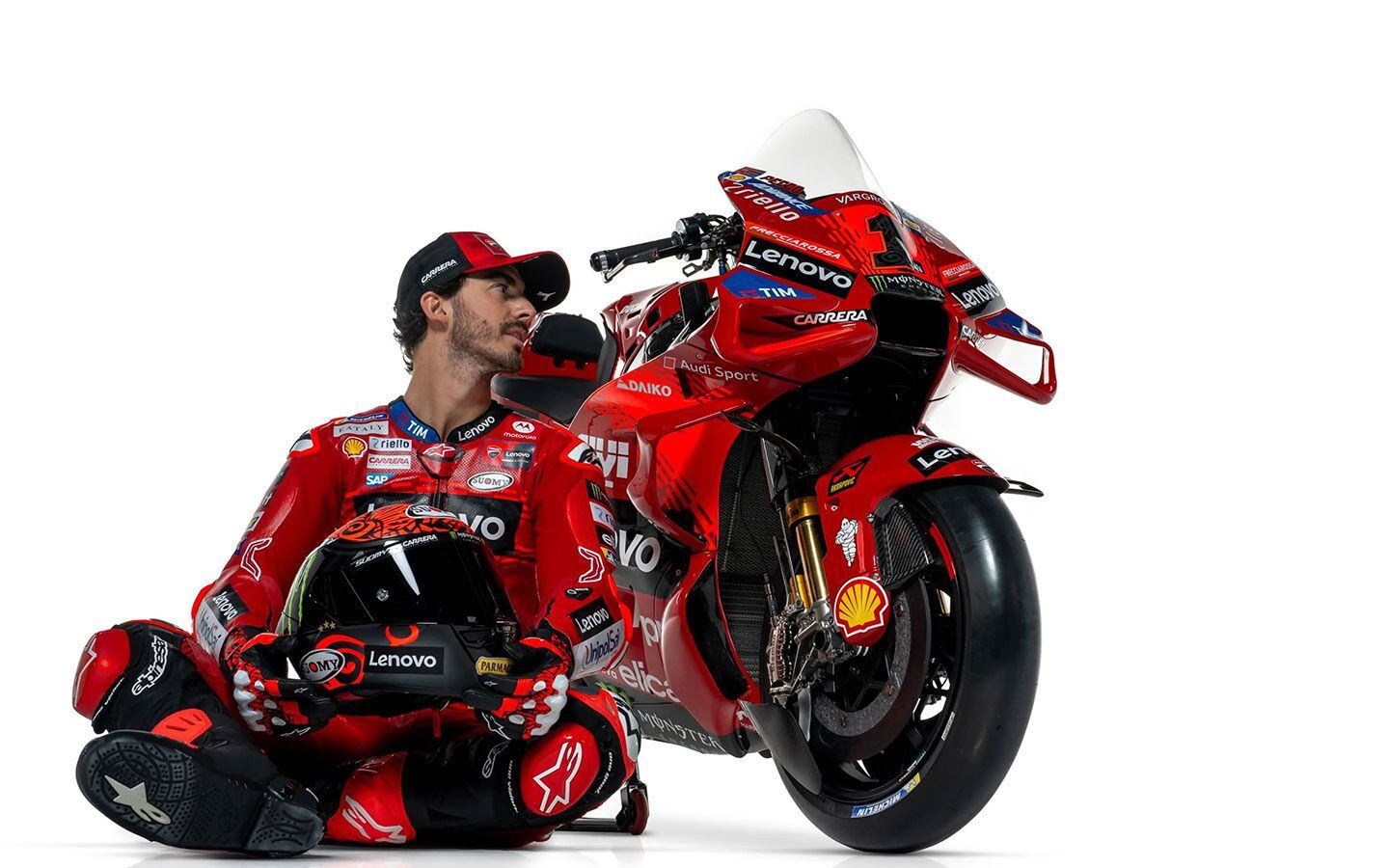
Marco Melandri says current two-time MotoGP champ Pecco Bagnaia is his pick for the winner in 2024. (MotoGP/)The 2024 MotoGP season kicks off this weekend in Qatar with some fixed points and many question marks. Pecco Bagnaia is the clear favorite, but there is a lot to look forward to in 2024. There is no doubt that the debut of Marc Márquez on the Italian bike will reshuffle the cards. This is the biggest storyline to keep an eye on, but who is the underdog or which teammate drama is most likely to explode? Looking at the manufacturers, KTM is closing the gap on Ducati, and Aprilia is stronger than last year; Honda and Yamaha are determined to return to their golden eras.
We asked former MotoGP rider Marco Melandri to make an analysis of the 2024 MotoGP grid. In his career, he rode for Aprilia in the 250cc championship, and Honda and Ducati in MotoGP. He has commented on MotoGP for Spanish broadcaster DAZN; nowadays he follows MotoGP, but also enjoys his other two passions: electric mountain bike racing and playing music as a DJ in cool places.
The Man to Beat
“Ducati factory rider Pecco Bagnaia takes the start as the man to beat, I see him even stronger than in the past 2022 and 2023 seasons. Mentally, he seems fully recovered from the difficult crash he suffered in Barcelona last year. He is mature and aware of his two titles. When he is on the bike, he seems to have everything under control. The recent renewal of his contract with Ducati for two more seasons (2025–2026) gives an extra boost of confidence and allows him to be fully focused on the current season.”
Related: MotoGP’s Latest Race Team: Trackhouse Racing
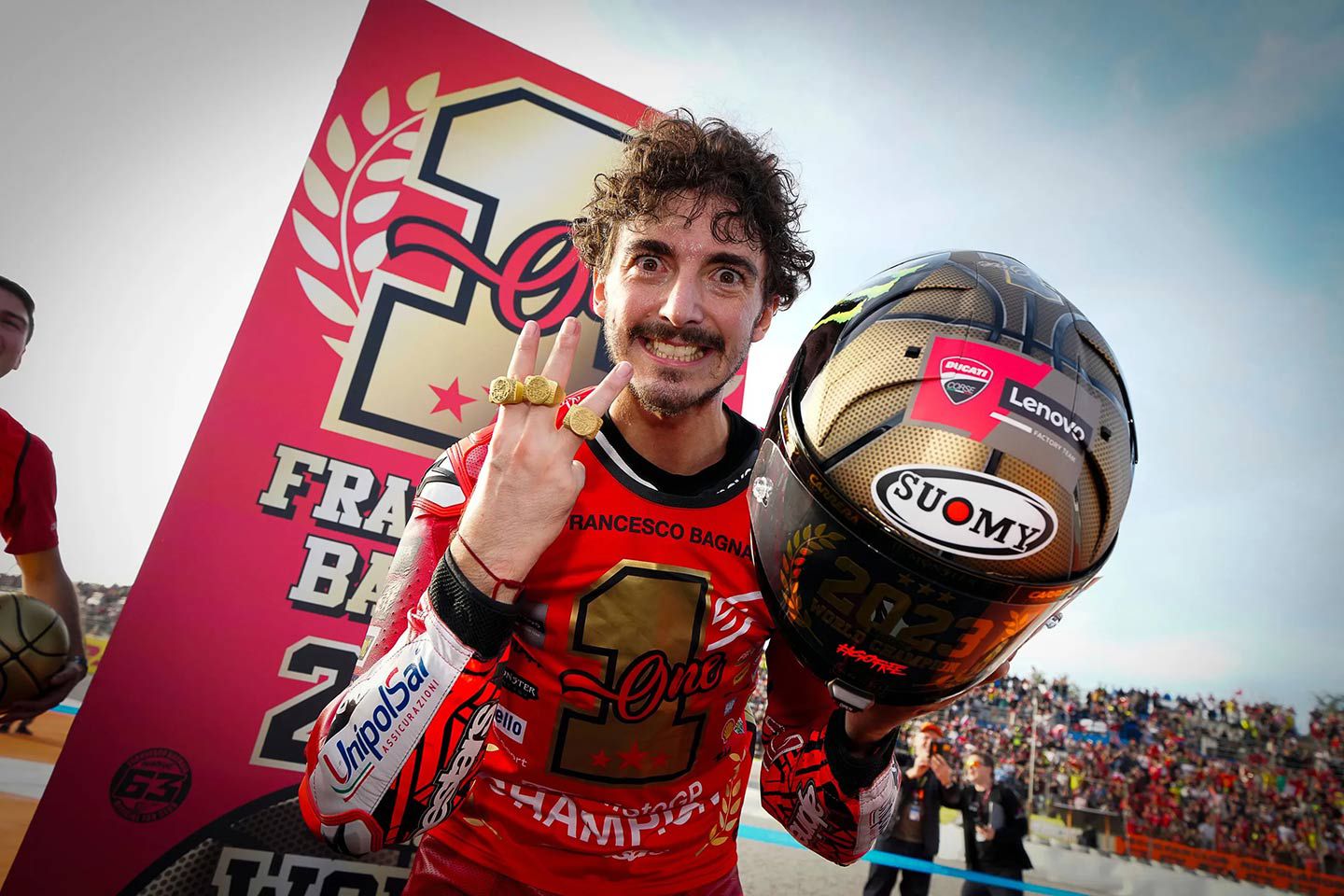
Will Bagnaia make it a three-peat in MotoGP and add a fourth ring to his collection? (MotoGP/)The Number One Rival
“I see Pecco’s most dangerous rival in Enea Bastianini. Last year was a season to forget for him, but already in the winter test we saw that the 2024 Ducati suits him very well. This season could be his year.”
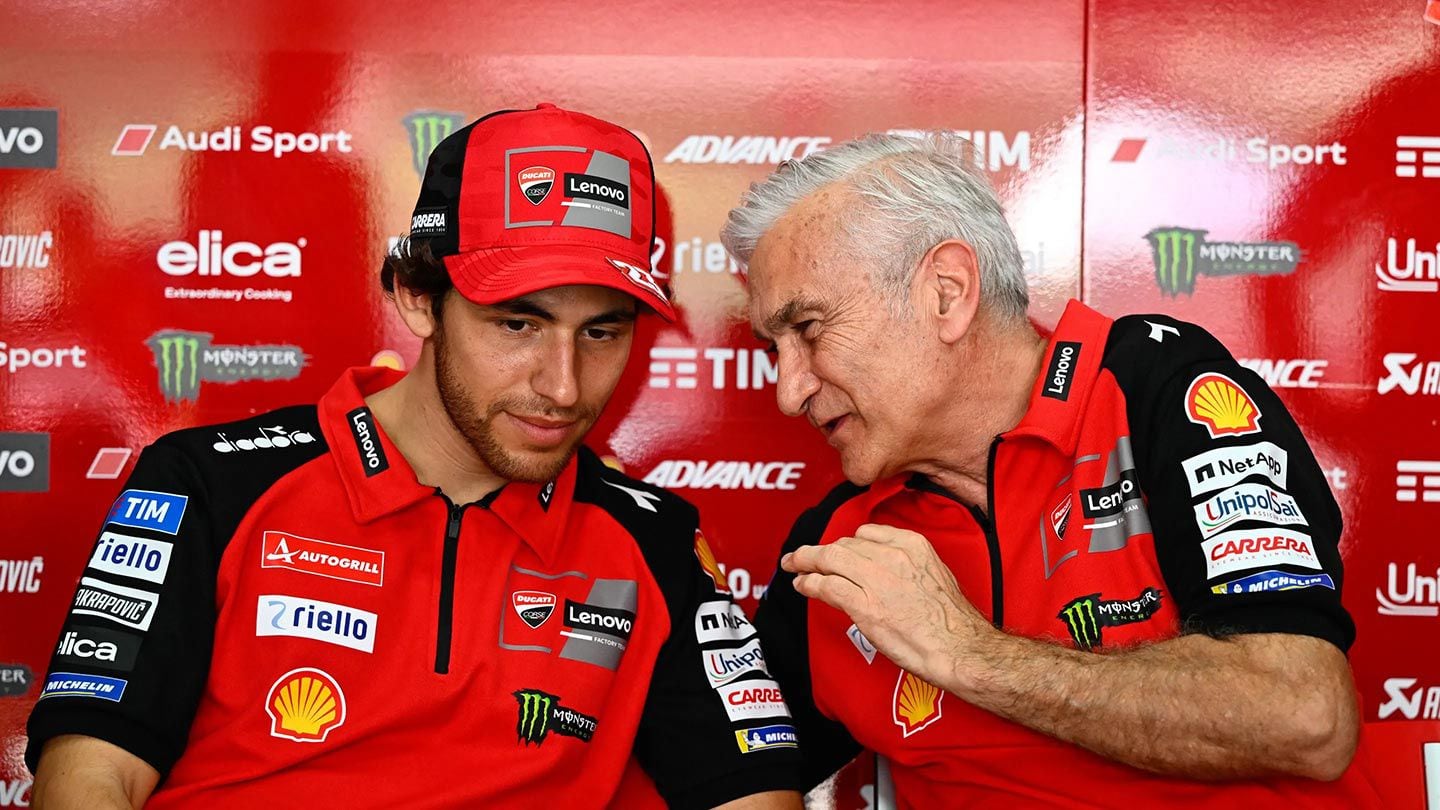
Enea Bastianini looked good in the winter test; he might be Bagnaia’s biggest rival. (MotoGP/)The Other Side of the Red Army
“It won’t be an easy season for Jorge Martín. After his incredible fight for the title and the second position in championship, he expected a promotion in the Ducati factory team. this hasn’t happened so I smell a lot of frustration. Despite there was a moment last year when he was the fastest rider, he has realized that he cannot aim to win the title in a satellite team. Jorge has the speed and I think he gets along very well with the Pramac team, but I feel a separation in the air. I think he will leave Pramac at the end of the season for the Ducati factory team or another manufacturer.”
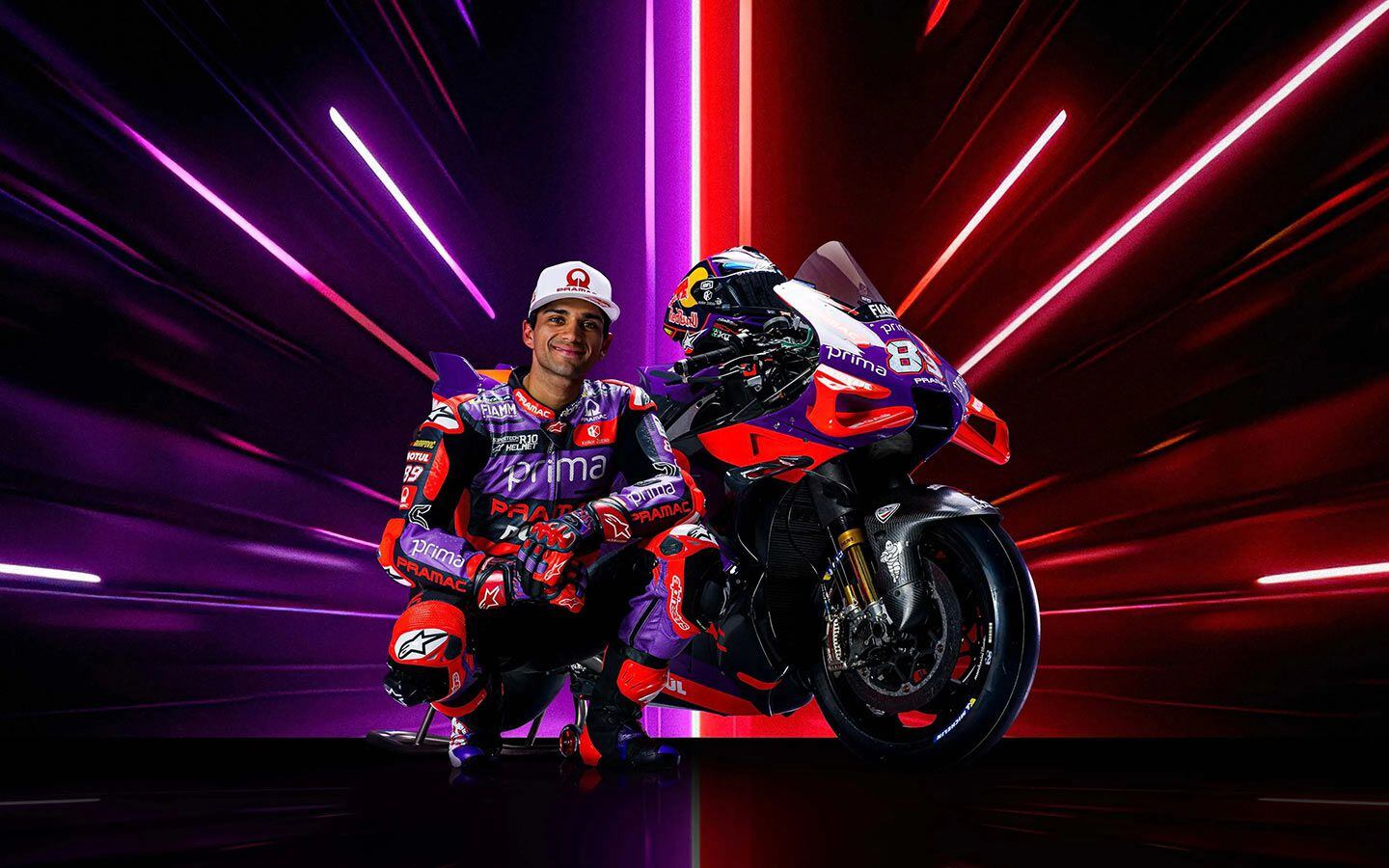
Jorge Martín will be in the fight, but it is difficult to win on a satellite team. (MotoGP/)Márquez on Ducati
“Marc Márquez did so well in the Valencia test that he seemed ready to win. We need to consider that historically he is unbeatable in Valencia, Austin, and Sachsenring, so his debut on the Ducati was really impressive. At winter tests in Malaysia and Qatar we could see the bigger picture: Marc is still riding the Ducati as a Honda. The concept of these two bikes are diametrically opposed. The Ducati has so much grip that you need to use the rear also when entering the corner. Honda is the opposite, everything is about the front, and you ride it with the front.”
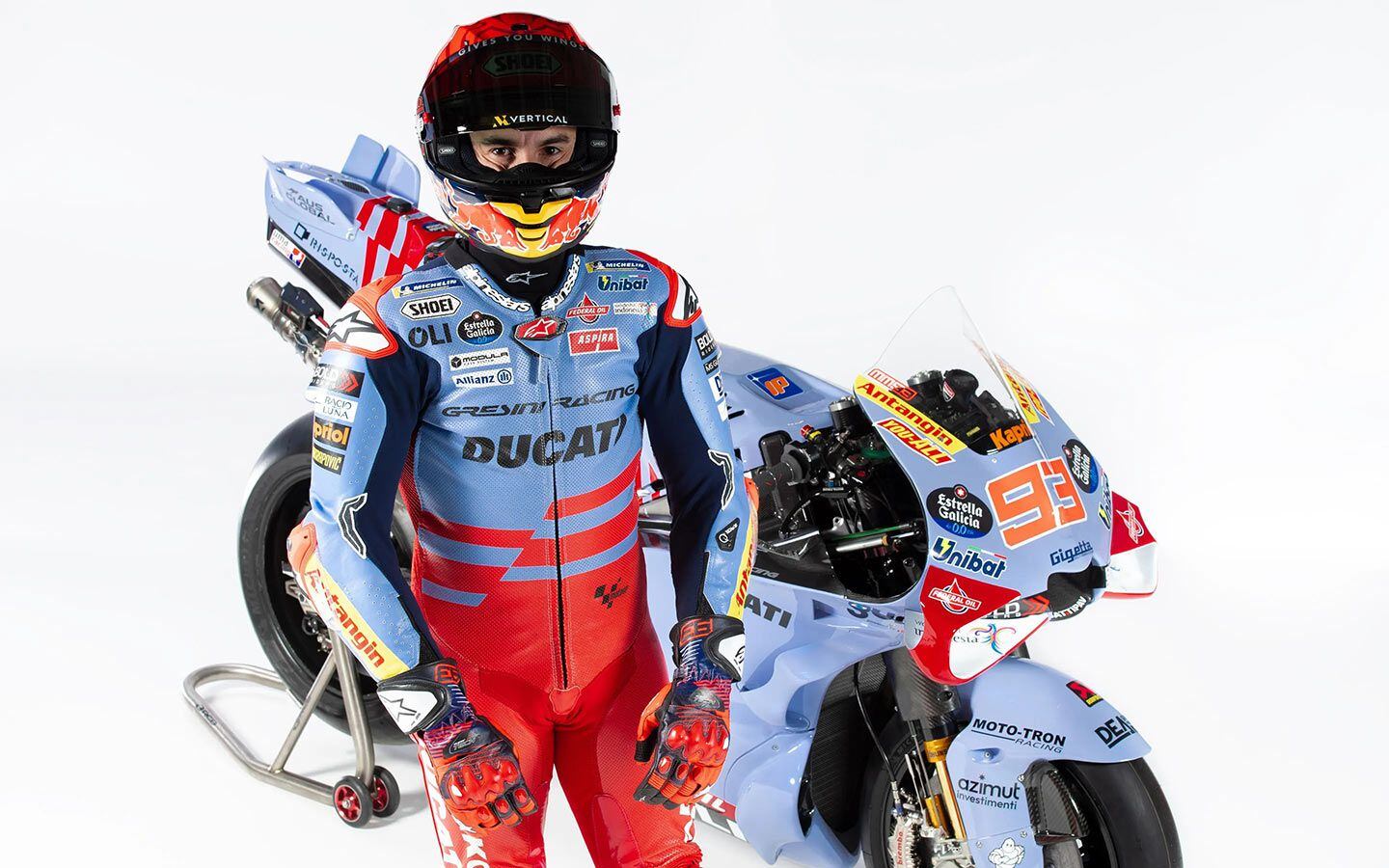
Marc Márquez impressed in Valencia on the Ducati, but the true answer to his success will come this weekend. (MotoGP/)Dark Horses to Keep an Eye On
“Fabio Di Giannantonio is living a magic momentum: He finished the season very well and he has started the new one in the same way. He is joining the VR46 team alongside Marco Bezzecchi. In 2023 Bezz had an incredible start to the season, then he struggled more. Bezz and Digia make a nice duo, they can win some races.”
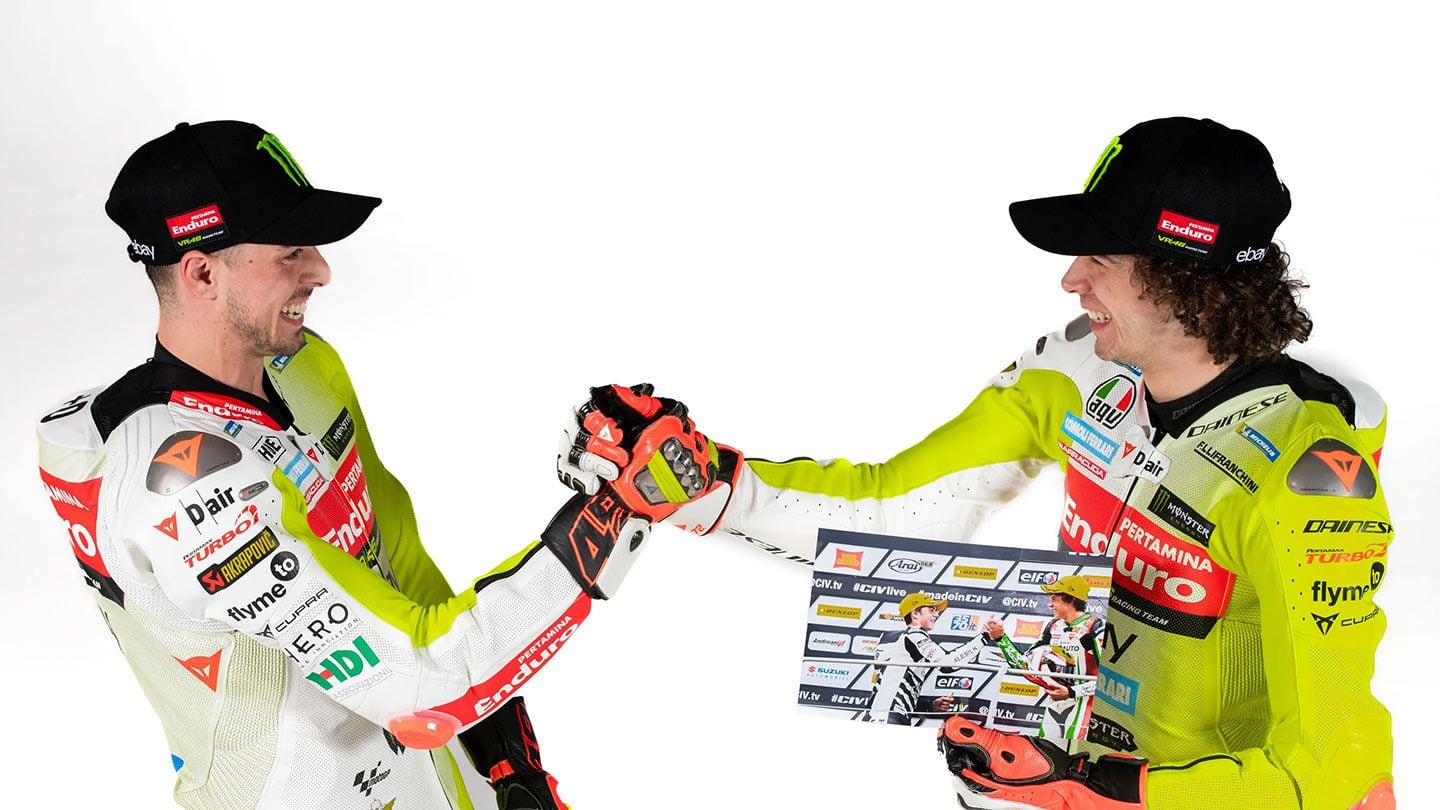
Melandri says Fabio Di Giannantonio and Marco Bezzechi make a great team. (MotoGP/)“I would also keep an eye on Pedro Acosta. He is the most talented rookie since Marc Márquez entered the class. He is fast but he needs to gain experience. I think that he is not prepared when some technical issues arise.”
KTM and Aprilia
“I think KTM is the only manufacturer that can seriously challenge Ducati. [Brad] Binder is very strong, but he is not so consistent. [Jack] Miller is fast, but only for some laps. Aprilia has improved and they can win some races, but there are too many ups and downs. More consistency is needed, both on the side of the technical package and the riders.”
Related: Aprilia Racing Bosses Talk 2024 MotoGP Season
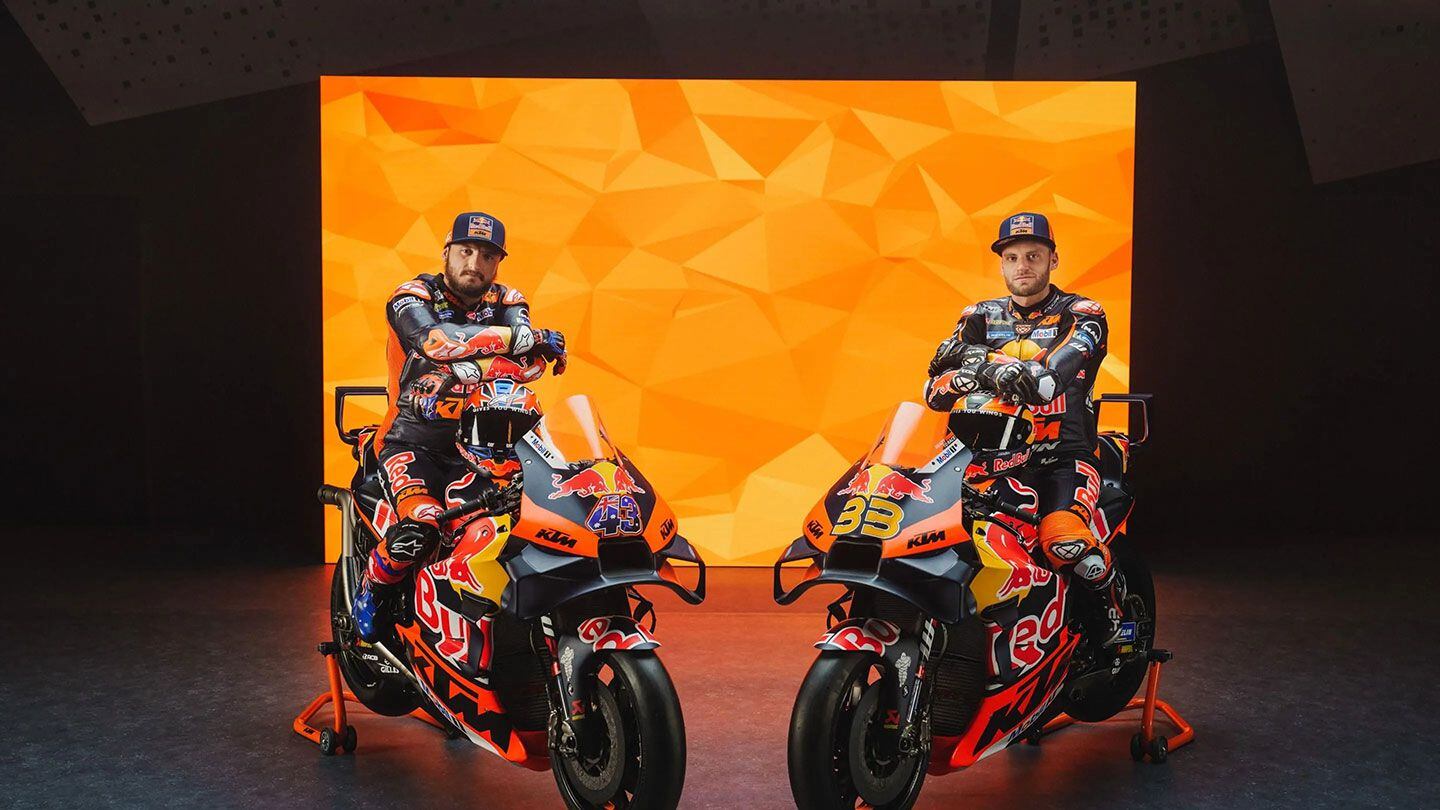
Red Bull KTM is one of the stronger rivals to the Ducati machine. (MotoGP/)Honda
“They will make progress with the new development opportunities available to them by the concessions. The question is how long it will take. Honda worked hard in the winter and built a machine that looks very different; bigger and longer. They are determined to return competitively. They lost Márquez, but lining up not the fastest guy could turn positive. It can be an extra motivation to work harder. Honda HRC have reacted very promptly. I think they made the right choice signing Luca Marini. His future in Ducati was not so bright so it was a great occasion also for him. Luca is very precise in his technical feedback and will race alongside [Joan] Mir. I have always liked Joan a lot. I hope that these last difficult years with Honda and the frustrations haven’t affected him too much.”
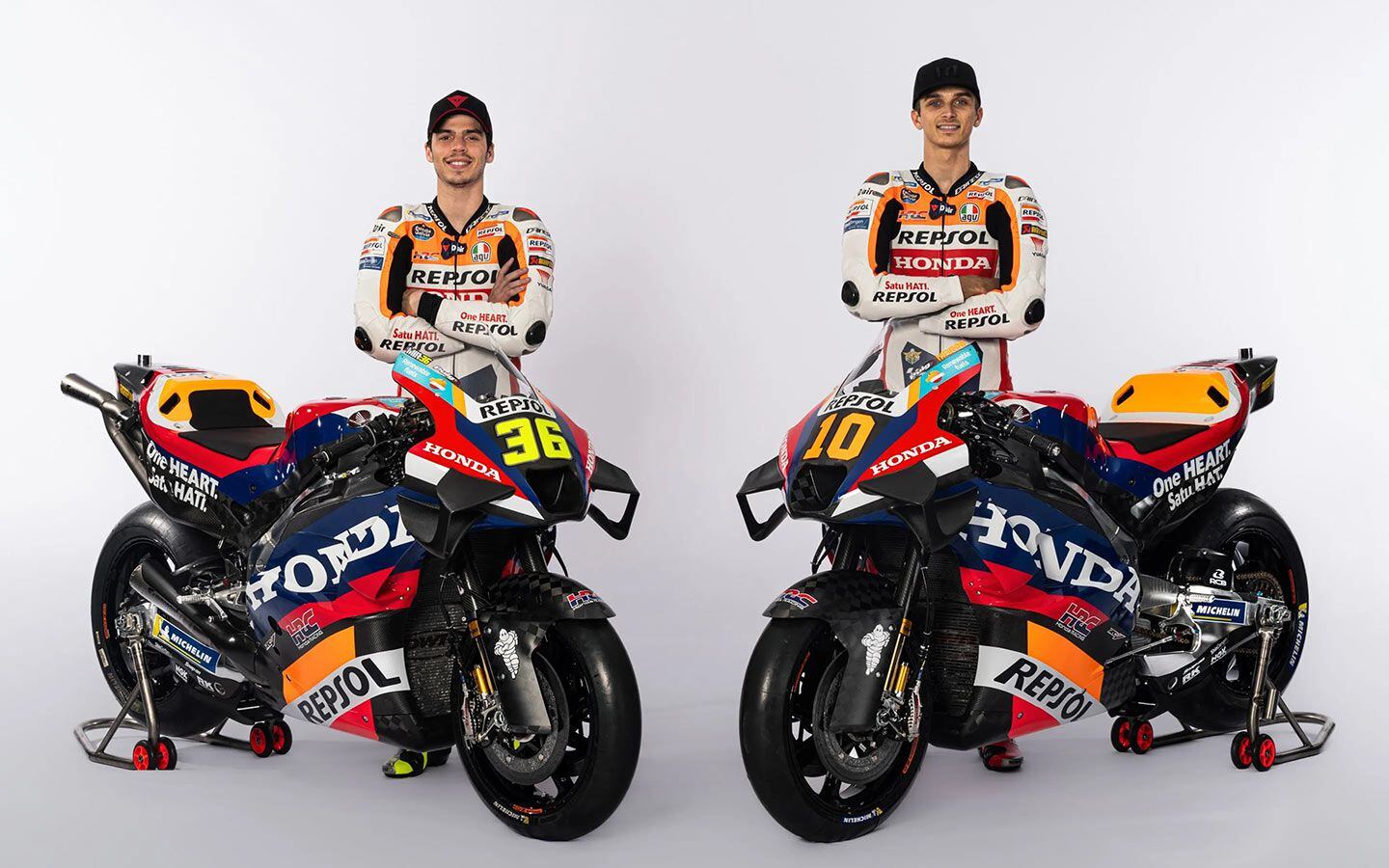
Joan Mir and Luca Marini along with all of HRC have extra motivation to get the Honda to the front. (MotoGP/)Yamaha
“Fabio Quartararo is one of the strongest guys on the grid, but I think Yamaha is still too conservative. I see them too focused on two areas: the maximum power and the grip on the rear. This risks affecting what have always been Yamaha’s strengths: an agile machine and the closing of the corner.”
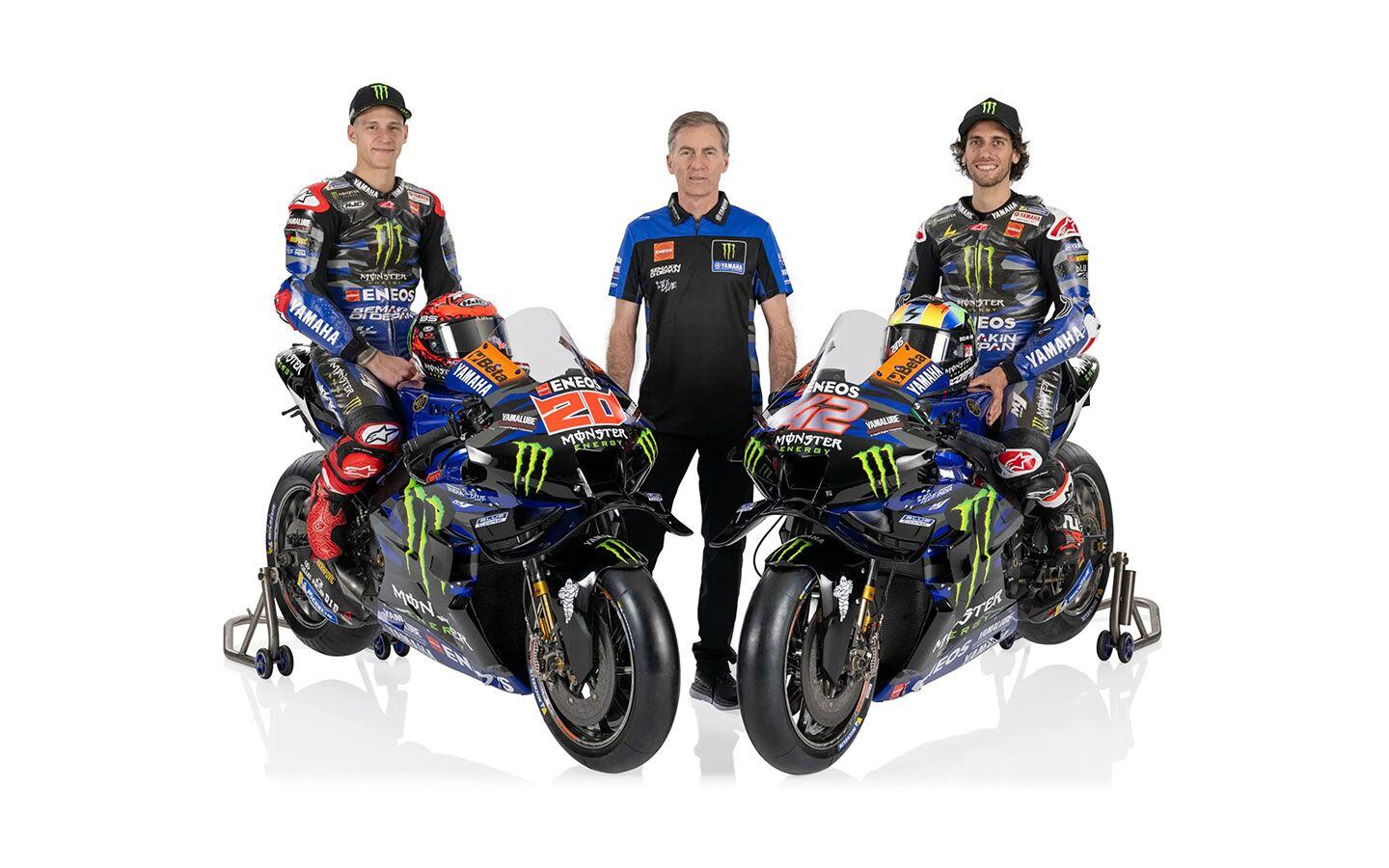
Is Yamaha too focused on power and rear grip at the expense of agility? (MotoGP/)The 2024 Title
“Pecco Bagnaia is the clear favorite, but I see in the title fight also Marc Márquez, Enea Bastianini, Jorge Martín, and Brad Binder.”
2024 Qatar Podium
“I would say Bastianini, Bagnaia, Binder. In this order? Why not! I see Enea particularly strong at Losail.”
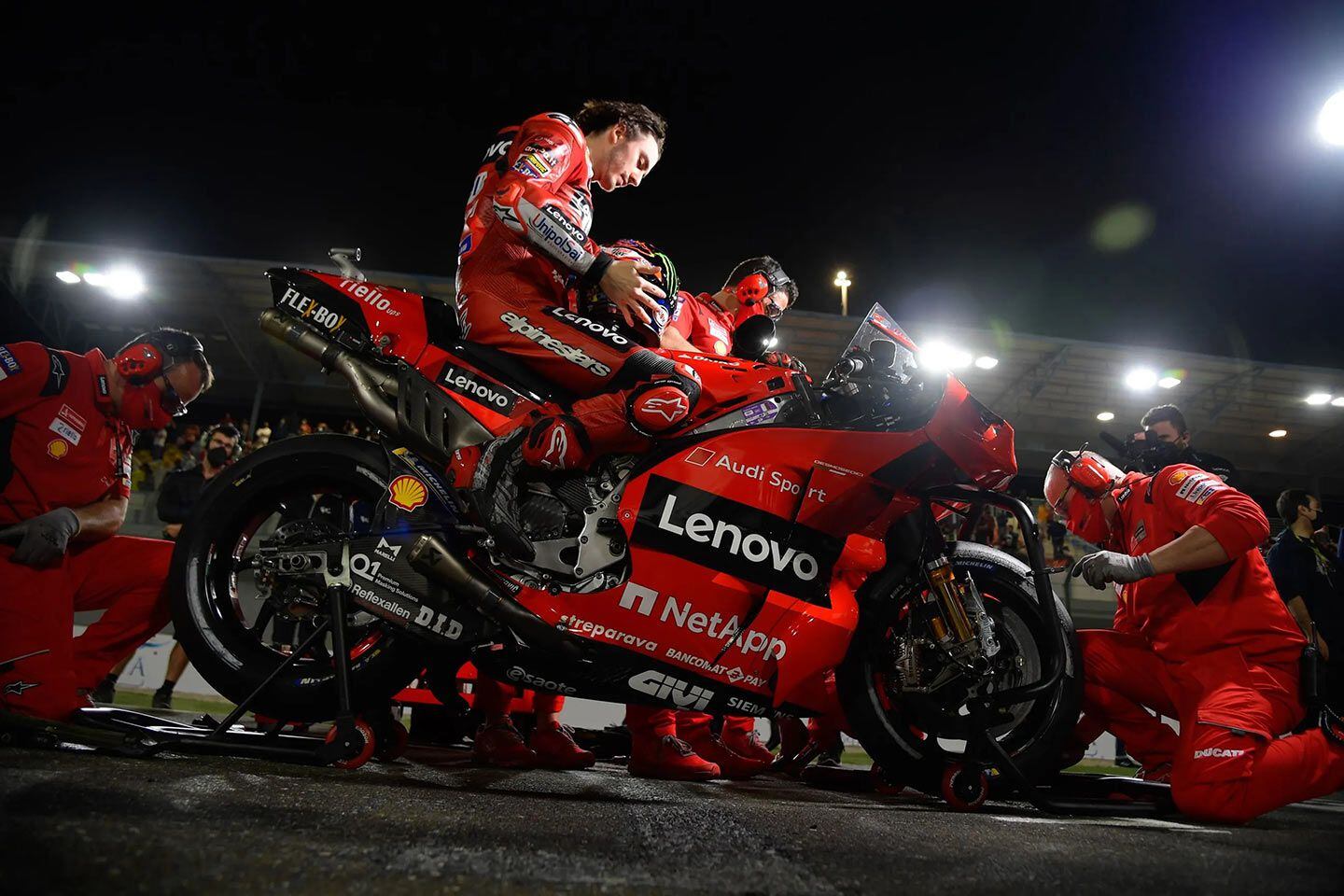
It’s clear Bagnaia is the favorite in 2024, but his competition and even his teammate will not make it easy for him. (MotoGP/) -
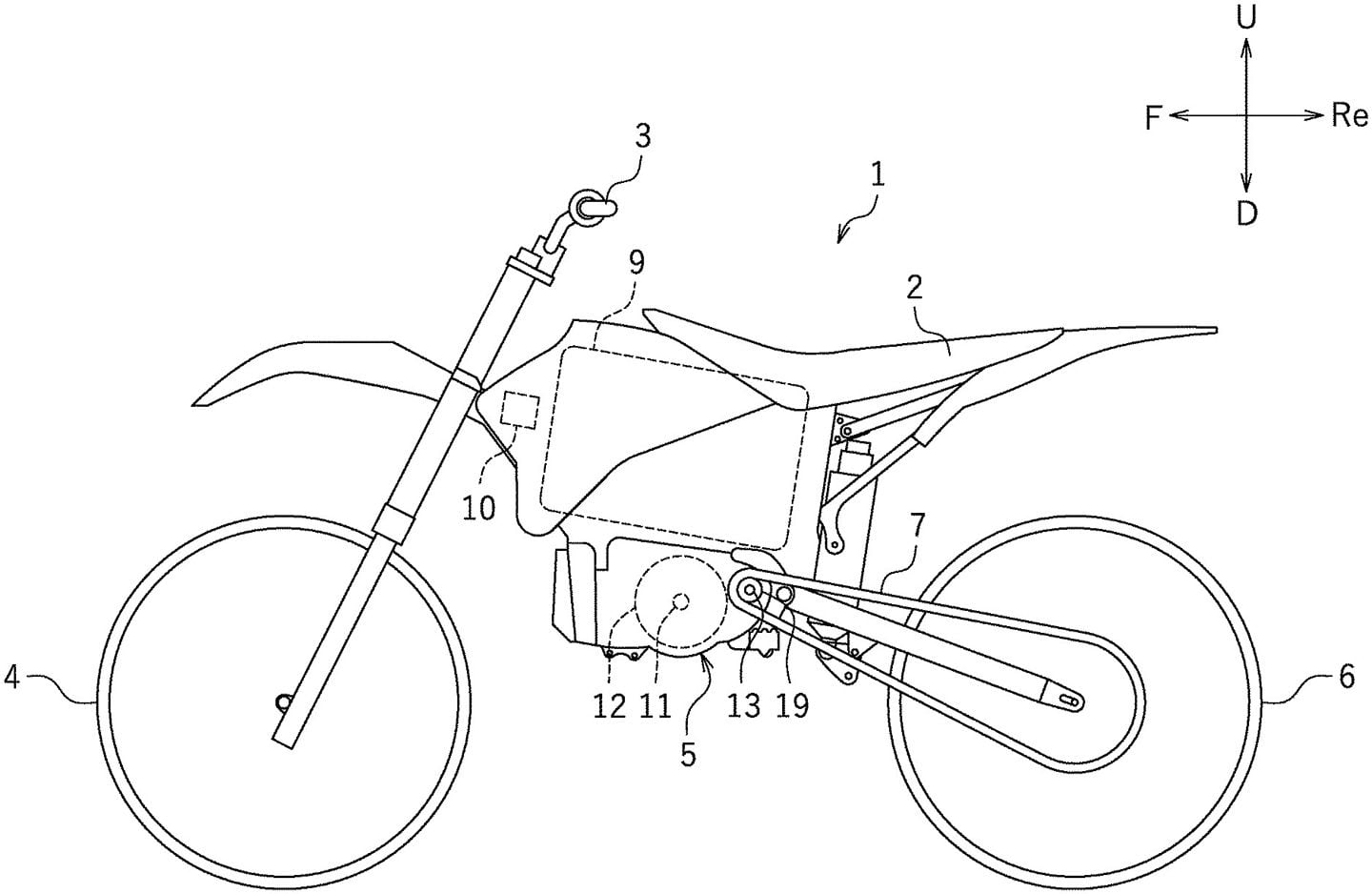
Although visually simple, Yamaha has filed patents that detail work it is doing on an electric motocross bike, which has some unique features. (Yamaha/)Of all the use cases for electric motorcycles in competition, it’s motocross that arguably makes the most sense. Relatively short races mean you’re not hamstrung by huge batteries and the silence and lack of emissions open the door to bringing the sport to urban or indoor environments. Honda is already competing head-to-head with gas-powered MXers using its CR Electric Proto racer, with Trey Canard behind the bars. Now there’s a clue that Yamaha is heading in the same direction as it files patents for an electric motocross powertrain.
Yamaha is already forging ahead with electric competition bikes in the field of trials riding, using its TY-E 2.1 in competition against conventional rivals, and the company is now working on ways to translate the technology to motocross.
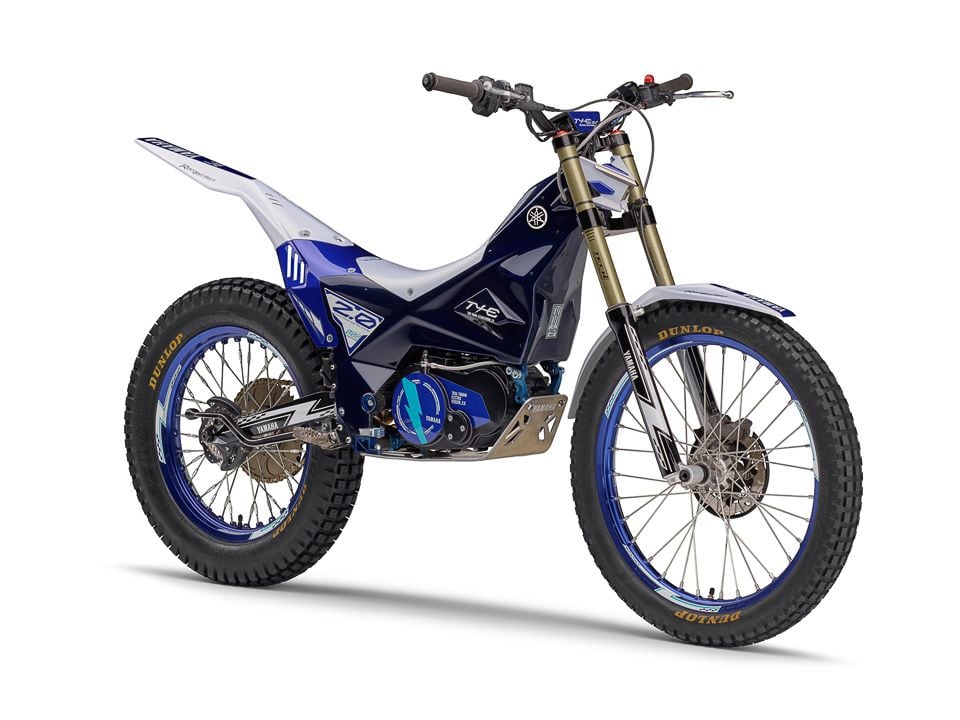
Yamaha’s TY-E electric trials motorcycle. (Yamaha/)A new patent application from Yamaha specifically relates to a motocross bike and specifically explains how the transmission could be designed to improve traction and amplify torque to suit competition use. Yamaha faced a similar problem with the TY-E trials bike. While electric motors are renowned for their ability to provide maximum torque at zero revs, Yamaha found that a conventional direct drive between the motor and rear wheel wasn’t ideal for trials riding. It needed even more instant torque than the motor could provide and more control for the rider, so opted to add a flywheel and a conventional clutch. In trials riding, the design means riders can keep the motor and flywheel spinning with the clutch disengaged, improving low-speed balance and letting them unleash instant punches of performance by dropping the clutch and using the power stored in the flywheel.
For a motocross bike, that solution isn’t ideal—it adds size and weight to the powertrain—but Yamaha is looking for a solution to provide an extra thump of torque when needed. It’s also looking to improve the throttle feeling and has come up with a solution that incorporates a torsion damper into the transmission.
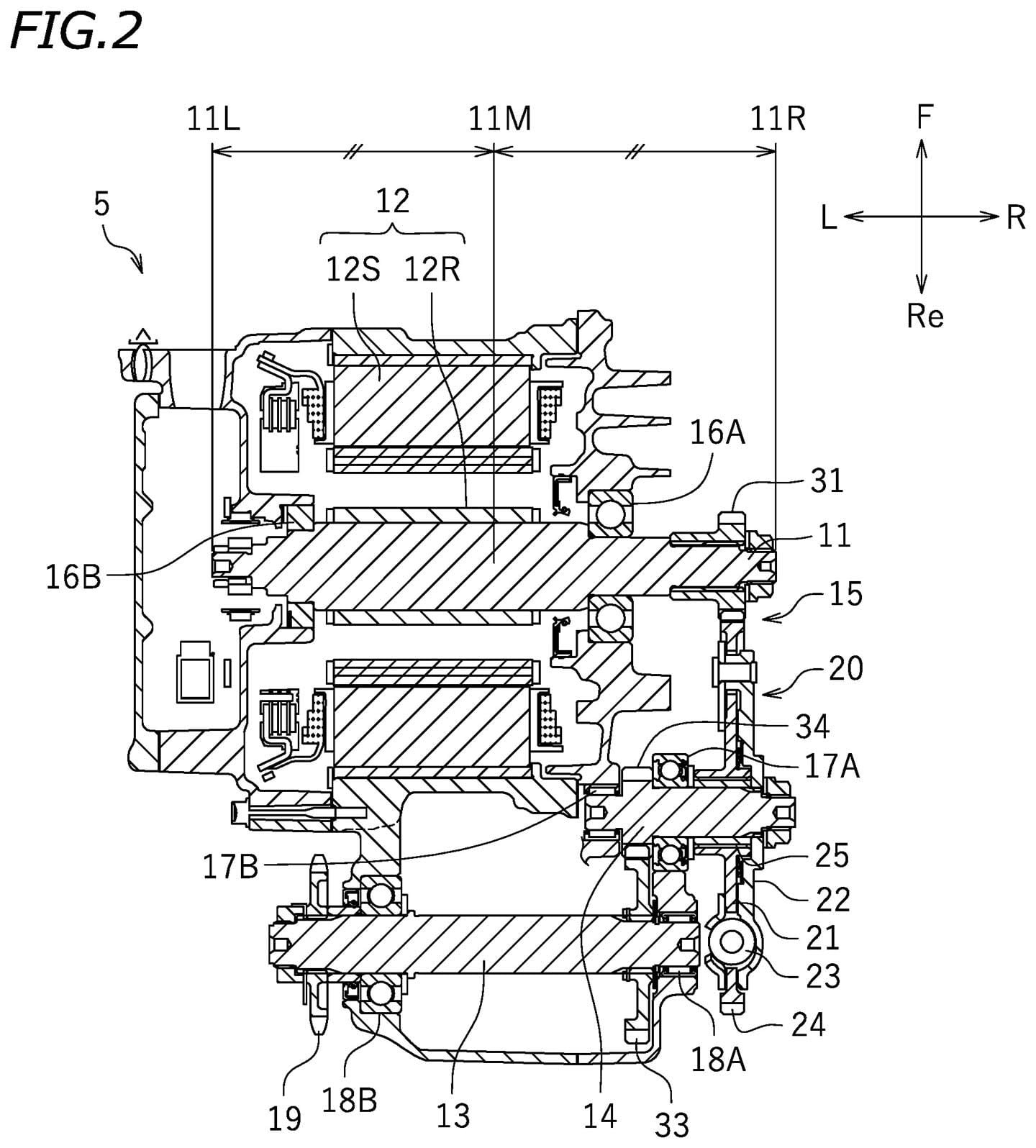
The electric MXer patents focus on its transmission that utilizes a clutch and flywheel to control power, unlike many EVs direct drive drivetrains. (Yamaha/)The torsion damper is made up of two rotors mounted coaxially and connected to each other using springs. The input from the electric motor goes to the first rotor, the output to the transmission comes from the second rotor, so those springs provide an element of insulation between changes of speed of the motor and those at the transmission and rear wheel. They also work as energy stores—open the throttle rapidly, or close it and then quickly open it again, and the springs compress, storing energy, and then release it again to provide a brief punch of extra force at the rear wheel. It’s a system that’s lighter and more compact than the flywheel setup used on the TY-E while retaining some of the same benefits.
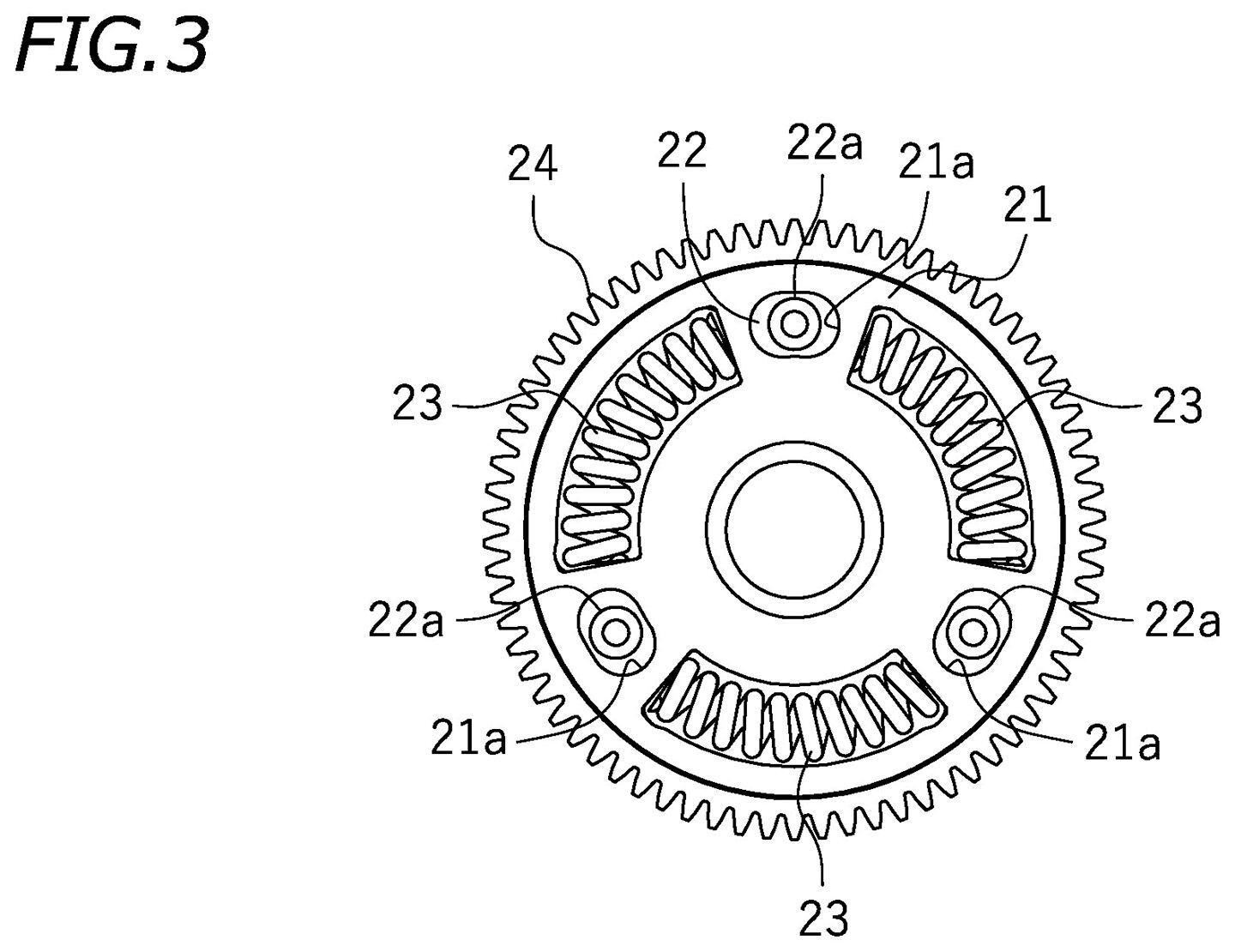
A closer look at some of the transmission pieces and the springs that help smooth delivery and store energy for quick bursts of acceleration. (Yamaha/)What the patent shows is that as we move toward electric powertrains there will be a range of different solutions to adapt the technology to specific use cases. The clutch and flywheel energy store of the TY-E is tailor made for trials, the torsion damper suggested here has potential benefits in motocross.
While the illustrations in the patent are simplistic, they also give a hint as to the design Yamaha might be considering for its electric MXer. The TY-E already uses a carbon fiber monocoque chassis to house its battery, and it looks like the motocross bike might be following a similar route—there’s no conventional frame to be seen, just a boxlike battery case that makes up the main bulk of the bike and provides mounting points for the seat subframe and rear shock. Below it, the motor and transmission layout are like those of the TY-E, albeit without the flywheel and clutch. Although there’s no official announcement yet, and a patent is not conclusive proof that a project will reach production, don’t be surprised if Yamaha reveals an electric motocross prototype project in the coming months.
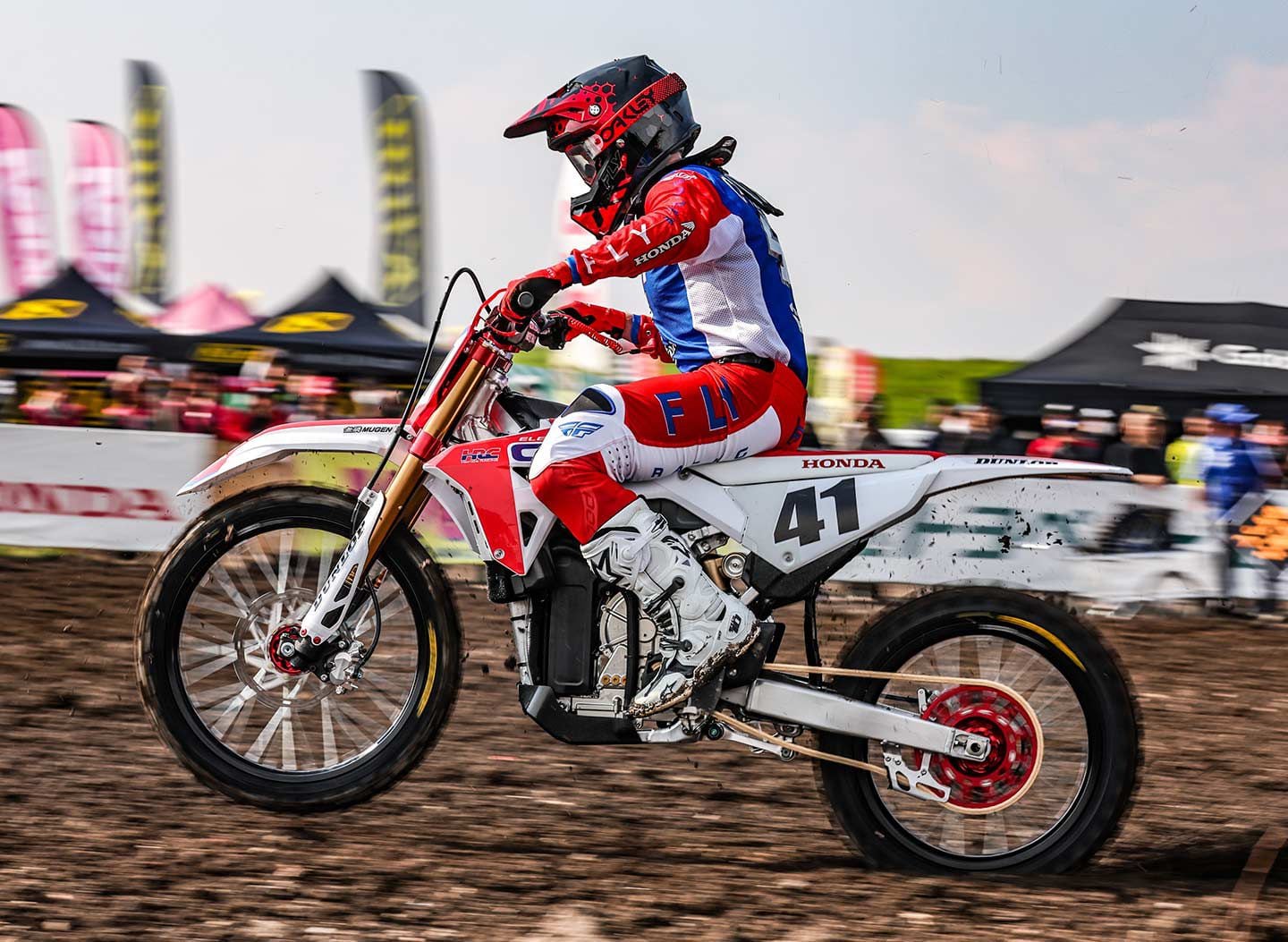
Trey Canard has been developing and racing Honda’s CR Electric Proto racer. (Honda/)-
 1
1
-
-
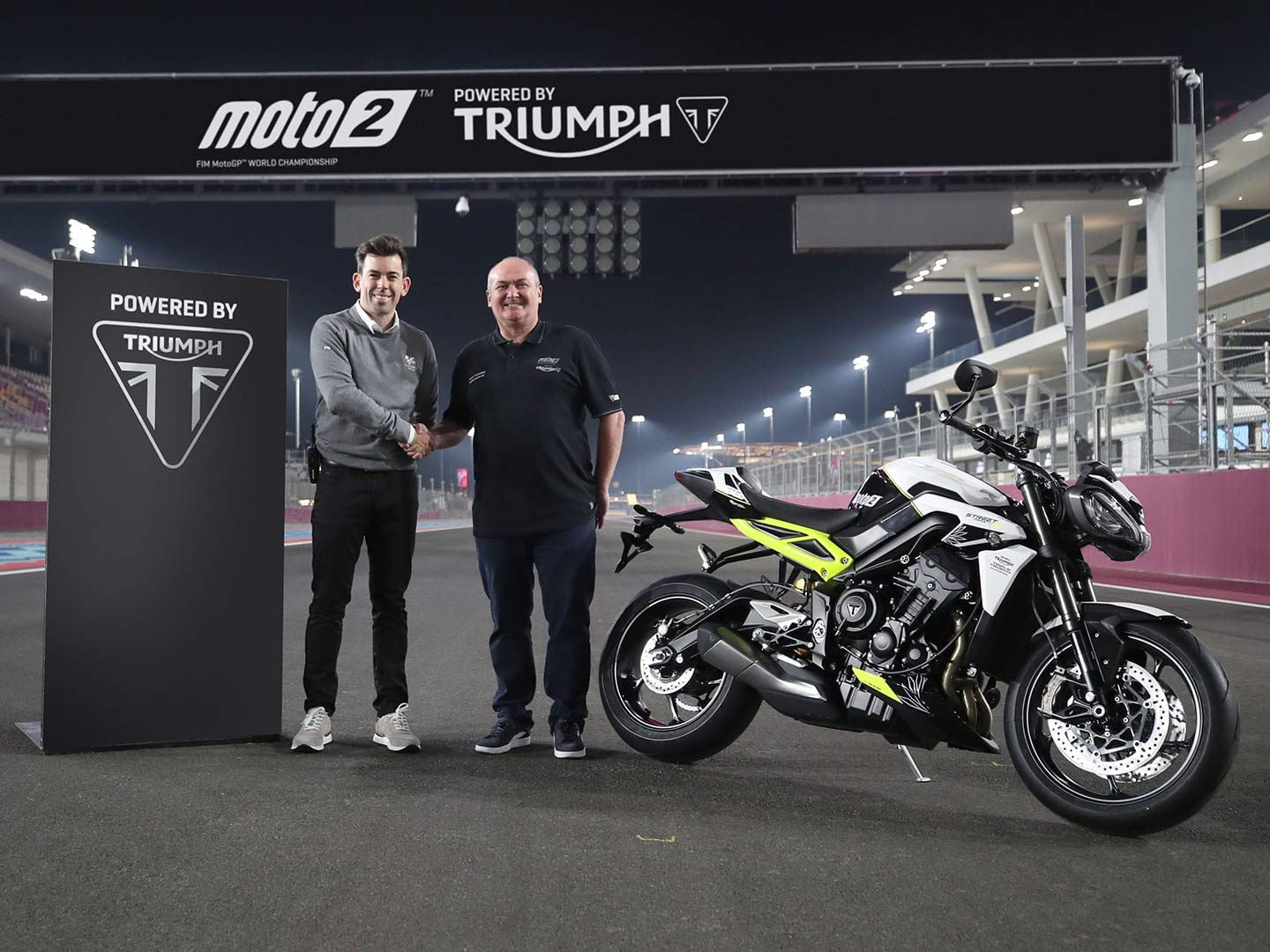
2024 Triumph Triple Trophy Competition Launches in Moto2 (Triumph/)Triumph Press Release:
On the eve of the opening Grand Prix of the new season, Triumph Motorcycles and MotoGP™ have revealed the new 2024 Triumph Triple Trophy motorcycle, to be won by the rider who delivers the most stand-out performances in Moto2™ this season. And this year, for the first time, the winner will be chosen by the fans.
Unveiled at the Lusail International Circuit, Qatar, this year’s Triumph Triple Trophy will recognize and celebrate the riders who put in standout performances or comebacks within the incredibly competitive field, as well as those who achieve the biggest sporting success during each Moto2™ round. The winner at the end of the season will receive a custom-liveried Triumph Street Triple 765 RS, powered by the 765cc triple from which the record-setting Moto2™ powerplant is derived.
Immediately after each Moto2™ Grand Prix, an expert panel representing Triumph and the world of MotoGP™ will select a shortlist of three standout riders from that GP. The selection will consider the entire weekend, not just the race, and recognize stories of sporting perseverance and endurance as well as outright performance.
Fans will then be able to vote via the MotoGP™ Instagram channel, and the final order of those three riders will be directly decided by the number of fan votes each receives.
In reference to Triumph’s 765cc engine, points at each GP are awarded as such:
- 7 points for the rider with most fan votes
- 6 points for the rider with second most fan votes
- 5 points for the rider with third most fan votes
Fan voting will take place on the MotoGP Instagram Stories on each Sunday following the race. Results will be published by MotoGP each Monday. Interested fans may follow Triumph Triple Trophy full season leaderboard on the Moto2 page of the Triumph Website.
Past recipients of the custom-liveried Street Triple RS are Marco Bezzecchi in 2020, Raul Fernandez in 2021, Jeremy Alcoba in 2022 and Pedro Acosta in 2023.
Steve Sargent - Chief Product Officer, Triumph Motorcycles
“The Triumph Triple Trophy has run alongside the Moto2 World Championship for four years already, recognizing and helping to highlight the incredible depth of competition throughout the field. We’ve seen some remarkable performances and some very worthy winners, and now we’re excited to announce a change for 2024.
Moto2 fans can now decide the outcome of the Triumph Triple Trophy by voting for standout performers each weekend. By selecting from a shortlist of three riders each time, we hope the Moto2 community will relish the chance to decide who will take home this year’s Street Triple 7654 RS prize.
We have seen lap records falling every year since our 765cc triple started powering Moto2 in 2019 and history-making seasons such as Pedro Acosta’s - the latest graduate from Moto2 to already shine in MotoGP. But there are so many factors and so much grit and determination that goes into every Moto2 Grand Prix and this is what the Triple Trophy, now powered by the fans, aims to reward.”
Carlos Ezpeleta - Chief Sporting Officer, Dorna Sports
“Triumph have proven a great asset to Moto2 since they joined the Championship, in terms of performance – breaking lap records and playing a key role in placing the class between Moto3 and MotoGP – and in terms of the impressive reliability we’ve seen week in, week out. As a sport with such strong connections to the vital global motorcycling industry, we’re also very proud to have them represented in the paddock as a manufacturer.
Within that commitment, the Triumph Triple Trophy has become a much-coveted prize as well, and we’re really happy to introduce this new element for 2024: inviting fans to become part of the process and cast their votes.”
-
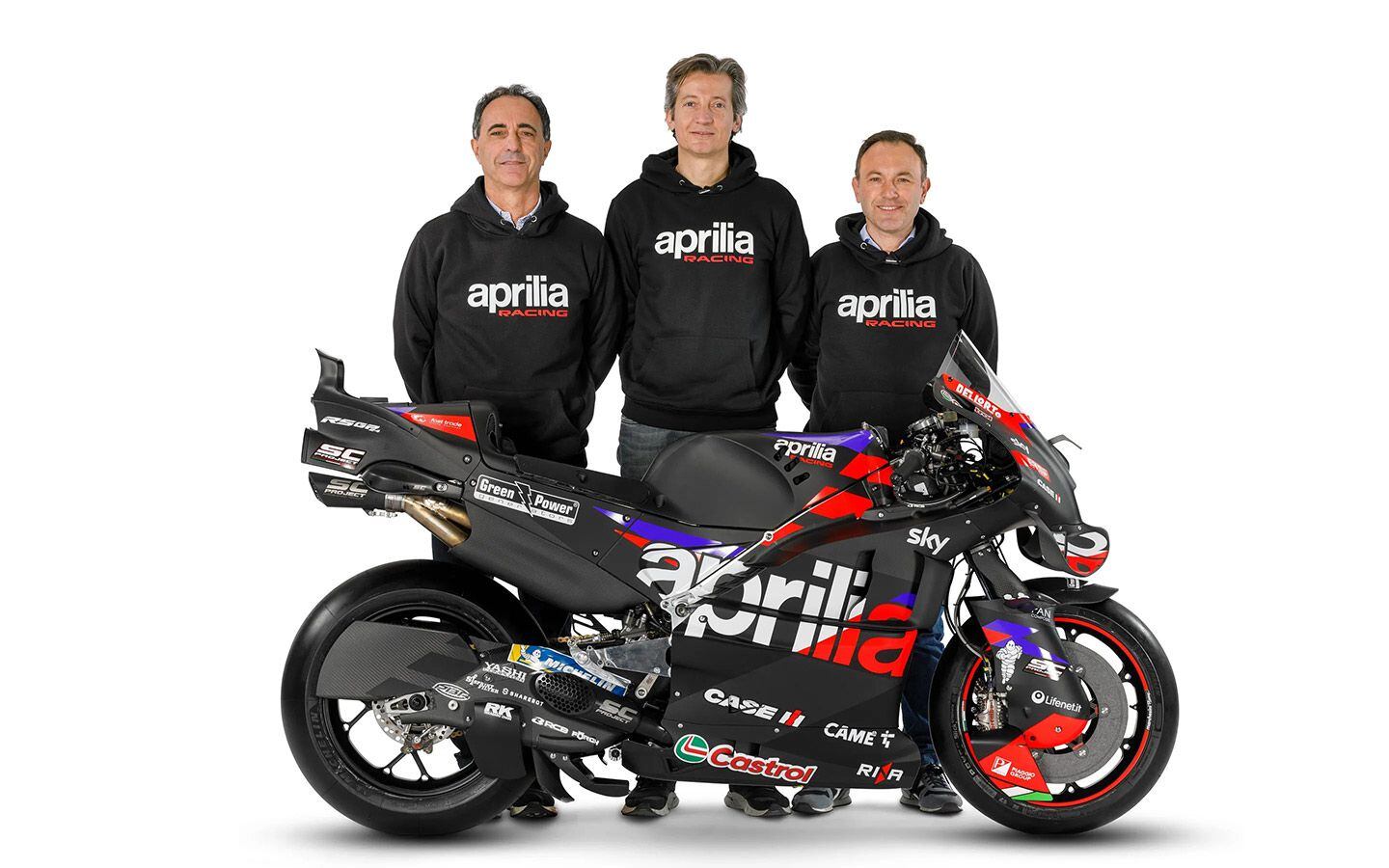
Left to right: Romano Albesiano, Massimo Rivola, and Paolo Bonora with the Aprilia RS-GP24. (Aprilia/)The excitement is building as the countdown begins for the 2024 MotoGP season with the first round set to be hosted by Qatar on March 8–10. With just a handful of days to go, motorsports fans around the world are keen to know which manufacturer will be able to challenge the reigning champion, Ducati. Aprilia—the other Italian constructor—aims at being the alternative.
During the latest tests in Qatar, the Noale company put itself on display with three RS-GPs in the first six positions. And Aleix Espargaró was just behind the two factory Ducatis, a clear sign of the tangible evolutionary growth Aprilia had during the winter.
We talked about this growth and the upcoming season with Aprilia Racing CEO Massimo Rivola and technical director Romano Albesiano.
The wait is over. How do you feel on the eve of the 2024 MotoGP season?
Rivola: “We arrive confident, strong from the good work done in Malaysia and Qatar during the winter. These are two very different tracks; in Sepang historically we suffer more, while we are faster in Losail. That’s why we must not delude ourselves.”
Aleix Espargaró was very competitive in Losail.
Rivola: “Aleix has been the most concrete so far. He has been with Aprilia since day one, and his three wins in Argentina 2022, Great Britain, and Barcelona in 2023 gave him extra confidence. In the Qatar tests he finished just behind [Francesco] Bagnaia and [Enea] Bastianini, so we are confident.”
Related: More Aprilia Aero Secrets Explained
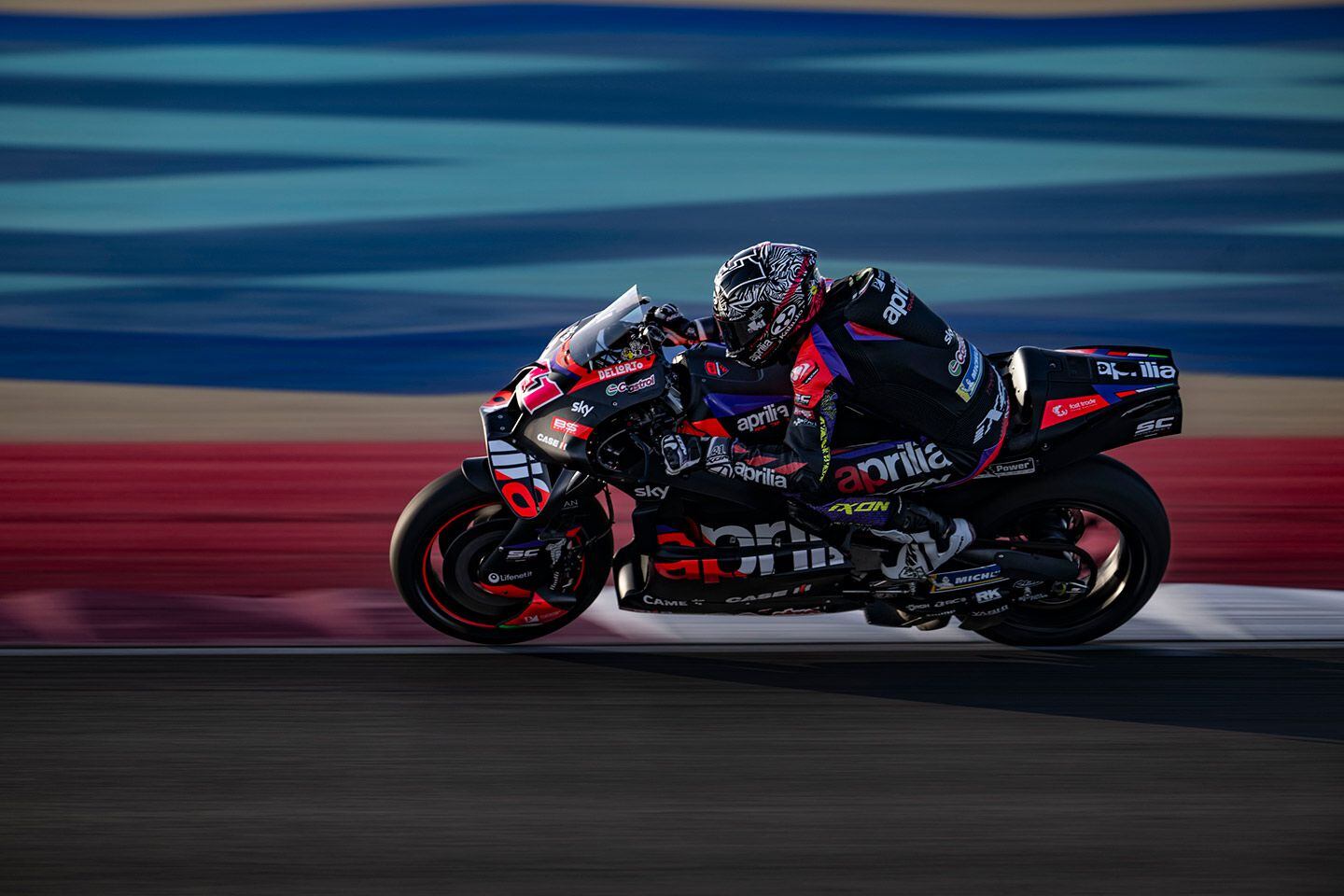
Aleix Espargaró has won the most on Aprilia. Can he fight for the title in 2024? (Aprilia/)How did the riders adapt to the 2024 package?
Rivola: “Aleix liked the full package right away, Maverick (Viñales) struggled more at the beginning, Miguel (Oliveira) went from the RS-GP22 to the 24 making a big jump because the bikes are very different especially at the aerodynamic level, while Raúl (Fernández) skipped Sepang as he was recovering from an injury and didn’t push hard in Qatar.”
Which are the main innovations of the 2024 RS-GP?
Albesiano: “For sure the ride-height devices which have become crucial and always more impacting on the bike. They have become essential and are able to give a clear advantage at the start and in acceleration. We have also worked on the electric and electronic side of the machine.”
What about the engine? The riders always ask for more power.
Albesiano: “We worked on the aerodynamics and the engine. Regarding the latest, according to the rules, with the start of the season it is sealed, but there are many things we can work around.”
How important is it to have a team like Trackhouse on your side?
Albesiano: “Lining up four bikes accelerates development and doubles data collection. With Trackhouse, it is also an important partnership for our brand in the United States. I’m sure it will be very beneficial also to increase the visibility of MotoGP in the US. Trackhouse has a lot of experience in NASCAR and they will bring something new in MotoGP.”
How many factory bikes will you line up?
Rivola: “In 2024 we are raising the bar, because Miguel Oliveira will start the season on an RS-GP with the same specs as the official bikes and Raúl will receive them very soon. This means a big commitment for the racing department but also shows the evolution of the project on all fronts.”
Will Aprilia be in the game as early as Qatar?
Rivola: “That’s what we’re aiming for. We are fast and the bike will also improve during the year.”
How do you see the level of your competitors?
Rivola: “Right now Ducati is one step ahead. I am convinced that Marc Márquez will be immediately in the title fight. In addition to the factory riders and [Jorge] Martín, we saw a fast Fabio Di Giannantonio. We will also be there in Qatar.”
Which is your main objective?
Rivola: “We aim at fighting with Ducati and KTM. Our goal is to become an alternative to Ducati.”
Related: Styrian MotoGP Wrap-up
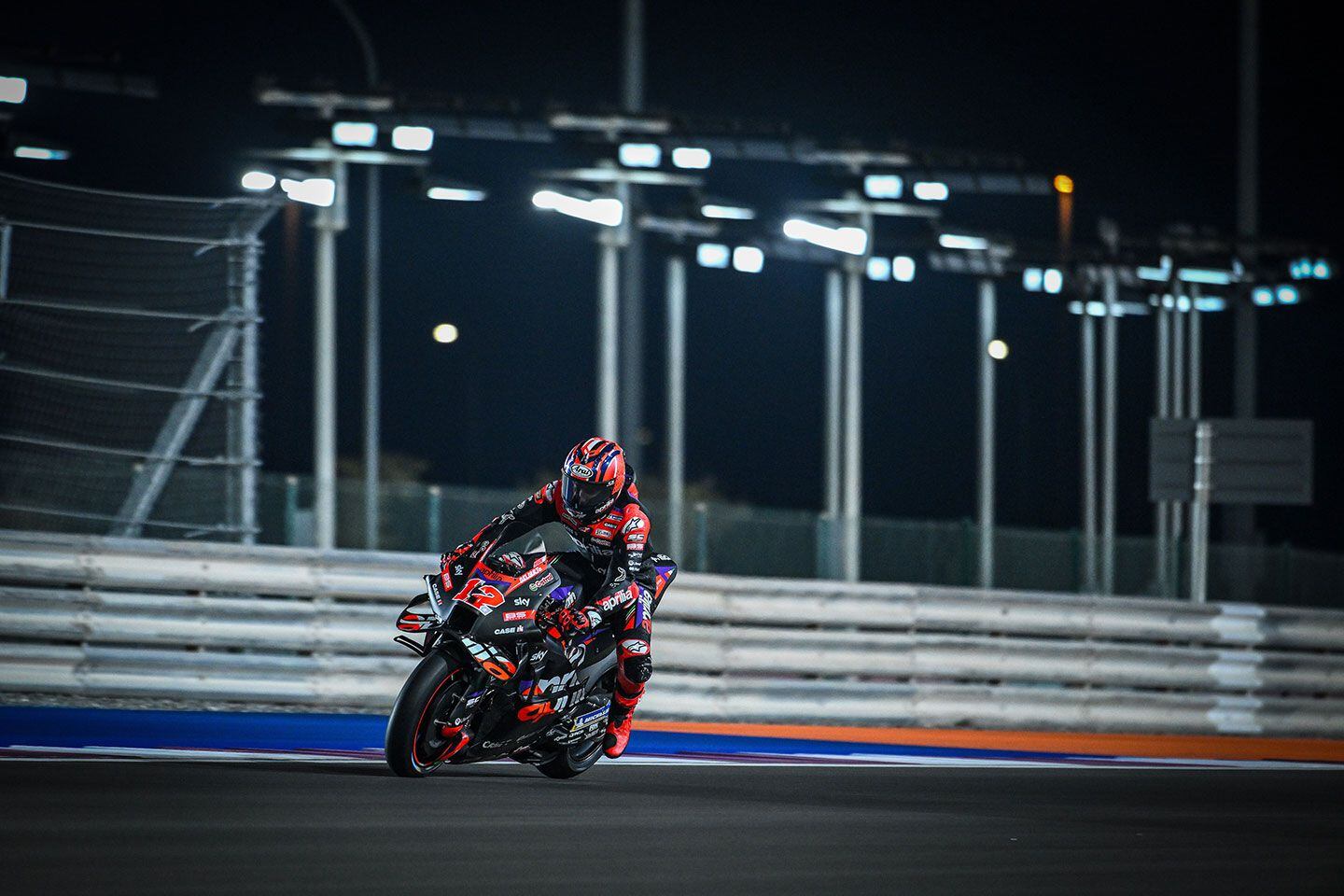
Maverick Viñales took more time to gel with the RS-GP24 machine. (Aprilia/)What about Honda and Yamaha?
Rivola: “At this moment they are chasing but I think they will arrive soon, also thanks to the advantage of concessions.”
How do you see the calendar?
Rivola: “It’s good to have more countries involved alongside ‘old-school’ circuits like Mugello that maintain the tradition for the fans and the original layout but with very modern facilities and a high standard in safety.”
What about two MotoGP races in the US?
Rivola: “What Formula 1 has done in America—to take as an example—has changed the perception of the sport. It would be great to have two MotoGP races in America; Dorna is working on it. Where? It would be great to have a second race in the north of the country.”
What about the format?
Rivola: “The introduction of the sprint race has been successful. The show offered is unquestionable, but I think a lot can still be done to bring our sport closer to young people so that they can have a hands-on experience.”
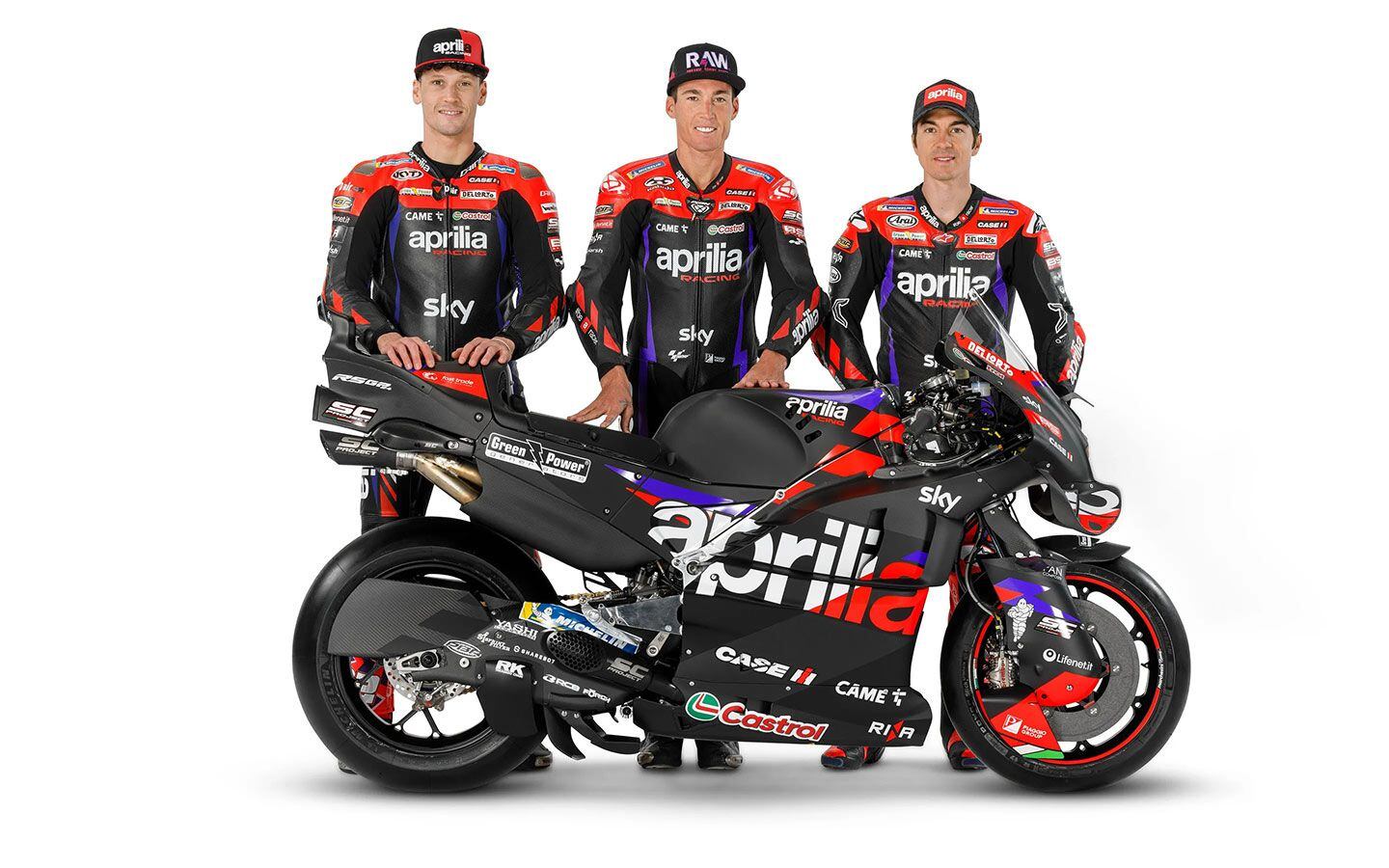
Left to Right: Lorenzo Savadori (official test rider), Espargaró, and Viñales stand behind their latest racebike: the Aprilia RS-GP24. (Aprilia/)Finally, the teams will meet in Qatar to finalize future technical directions. What is the trend?
Albesiano: “The philosophy behind the new rules that will be in force from 2027 is simplification. This will affect especially the aerodynamics, starting with the ride-height devices. The idea is to return to the DNA of the sport, with the focus on corner speed with a more flowing riding style, rather than on braking and acceleration as it is nowadays. The idea is to simplify the machine so that the rider can return to being the protagonist.”
-
 1
1
-
-
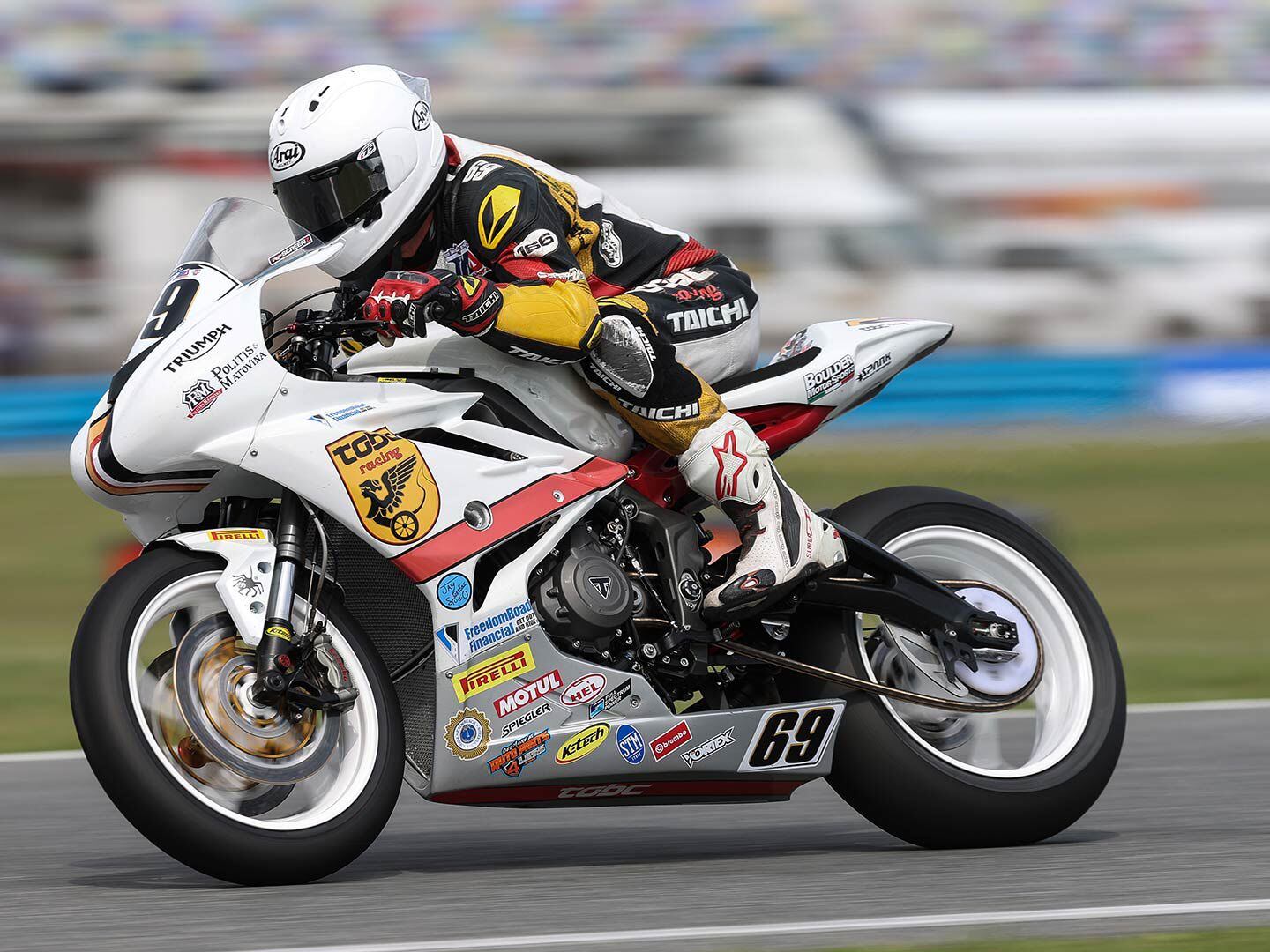
TOBC Triumph Return to Daytona 200 (Triumph/)Triumph Press Release:
The TOBC – Triumph racing team, supported by FreedomRoad Financial, returns to the Daytona 200 this weekend with Danny Eslick back on the track for another year.
Heading in to 2024, the TOBC – Triumph team have come together to reinforce the competitiveness of the TOBC Triumph team and the Street Triple. This also makes two teams supported by FreedomRoad Financial in the legendary race this weekend. Eslick will once again pilot a Triumph Street Triple, which powered his TOBC teammate to the top of the 2022 podium and now has five seasons of outstanding performance and reliability as the exclusive engine in the Moto2™ World Championship.
A victory for Danny Eslick would put the veteran racer in the company of few, tied for most wins all-time with five. Lindsay has already made history as the only female team owner to reach the top of the Daytona 200 podium, and a 5th win would further add to her legacy.
Michelle Lindsay – Owner, TOBC Racing
“I am excited to bring TOBC Racing back for another opportunity to compete in the Daytona 200 thanks to the support from Triumph and FreedomRoad Financial. It takes a team, and we wouldn’t’ be here without everyone working together to make it happen.”
Rod Lopusnak – General Manager, Triumph Motorcycles America
“The Daytona 200 continues to capture the world’s attention among racing events across the globe, As we gear up for the upcoming race, our focus remains on showcasing the unparalleled power and agility of the Triumph Street Triple and its 765 three-cylinder engine. Backed by Michelle and her TOBC Racing team, alongside the skills of Danny, we present a formidable force on the track. We extend our gratitude to FreedomRoad Financial for their unwavering support. Together, we aim to secure another victory and add to our legacy.”
Tom Collins – Managing Director, FreedomRoad Financial
“We are proud to have Triumph as our longest tenured OEM relationship as we’ve been their retail finance partner since 2008. We continue to be proud of the team’s performance on and off the track and we are excited to support them again in 2024.”
Ways to Watch the Daytona 200 Live at 1:00 PM EST / 10:00 AM PST:
- ESPN Star+
- MotoAmericaTV
- MAVTV – delayed
-
It seems every adventure bike manufacturer is following the design philosophy that Yamaha has been successful with for years; develop a versatile parallel twin feasible for platform sharing. Honda is no different. In 2022, it announced the development of an all-new 755cc parallel twin that would be utilized in the Transalp and Hornet 750. The same year, Suzuki debuted an all-new 776cc parallel twin that is, just like Yamaha, shared between a supersport (GSX-8R), naked bike (GSX-8S), and adventure bike (V-strom 800DE). Naturally, Honda aims to do the same thing. Recent rumors suggest the development of a faired CBR750R and retro-styled CB750 Hawk. Although there has been no announcement on the arrival of the Hornet 750 in North America, the Transalp has been available since the end of 2023.
The 2024 Honda Transalp features a 755cc SOHC liquid-cooled parallel twin with a 270-degree crank, 46mm throttle bodies, a bidirectional quickshifter, and five ride modes: Sport, Standard, Rain, Gravel, and User. In the customizable User mode, riders have the choice between four levels of power, five levels of Honda Selectable Torque Control (traction control) as well as off, three levels of engine-braking, and three levels of ABS (Road, Off-road, and Off-road with rear ABS disabled). Chassis components include a lightweight steel diamond frame, 43mm Showa SFF-CA telescopic inverted fork with adjustable spring preload offering 7.9 inches of travel, Pro-Link Showa shock with adjustable preload providing 7.5 inches of travel, dual two-piston calipers with 310mm rotors, and 21/18-inch wheel sizes.
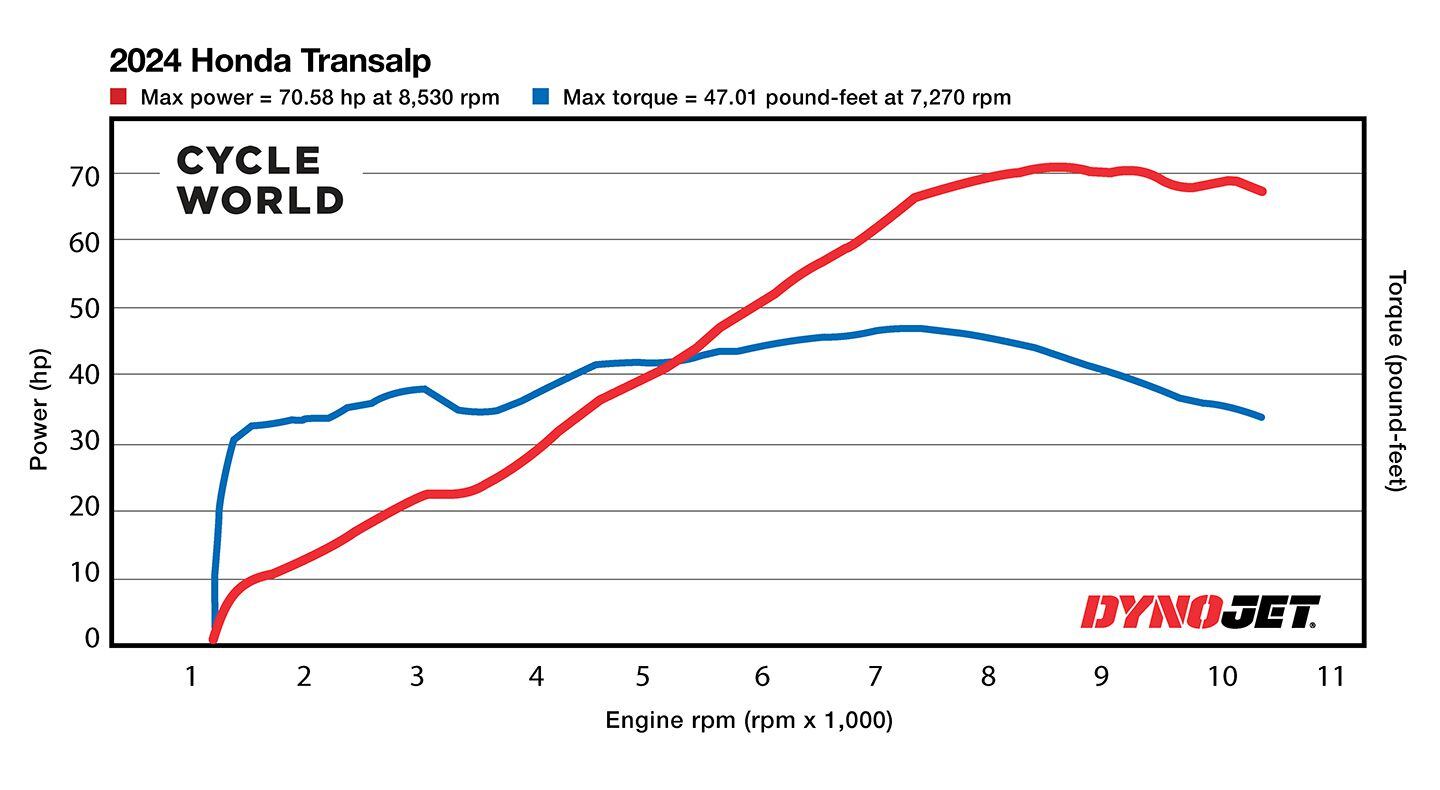
2024 Honda Transalp Dyno Chart. (Robert Martin/)On the Cycle World dyno, the 2024 Honda Transalp produced 70.58 hp at 8,530 rpm and 47.01 lb.-ft. of torque at 7,270 rpm. For reference, the 2023 Suzuki V-Strom 800DE produced 72.21 hp and 50.15 lb.-ft. of torque and the 2023 Yamaha Ténéré 700 produced 61.68 hp and 42.45 lb.-ft. of torque. The Transalps torque curve dips around 3,500 rpm, but at the top-end, the bike makes nearly peak horsepower all the way up to its 10,000-plus redline. The Honda does not have the same torquey feel as the Suzuki, but when revving up the 755cc parallel twin and making use of every rpm, the Transalp is very rewarding.
-

Alpinestars Launches Tech-Air 3 Leather and Canvas Vests (Alpinestars/)Alpinestars Press Release:
Today Alpinestars is launching the new Tech-Air® 3 Leather & Canvas vests at the legendary Daytona Bike Week. Alpinestars’ packable autonomous Airbag System is designed to ideally be worn over a motorcycle jacket, but can be worn under the jacket as well, providing effective and practical protection for V-Twin riders, touring riders, urban city commuters, and weekend warriors who want to ride protected.
The latest addition to the Alpinestars’ Tech-Air® family, Tech-Air® 3 Leather & Canvas Systems enable riders of all disciplines to benefit from a standalone, wearable garment featuring all the protection that Tech-Air® delivers, regardless of the bike they ride, or the style of riding they do.
Engineered to be worn in all weather conditions, the Tech-Air® 3 System’s lightweight construction and packable design allow it to be quickly folded up and stowed in a backpack, saddle bag, top case, or pannier when not in use.
Both the Leather and Canvas Systems’ outer chassis design also provides openings to allow customization through the sewing of patches or embroidery, if desired.
AI TECHNOLOGY AND CRASH MONITORING PERFORMANCE
The state-of-the-art Tech-Air® System uses an advanced crash detection algorithm that leverages AI to deploy the airbag precisely when needed. The Leather and Canvas Tech-Air® 3 incorporates 6 integrated sensors (1 triaxial accelerometer and 1 triaxial gyroscope) to provide the best crash monitoring performance and active airbag protection in a variety of dynamic street riding scenarios, even when stopped.
An LED display on the front chest indicates the airbag’s operational status. The LED display also incorporates a haptic alert, which vibrates to confirm the System is armed and alerts the rider when the battery is running low.
PROTECTION
Alpinestars’ crash detection triggering algorithm has been developed and refined over millions of miles of riding data and thousands of crashes, allowing the system to accurately assess when to deploy the airbag ahead of an impact or other dangerous situations like a lowside or highside crash. In the event the Tech-Air® 3 detects the start of a crash, the System will activate the protective airbag in milliseconds, providing upper body protection, and reducing up to 95% of the impact energy transferred to the rider anywhere the airbag protects, which includes the full chest and back.
SYSTEM OPERATIONAL STATUS
A discretely hidden but easily visible LED display on the front chest indicates the Airbag System’s operational status and incorporates a haptic alert, which vibrates to confirm the System is armed, as well as alerts the rider when the battery is running low. Bluetooth connectivity to a Tech-Air® App allows monitoring of both the System’s operational status and battery status and mapping of your journey via MyRide.
TECH-AIR® APP AND SYSTEM SOFTWARE UPDATES
When it comes to other features and benefits, the Tech-Air® 3 Leather & Canvas Systems are Bluetooth-enabled, allowing riders to easily update their System with new releases of the software via the free Tech-Air® App. Additionally, there is a wide variety of functionalities within the App, giving riders the ability to check System status, consult the User Manual, and record their rides on an enhanced Google map, just to name a few. Regarding battery life, a fully charged battery will provide the system with 40 hours of active ride time. A low battery will fully charge in about 4 hours; charging the battery for approximately 1 hour will provide approximately 8-10 hours of riding time.
Stylish, practical and secure, the Leather and Canvas Tech-Air® 3 vests suit any rider seeking the highest levels of active protection. Wear it over or under your jacket (provided that the jacket offers room to accommodate the inflation of the airbag) for peace of mind on every ride.
-
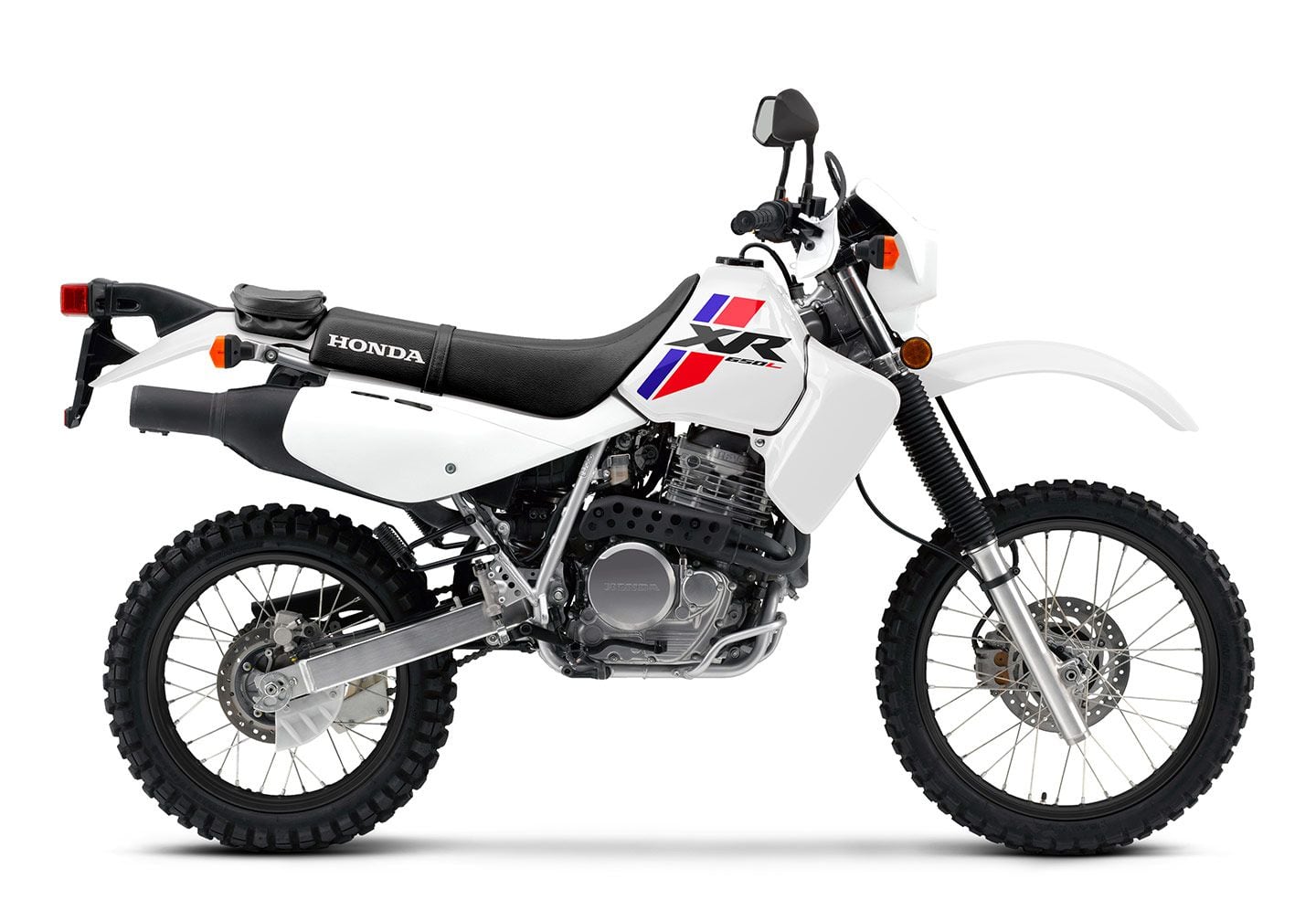
The 2024 Honda XR650L ($6,999). (Honda/)Honda introduces new graphics on XR650L for 2024. An icon in the dual sport segment since 1993, the Honda XR650L has received few mechanical changes in its 31-year history. The 644cc SOHC air-cooled single-cylinder engine is known to be tried, true, and dependable like a hammer.
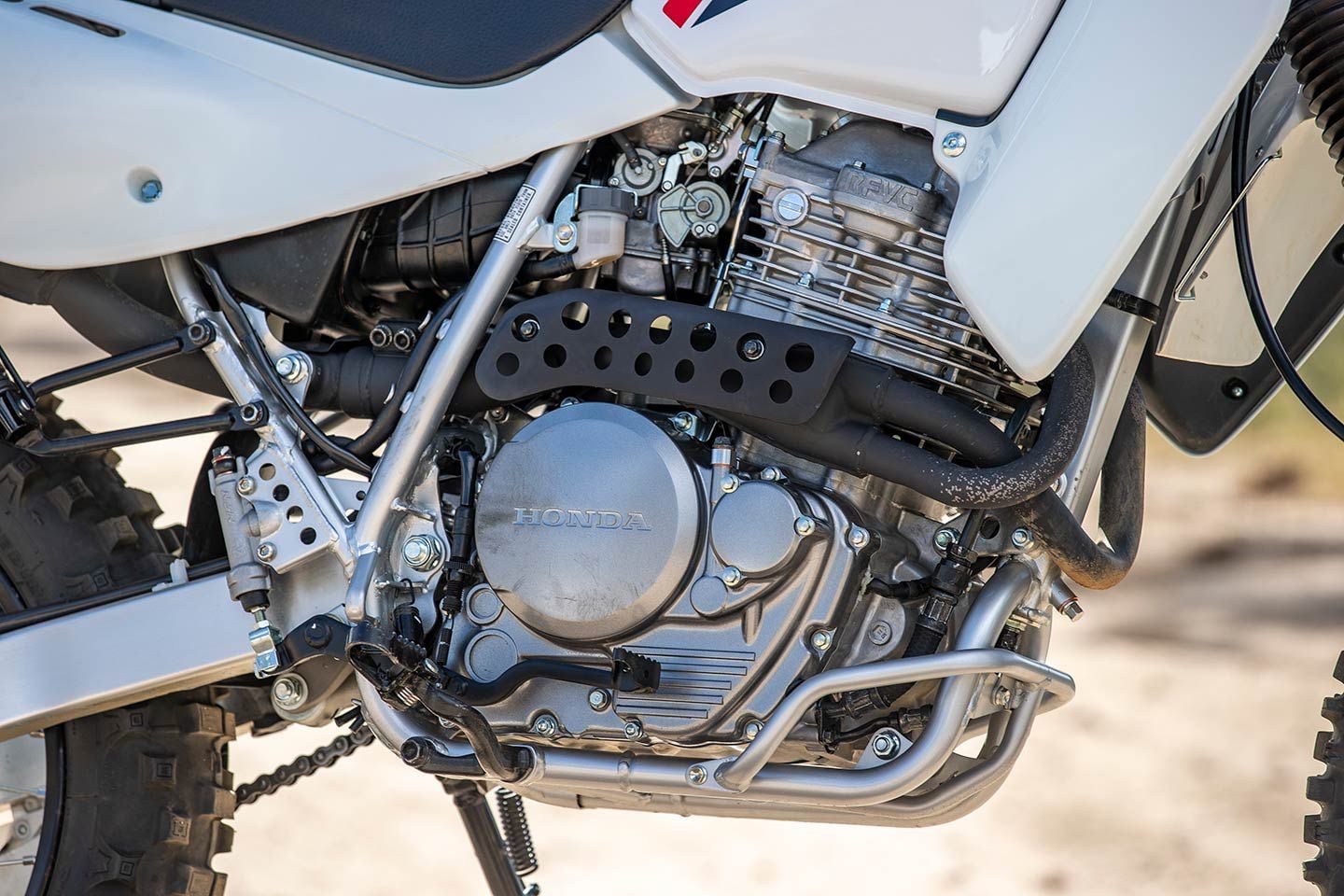
In 2023, the 644cc air-cooled single-cylinder engine produced 34.05 hp and 31.42 lb.-ft. of torque on the <i>Cycle World</i> dyno. (2023 model shown.) (Jeff Allen/)This big-bore (100mm bore and 82mm stroke) thumper is fed by a 43.2mm constant-velocity (CV) carburetor and matched with a five-speed transmission. A gear-driven counterbalancer reduces vibration. On the Cycle World Dynojet 250i dynamometer, the 2023 Honda XR650L produced 34.05 hp at 6,120 rpm and 31.42 lb.-ft. of torque at 5,320 rpm. With no changes other than the addition of a blue stripe on the gas tank (2.8 gallons), expect the 2024 model to produce similar power figures.
Related: Honda XR650L - Best Used Bikes
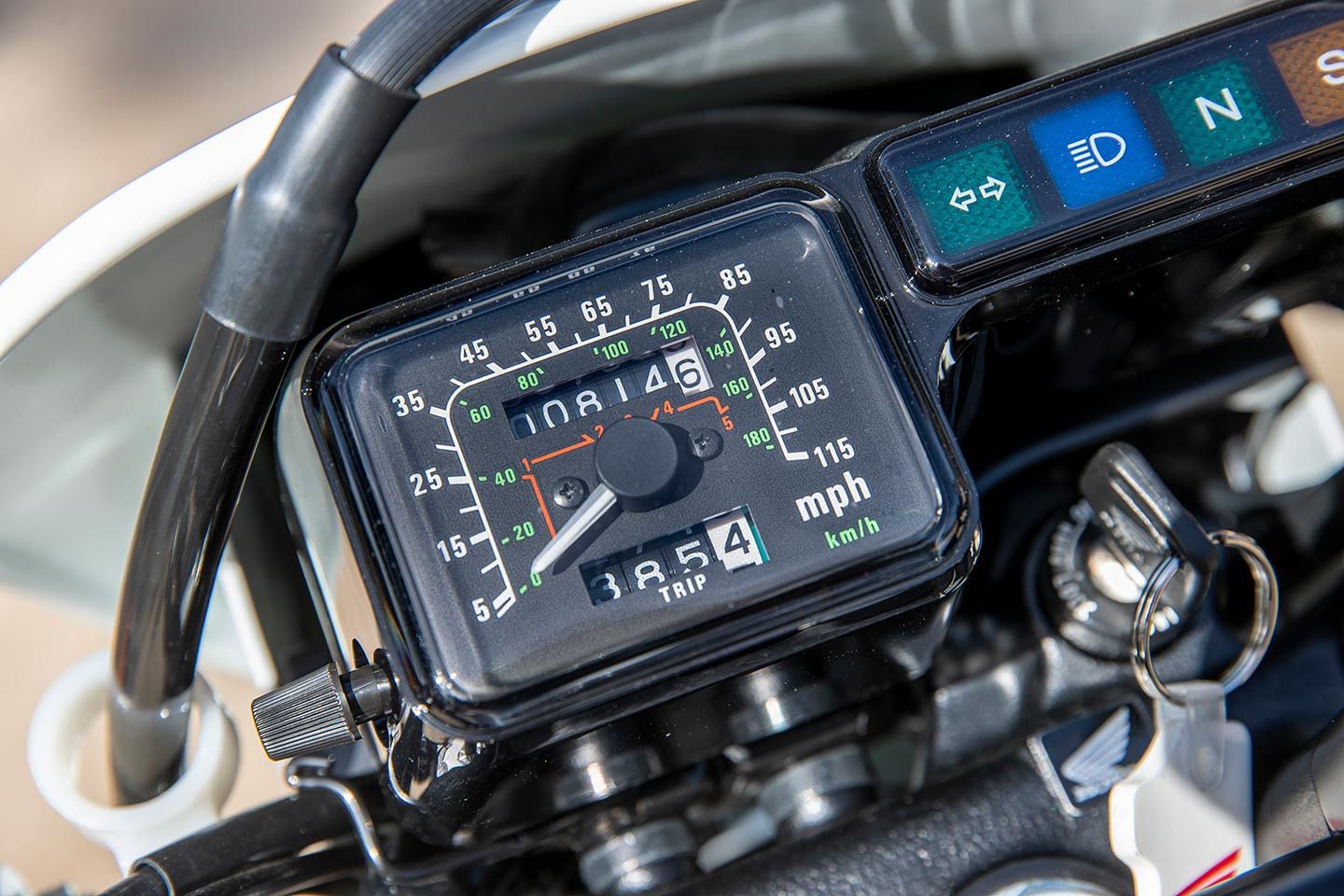
Sometimes less is more. The XR650L’s dash displays an analog speedometer, odometer, tripmeter, and a few indicator lights. (2023 model shown.) (Jeff Allen/)Chassis components remain the same from the prior model years. The 2024 Honda XR650L maintains a 43mm telescopic Showa fork with compression damping adjustability and 11.6 inches of travel, a fully adjustable Pro-Link Showa shock with 11 inches of travel, and a semi-double-cradle steel frame. The brake system features a familiar dual-piston caliper with a 256mm disc up front, and a single-piston caliper with a 220mm disc at the rear. Full-size off-road wheels (21 front, 18 rear) provide a variety of tire options for all types of users.
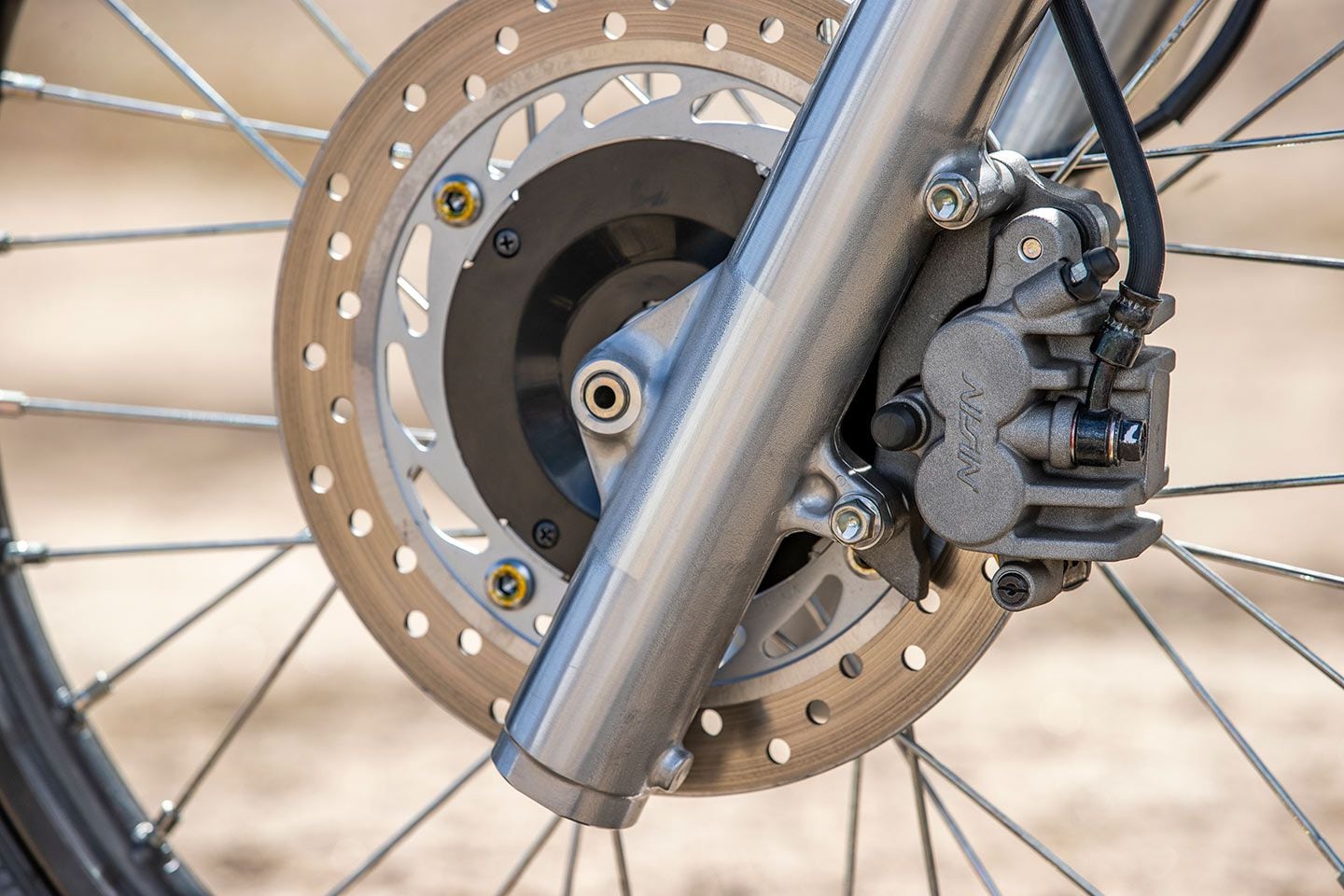
A dual-piston Nissin caliper pinches on a 256mm disc. (2023 model shown.) (Jeff Allen/)For 2024, the Honda XR650L receives only a minor styling update: red and blue stripes on the tank replace red and black. Although this is not big news, it is good news. Another year of the XR continues the legacy of a dual sport with rich history. In an era of high-performance, technical electronics and water-cooling, the Honda XR650L provides simplicity that many riders appreciate and even prefer. Whether you are working in the garage or out on the trail, the air-cooled thumper’s analog engineering is easy to navigate.
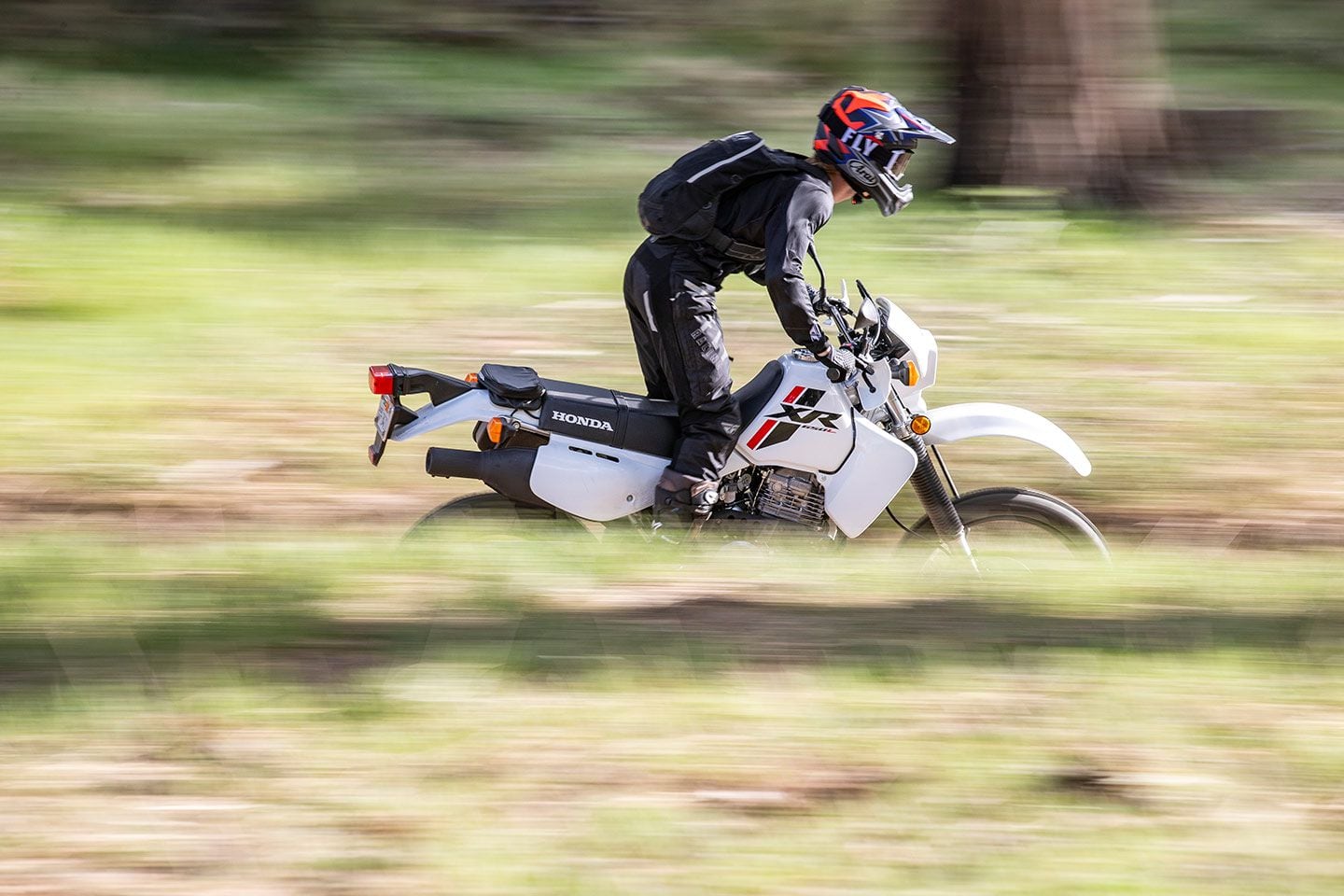
In motorcycling, it's not always about what you're on. It only matters that you're out riding. (2023 model shown.) (Jeff Allen/) -
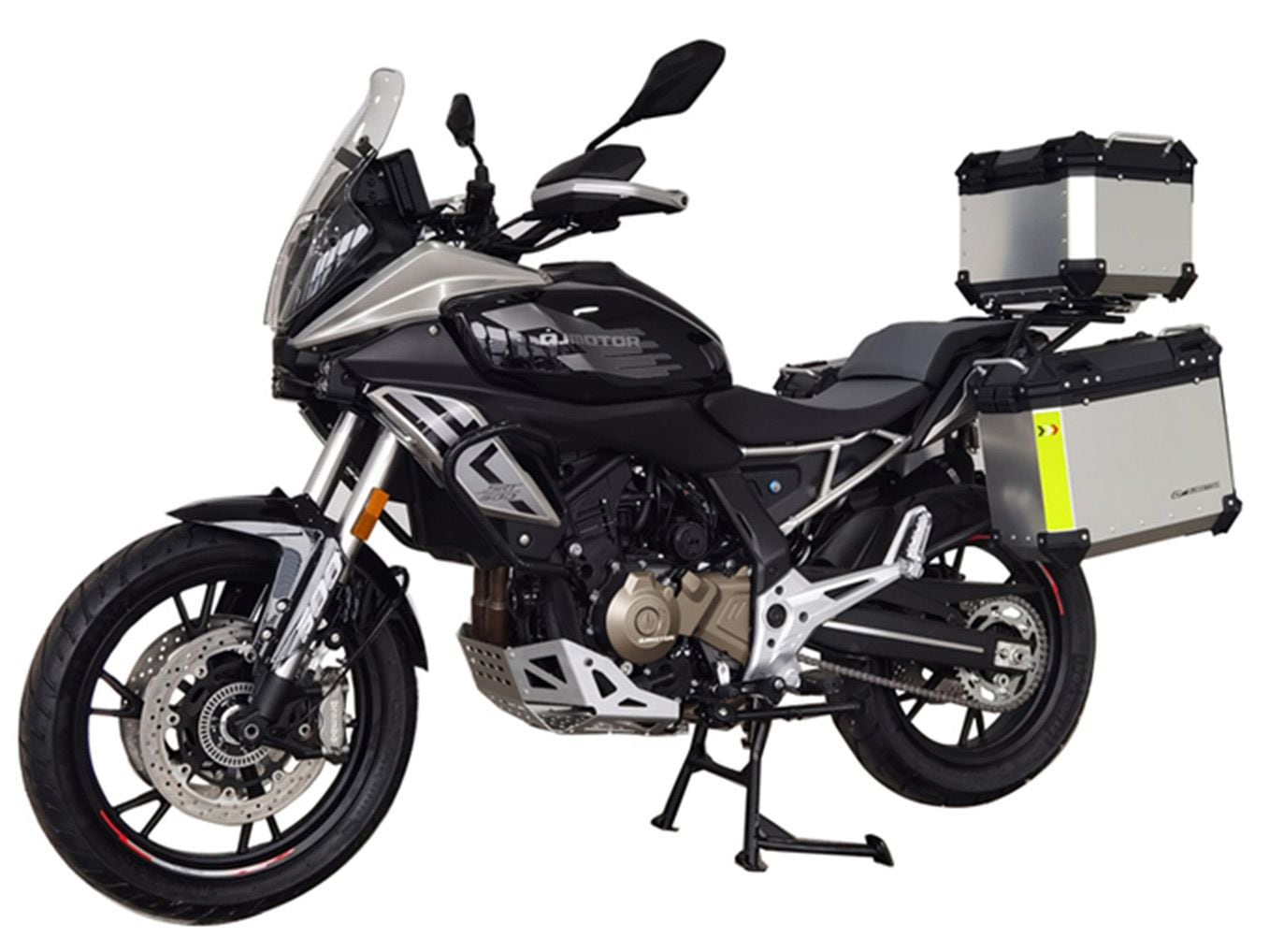
It appears that the QJMotor SRT600 will replace the SRT550, using a higher-performance engine and upgraded chassis components. (QJMotor/)China’s QJMotor churns out new and updated models at an insane rate at the moment as it scrambles to elevate itself to global competitiveness against established rivals. The latest type-approval information from China shows a set of new SRT600 adventure bikes that look set to supersede the existing SRT550 machines.
The QJMotor SRT550, which itself is a big-bore version of the preceding SRT500, is a cornerstone not only of QJMotor’s range but also the broader Qianjiang empire. Its engine and chassis are essentially shared with the Benelli TRK 502 and, until its cancellation, were also to be used by MV Agusta for the Lucky Explorer 5.5 that was first shown in 2021. As such, a change to the QJMotor machine could also be indicative of upcoming redesigns for Benelli, at the very least.
Type-approval documents for the new SRT600 show that while it wears “600″ badges and has a “QJ600″ code name, it actually uses the same 554cc capacity of the existing bike’s parallel twin. Despite that, the peak power listed on the new type approvals shows a huge increase from 47 hp for the existing SRT550 to 60 hp for the SRT600 version. That’s the same power level that QJMotor gets from its version of the engine used in its SRK550RR and RS sportbikes, suggesting it’s simply transplanted the higher-spec unit into the adventure bike.
Related: The Chinese Connection
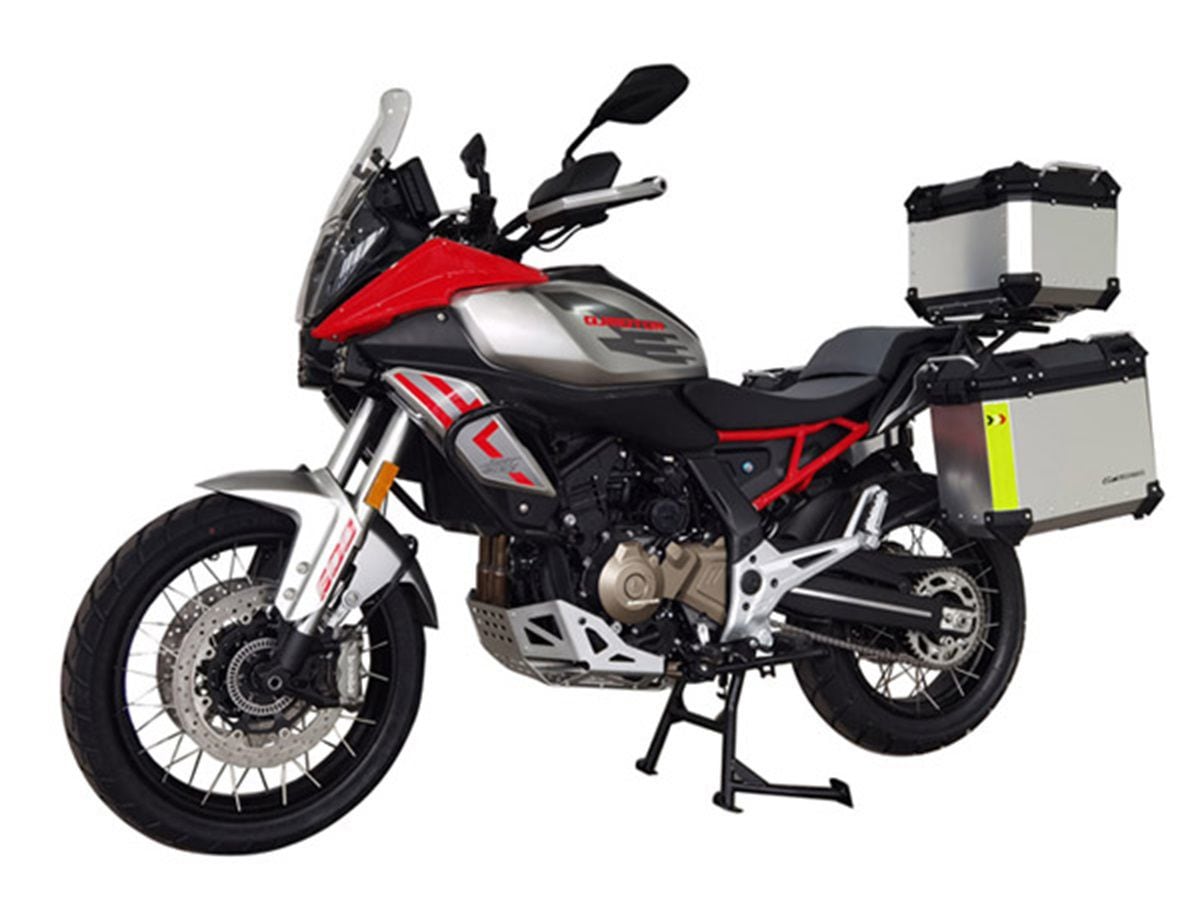
Documentation shows a few different versions with either wire-spoked or cast wheels, but in the same sizes. (QJMotor/)That’s combined with a weight reduction from 518 pounds to 485 pounds, and again that seems to be down to borrowing elements from the SRK550 sportbikes. The steel tube frame, while largely hidden in the images, appears to match the design used on the SRK models rather than the existing SRT550′s version, though elements like the seat subframe are different.
When it comes to appearance, the new model is a substantial step forward, ditching the rather derivative look of the SRT550—which sticks to adventure bike stereotypes including a large “beak” and twin, side-by-side headlights—for something a bit more individual. The new design is more like the look that the company introduced recently on its SVT650 (a 75-hp V-twin adventure bike) with a bluff, beakless nose and vertically stacked lights. On the new SRT600, those lights are assisted by no fewer than eight separate LED units on either side, which appear to be an integral part of the bodywork rather than auxiliary lamps.
Related: New V-4 for Benelli
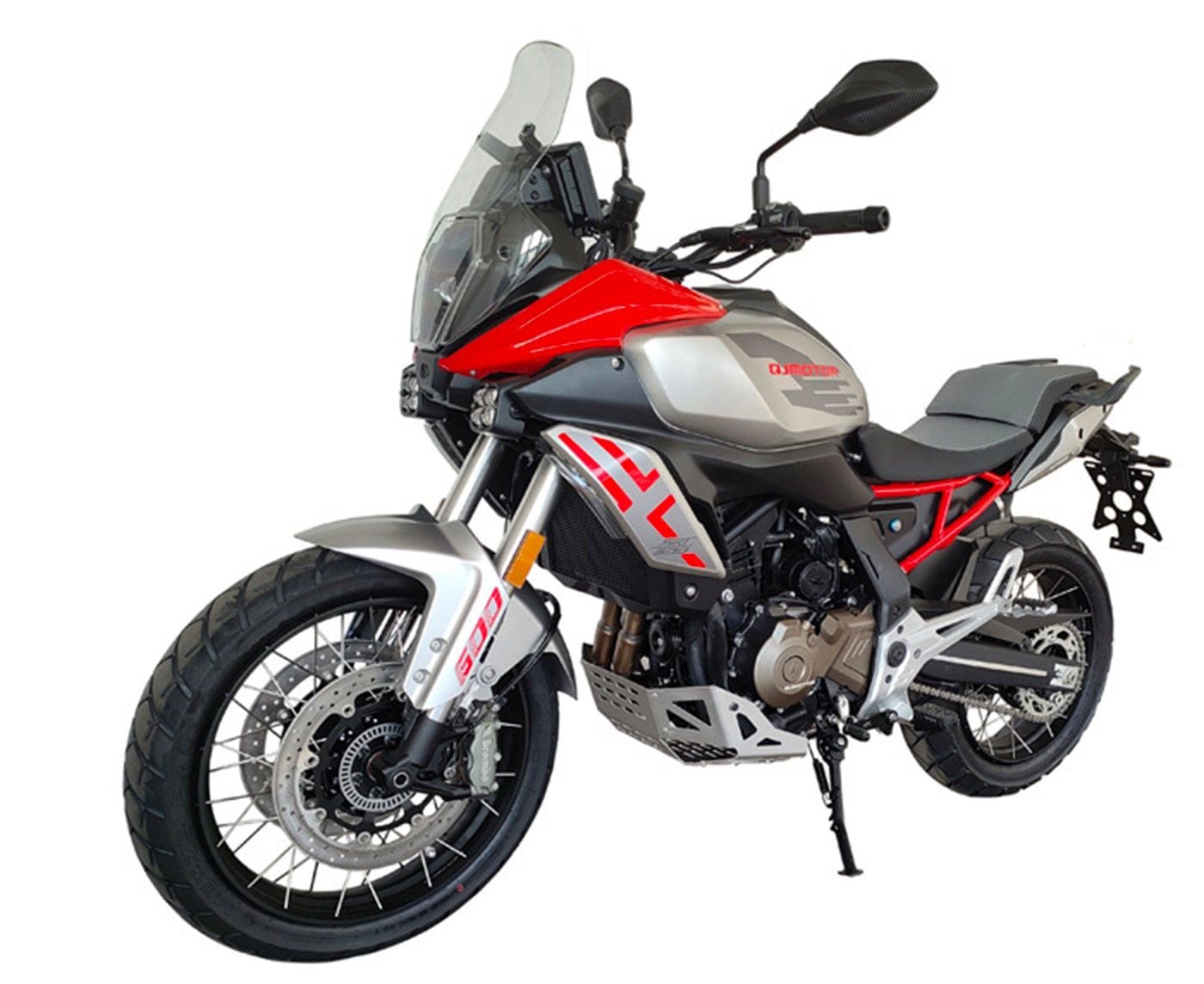
Radial-mount Brembo calipers are used on the different variations of the SRT600. This version forgoes the aluminum luggage and centerstand. (QJMotor/)Other elements worth noting include Brembo radial-mount brake calipers, plus the fact that the company has registered four distinct variants of the machine, two with luggage and crash protection and two more basic versions, each with a choice of wire-spoked or cast wheels. Both wheel types are the same sizes, with a 110/80-19 front and 150/70-17 rear.
Since QJMotor now has distribution across the globe, including a North American importer, there’s a good chance that once the SRT600 is officially revealed it could reach these shores.
Related: QJMotor Superbike
-
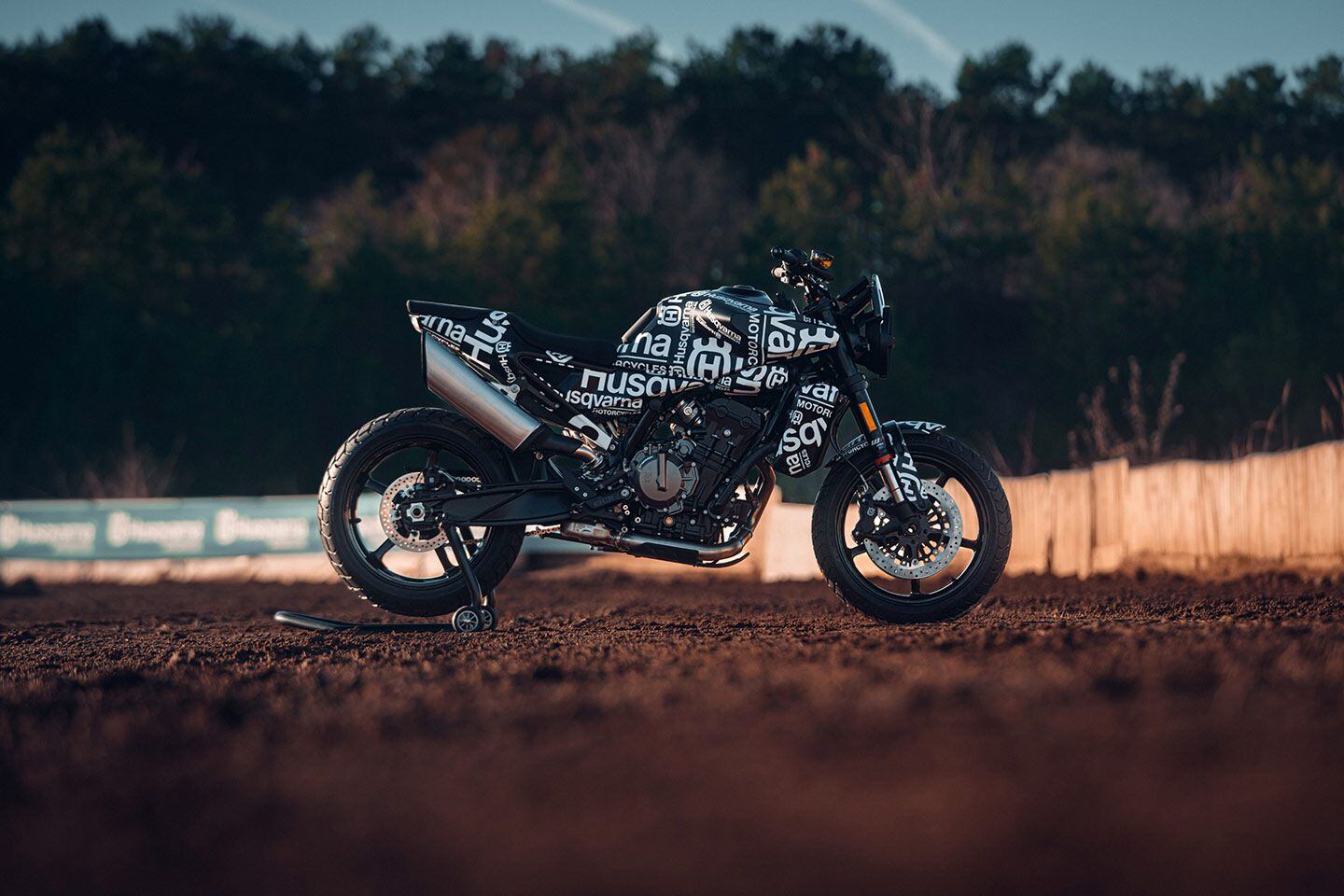
Camouflaged to hide final styling details, the upcoming Svartpilen 801 has broken cover, with Husqvarna confirming that it’s coming as a 2024 model. (Husqvarna/)This is the first official glimpse of the forthcoming Husqvarna Svartpilen 801. It’s a machine that takes the bones of KTM’s 790 Duke and wraps them in distinctive neo-retro styling to align with the smaller Svartpilen and Vitpilen models in the range.
It’s the first time the Svartpilen name has been applied to a twin-cylinder machine, a decade after the first model in the company’s KTM-owned era to bear the title was unveiled at EICMA in 2014. This year saw the original KTM 390 Duke–based Svartpilen and Vitpilen completely renewed, with the all-new 2024 KTM 390 Duke as their basis, but the Svartpilen 801 brings the model into a more competitive part of the market. Not only will it have to face competition from machines like Honda’s CB750 Hornet and Suzuki’s GSX-8S but also from sister models including the cut-price KTM 790 Duke—recently reintroduced as a Chinese-made, lower-cost alternative to the 890 and the new 990 Duke—and the CFMoto 800NK that uses the same engine.
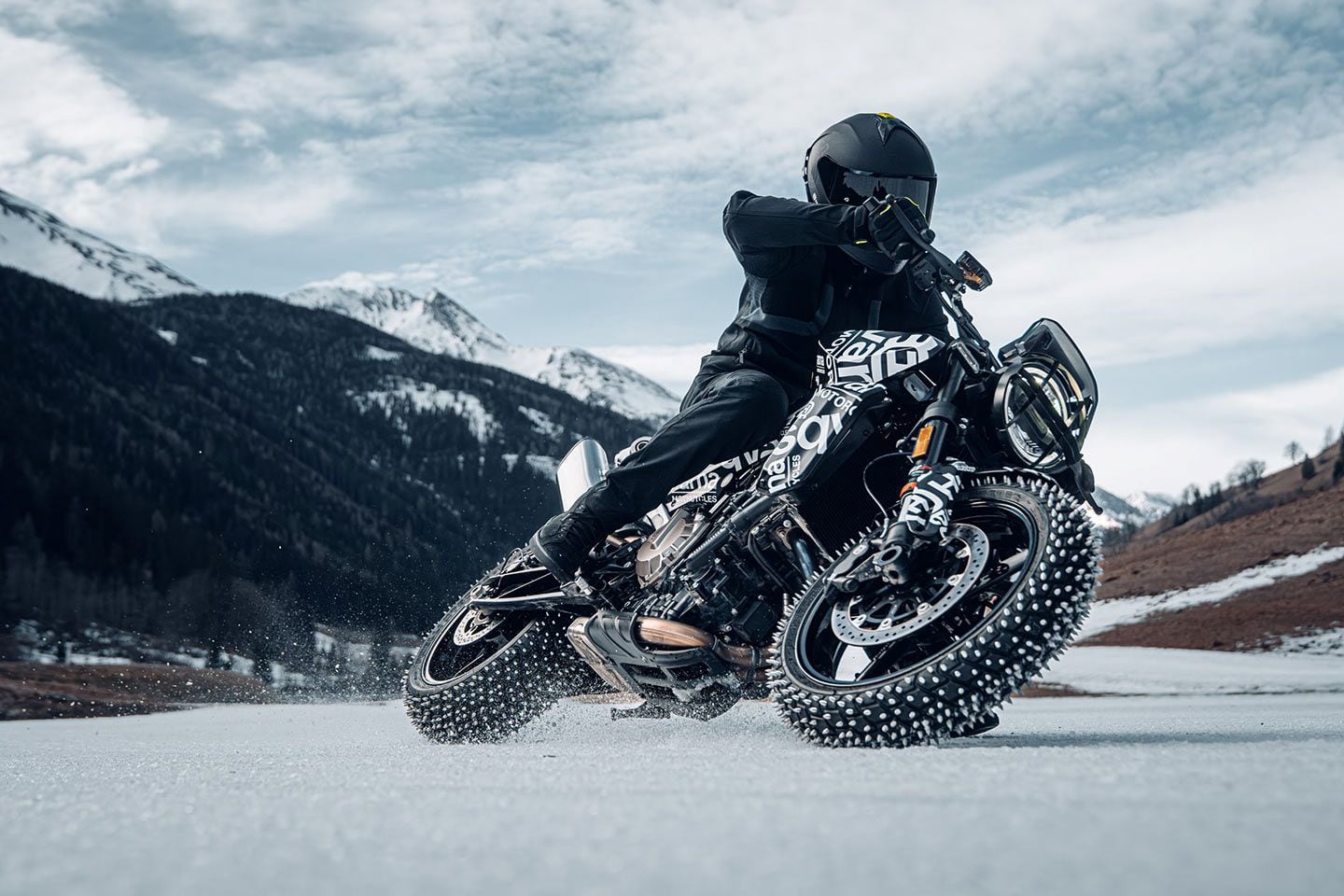
Pretty sure we aren’t going to get spiked ice tires on the new Svartpilen 801, but dang, that looks fun. (Husqvarna/)It’s a bit of a surprise to see the Svartpilen appear as the “801″ with the 799cc version of KTM’s LC8c parallel twin, since Husqvarna already uses the larger, 889cc variant of the same engine in the Norden 901. The decision is even more surprising when you hear that both Husqvarna models make the same peak power of 103 hp, though the Svartpilen needs 9,250 rpm to reach that figure, according to European type-approval documents, while the Norden’s larger engine hits it at 8,000 rpm. The Norden has more torque too (74 lb.-ft. against 64) with its maximum arriving at 6,500 rpm compared to 8,000 rpm for the 799cc Svartpilen.
Like the engine, the Svartpilen 801′s chassis is borrowed directly from the KTM 790 Duke and 890 Duke, rather than adopting the completely new design that debuted for 2024 on the latest 990 Duke. That means the usual combination of a steel tube frame and cast alloy swingarm, with WP Apex suspension at each end. The brakes are straight from the Duke as well, with four-piston radial-mount calipers and 300mm discs at the front, albeit wearing Husqvarna branding rather than KTM badges.
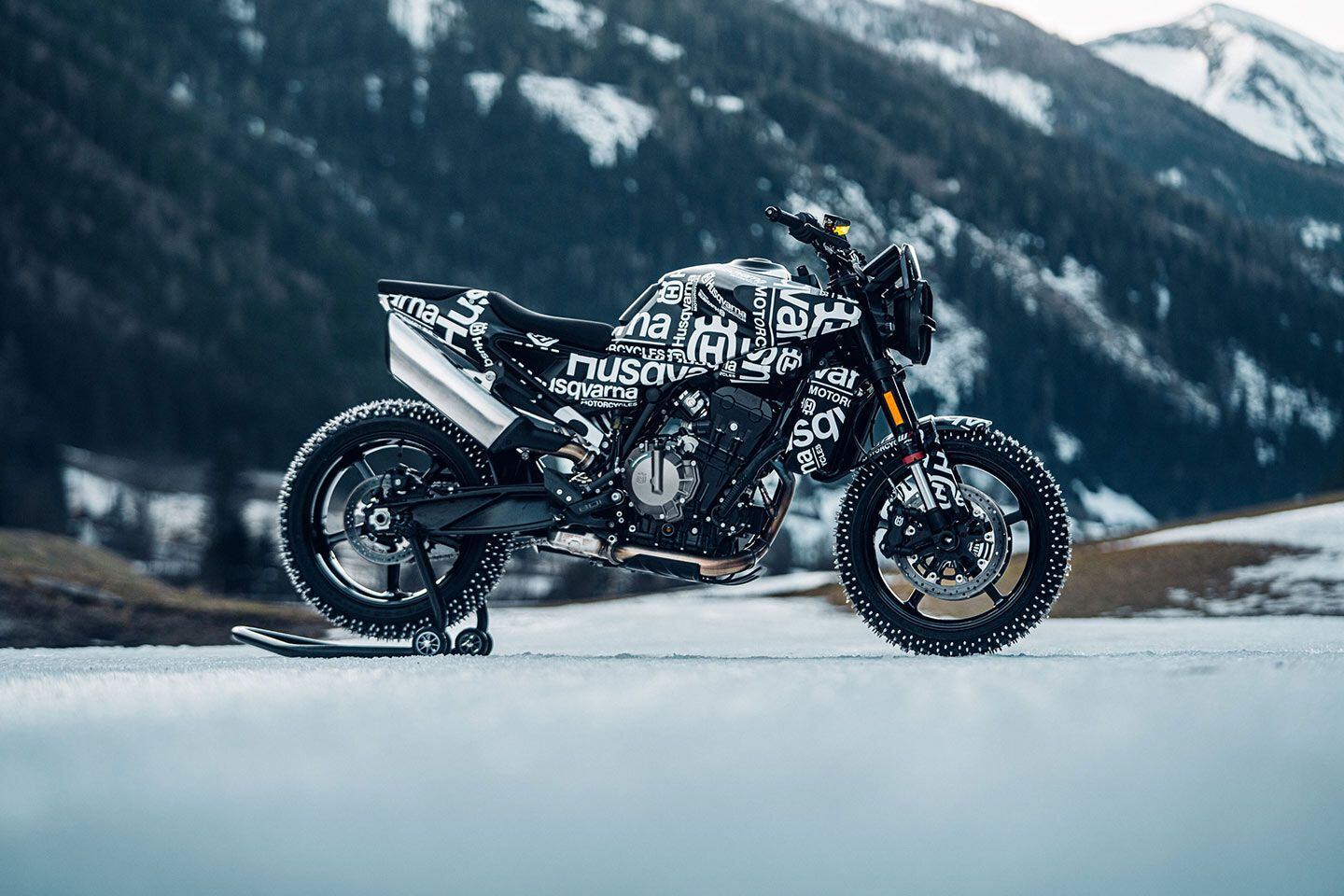
From this image we can pick out some of the chassis details, such as the suspension and braking packages. (Husqvarna/)Husqvarna is currently only saying that the bike, which gets a full unveiling in a couple of weeks’ time, has “state-of-the-art electronic rider aids.” Those are likely to include the same cornering ABS and traction control as the KTM Duke it’s based on, as well as multiple riding modes. A quickshifter is confirmed, and there’s a good chance the bike will also get wheelie control and engine-braking control systems, as used on its KTM cousin. On board, a TFT dash appears to be the same design already used by KTM for the Duke.
When it comes to other specifications, Husqvarna says the Svartpilen 801 weighs in at 399 pounds, and the type-approval documents that have been filed in Europe show that its outright length and 58.1-inch wheelbase are shared with the KTM Duke it’s based on. However, its bars are both taller and wider than the Duke’s, and with the smaller Svartpilen and Vitpilen models Husqvarna has proved an uncanny ability to give its bikes their own distinct character and riding position despite sharing most of their components with KTM models.
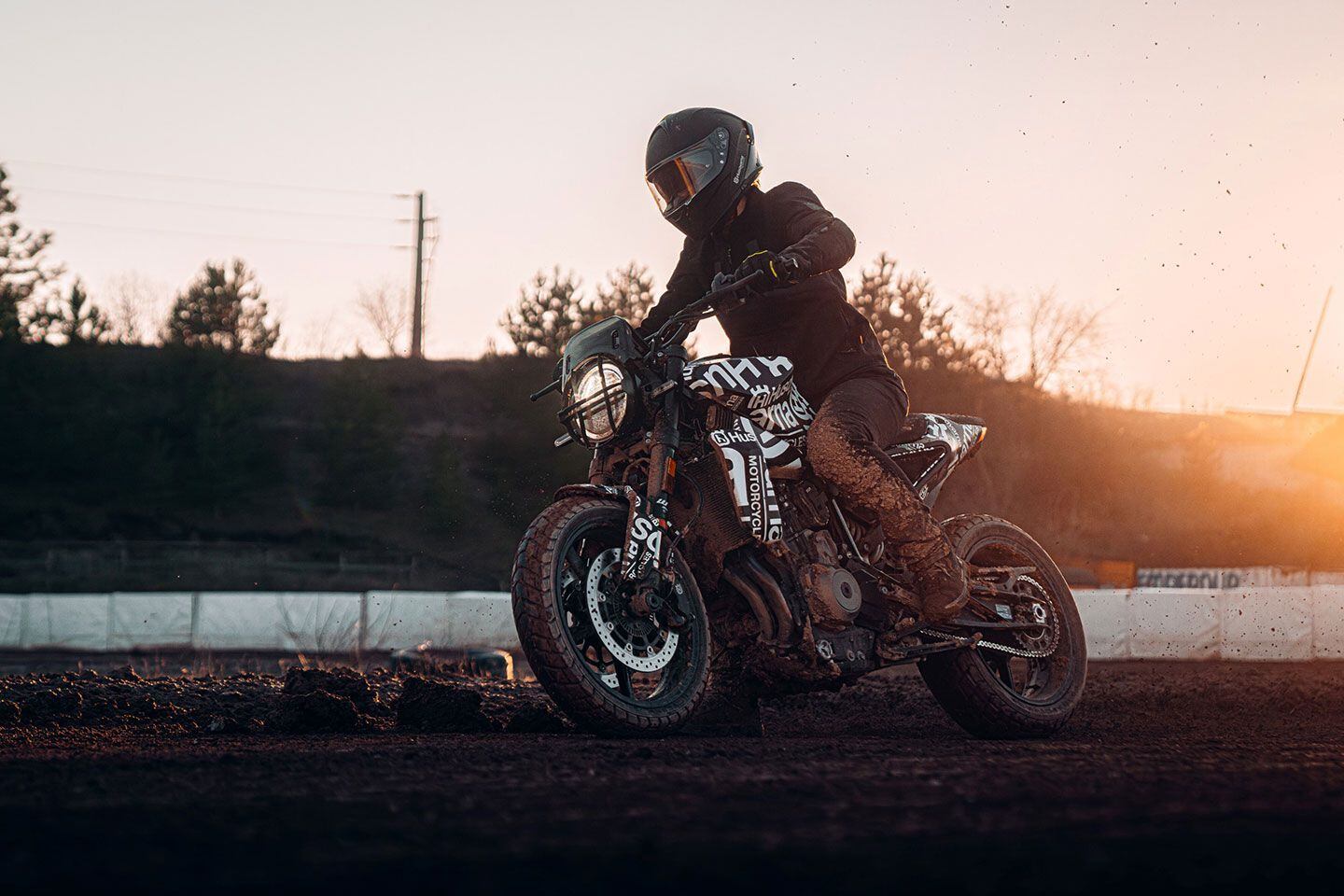
The 2024 Husky Svartpilen 801 in action. (Husqvarna/)In terms of visuals, there’s nothing surprising here. The design language for the Svartpilen and Vitpilen is well established and the 801 ticks the same boxes. Oversize, round headlight? Check. Chamfered flat sides to the fuel tank? Check. Short headlamp cowl? Check. Stubby seat unit? Check. We’ve yet to see the final color options and the prototype on show here has ice-racing studded tires and distraction camo graphics that will be gone for the production models—Husqvarna says the final bike and full technical details will be unveiled on March 19.
-
 1
1
-
-
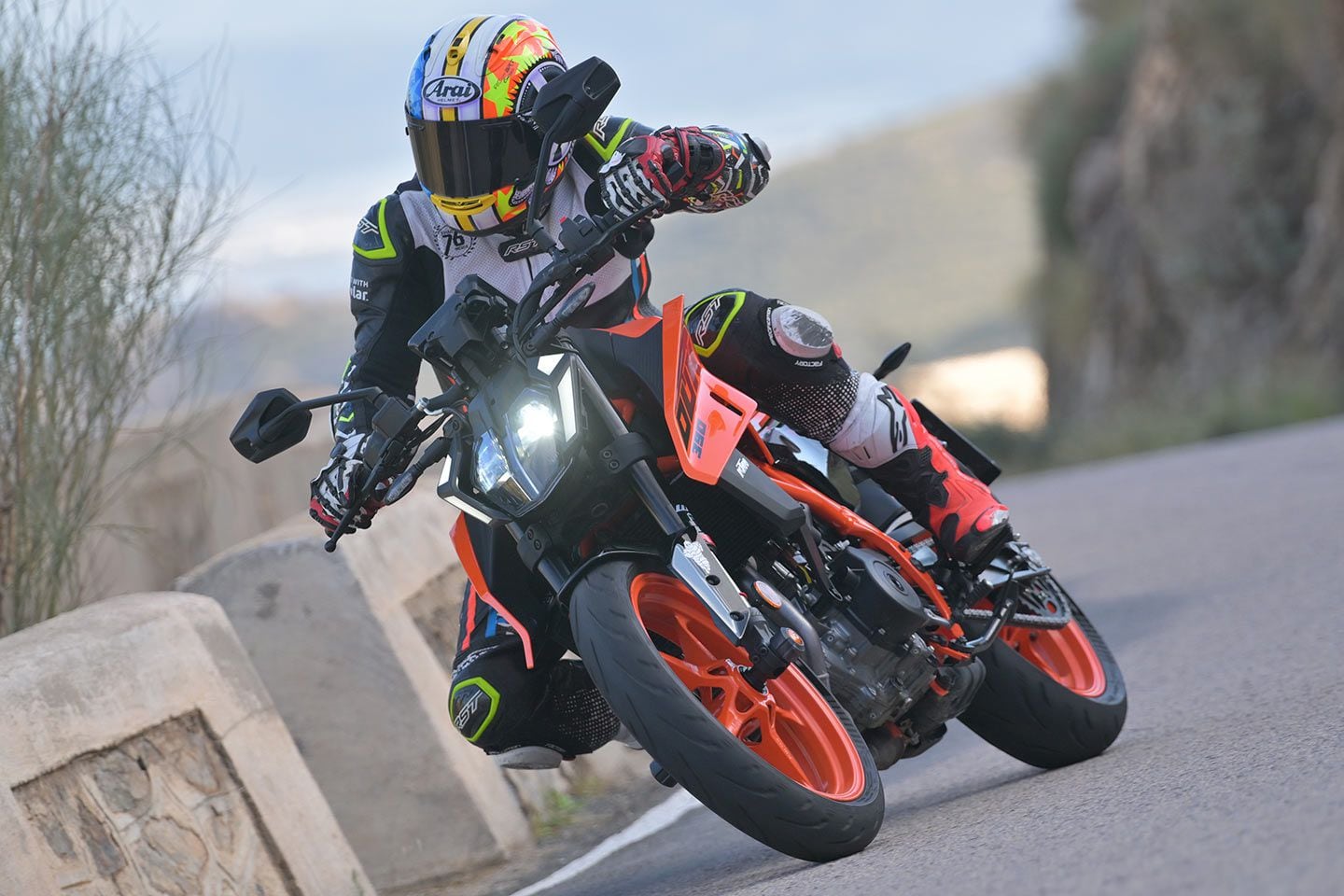
KTM’s 2024 390 Duke is a hoot on twisting mountain roads. (KTM/)If there’s one major manufacturer that irrefutably looks out for the kids, it is KTM. For the Austrian factory, its entry-level machinery is every bit as important as its range-topping flagships. Big or small, a KTM has to be “Ready to Race.”
It’s a philosophy that works. KTMs look young and feel young, and the smaller-capacity bikes aimed at new riders generally have a sporting authenticity.
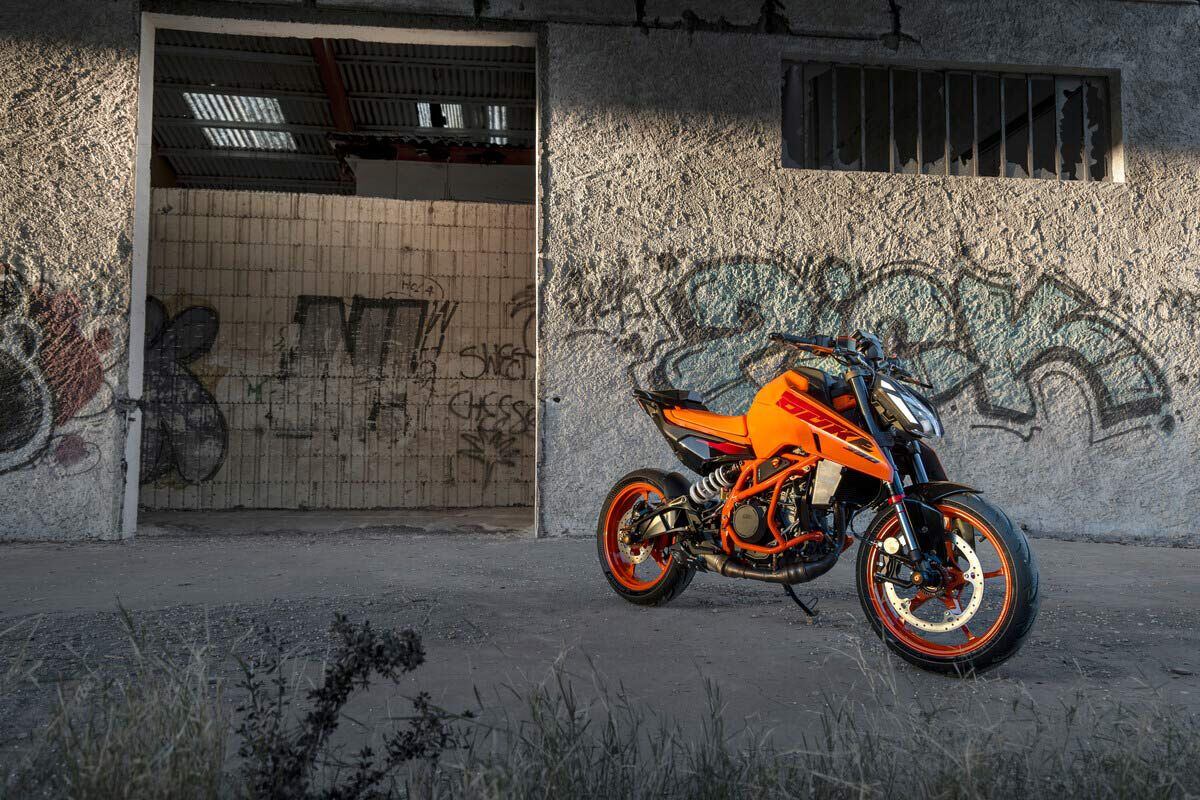
Just like the 990 Duke and 1390 Super Duke R Evo, the 390 Duke gets a refresh for 2024. (KTM/)For 2024 the Duke and Super Duke range of sporting nakeds get a refresh, and it’s therefore no surprise that the enduring, entry-level 390 has been lavished with as much attention and development as its big-cube siblings. There’s a distinctive new frame, a much-modified LC4c single-cylinder engine, and sharper looks, including a redesigned LED headlight pattern that will present a new-look face across the whole range.
As ever, KTM’s targets for this “90 percent new” model were more power and more agility. Bigger bangs, sharper handling. Starting with those bangs, capacity of the LC4c has gone up from 373cc to 399cc via a 4mm-longer stroke (though, in keeping with the larger redesign ethos, the cylinder head is more compact than before). Peak power is up fractionally from 43 hp to 44.3 hp (thus staying within European A2 license regulations) but arrives 1,000 rpm earlier at 8,500 rpm, while peak torque is up to 28.8 lb.-ft. at 7,000 rpm from 25.8 lb.-ft. at 7,250 rpm.
Related: Beginner’s Guide To Motorcycles
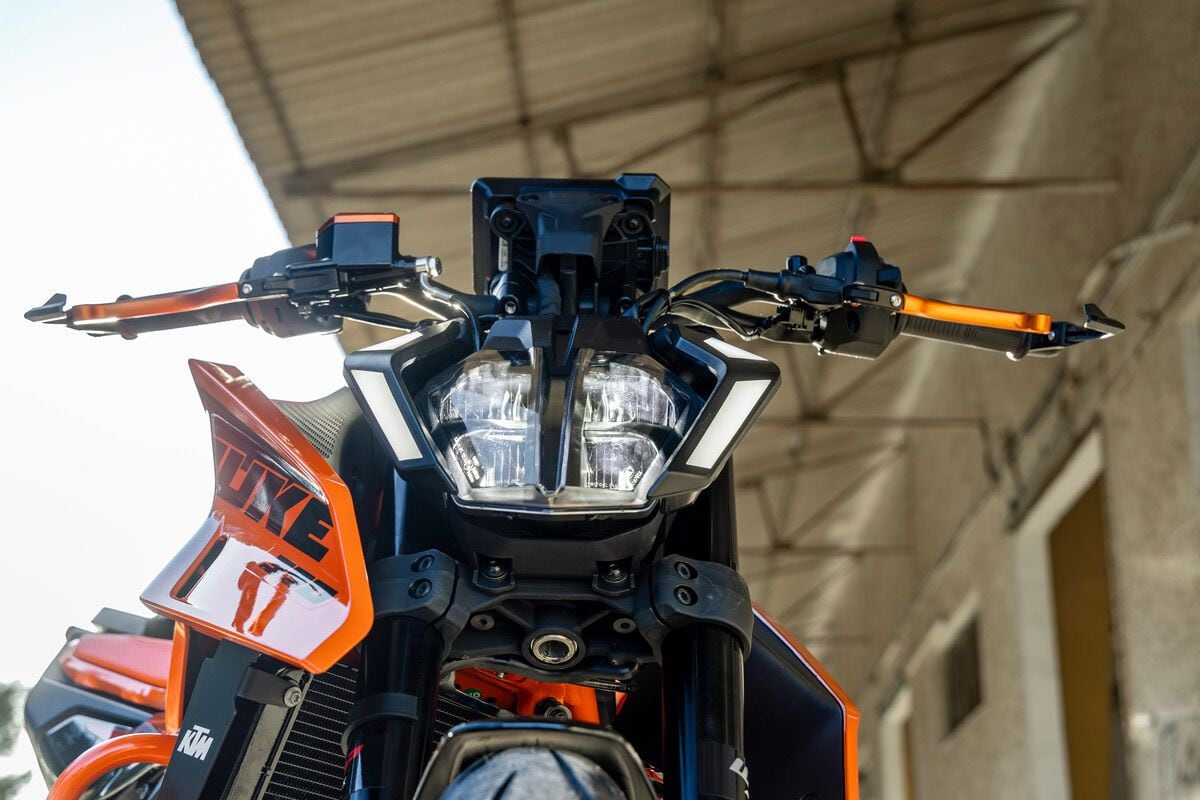
A new LED headlight is similar to those found on the larger-displacement Dukes. (KTM/)On the street those numbers translate to extra punch. The new 390 is notably lively off the throttle but also spins with a new fluidity, making its speed without the need to go to the rev limiter. Cruising at 80 mph is now more relaxed, while around town, at lower revs, it’s supersmooth for a single, purring like a kitten as it darts between columns of lumbering cars.
Engine
It’s a sweetly balanced unit, the LC4c, and between 4,000 rpm and 8,000 rpm is, for its 399cc—seriously flexible too, generating midrange drive strong enough to surprise the usual Sunday afternoon warriors. And if the mood takes you—and let’s face it, kids will be kids—the hard-working single doesn’t object to being revved out to the limiter in each gear. The six-speed gearbox could be slicker but with the rider tucked an indicated 106 mph is easily accessible, possibly a little more in favorable conditions.
Annoyingly the Quickshifter+ fitted to our test machine is only an optional extra, but in line with KTM’s ethos of loading its smaller bikes with the unruly credibility of their larger siblings, the 2024 KTM 390 Duke does come to market with lean-sensitive rider aids, traction control, and ABS, plus launch control and a pit-lane limiter. Admittedly the latter is more likely to be used in speed-restricted zones than at Laguna, but the cornering TC and ABS are genuine assets for newer riders. For the more experienced, the rider aids can be turned off (a Supermoto ABS setting allows you to lock the rear but still have ABS active on the front) because KTM wanted the Duke to be both fun and safe.
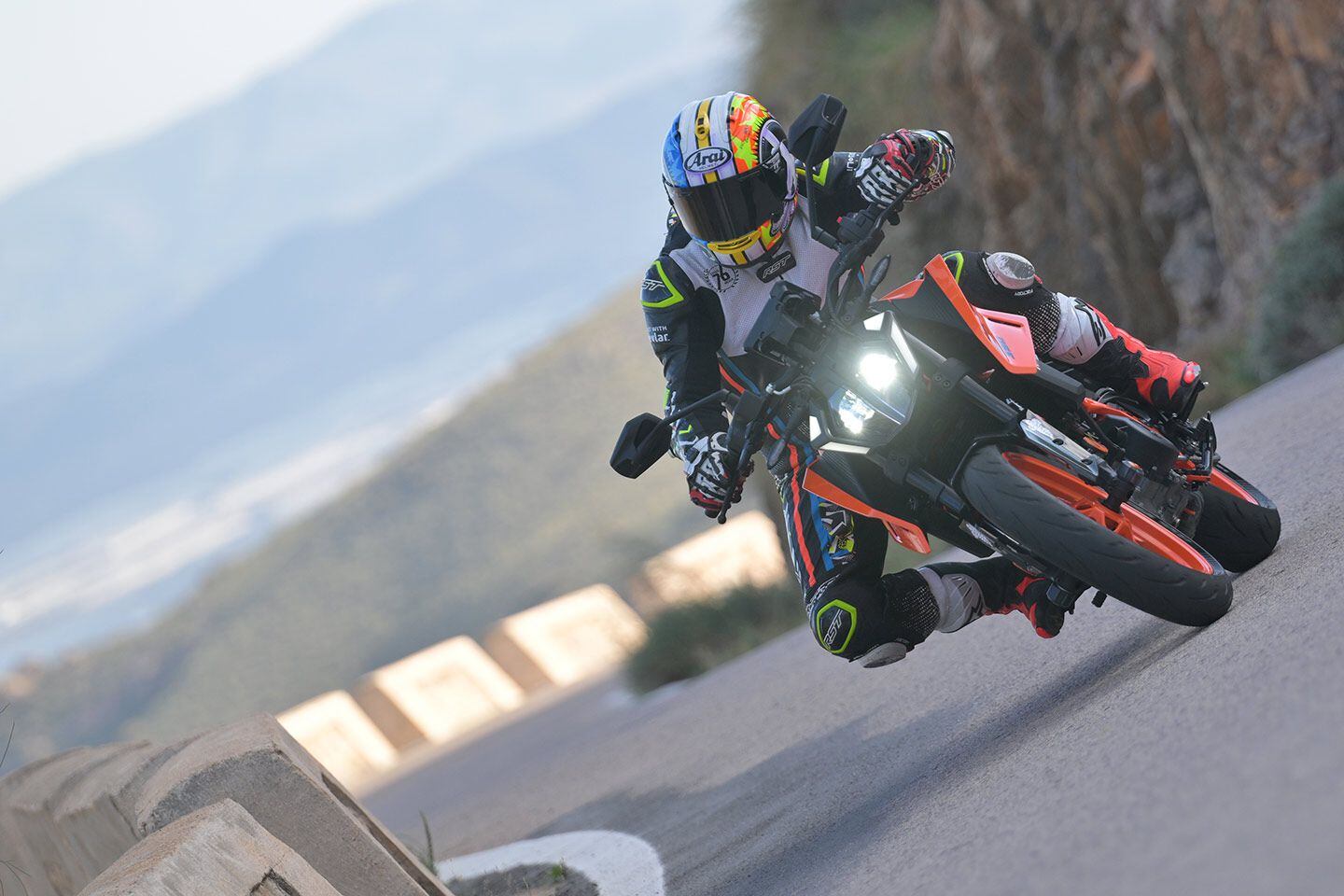
Lean-sensitive TC and ABS keep the smallest Duke moving in the right direction. (KTM/)There are three riding modes to choose from: Track, Sport, and Rain. These can be selected on the move and are clearly shown on a smart new 5-inch TFT dash. Track mode changes the dash’s layout to a clutter-free race display and sharpens the throttle response. Most of our road-only test was spent in the smoother and more rounded Sport mode, and with the TC off, was able to admire the torquier new 390′s ability to wheelie.
Chassis
KTM claims the 390′s revamped chassis gives better torsional rigidity and feedback than the older machine. That’s thanks to a new steel trellis frame that’s noticeably slimmer than before and a new cast aluminum subframe. New wheels are 9.5 pounds lighter than before (what, we wonder, were the old rims made of?) and with a full tank of gas, the 390 remains at a featherweight 364 pounds overall.
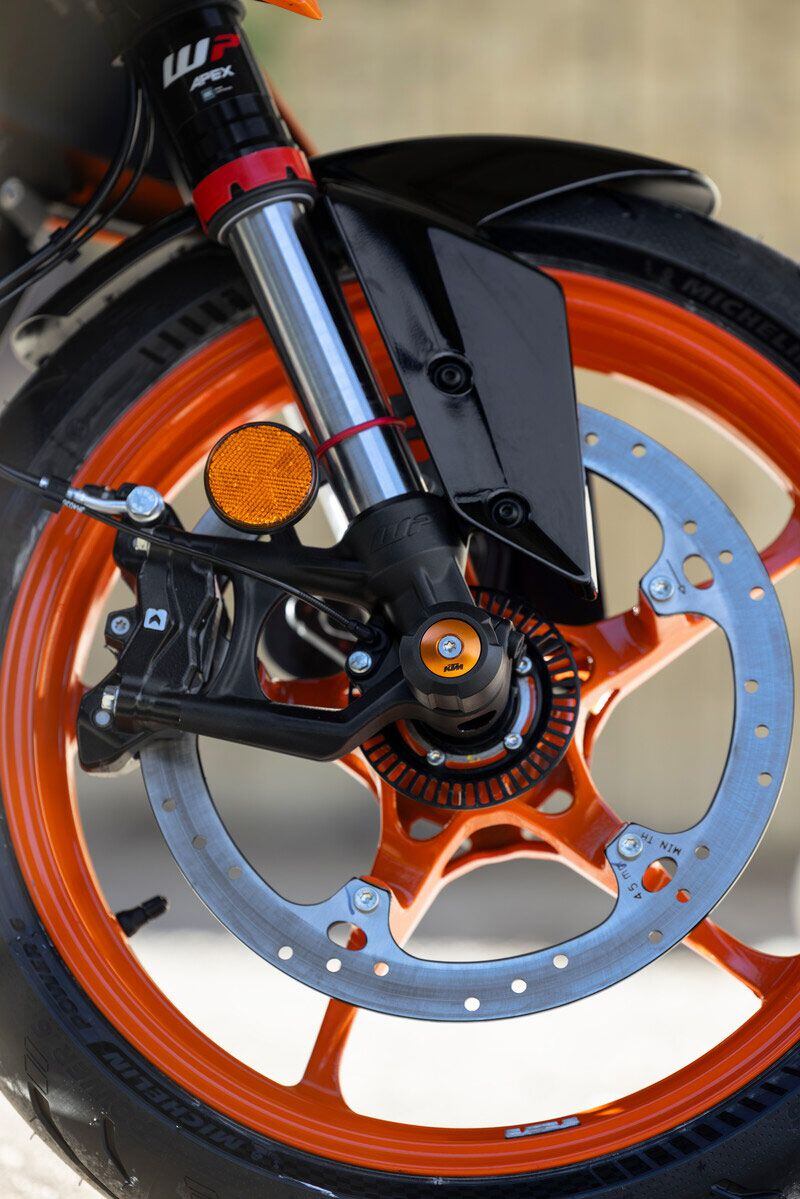
New wheels cut nearly 10 pounds from the 390 Duke’s unsprung weight. (KTM/)The original 390′s banana-style swingarm returns, while higher-spec WP Apex suspension adjustable for both rebound and compression at the front, and for rebound and preload at the rear, replaces the nonadjustable units of the outgoing 390.
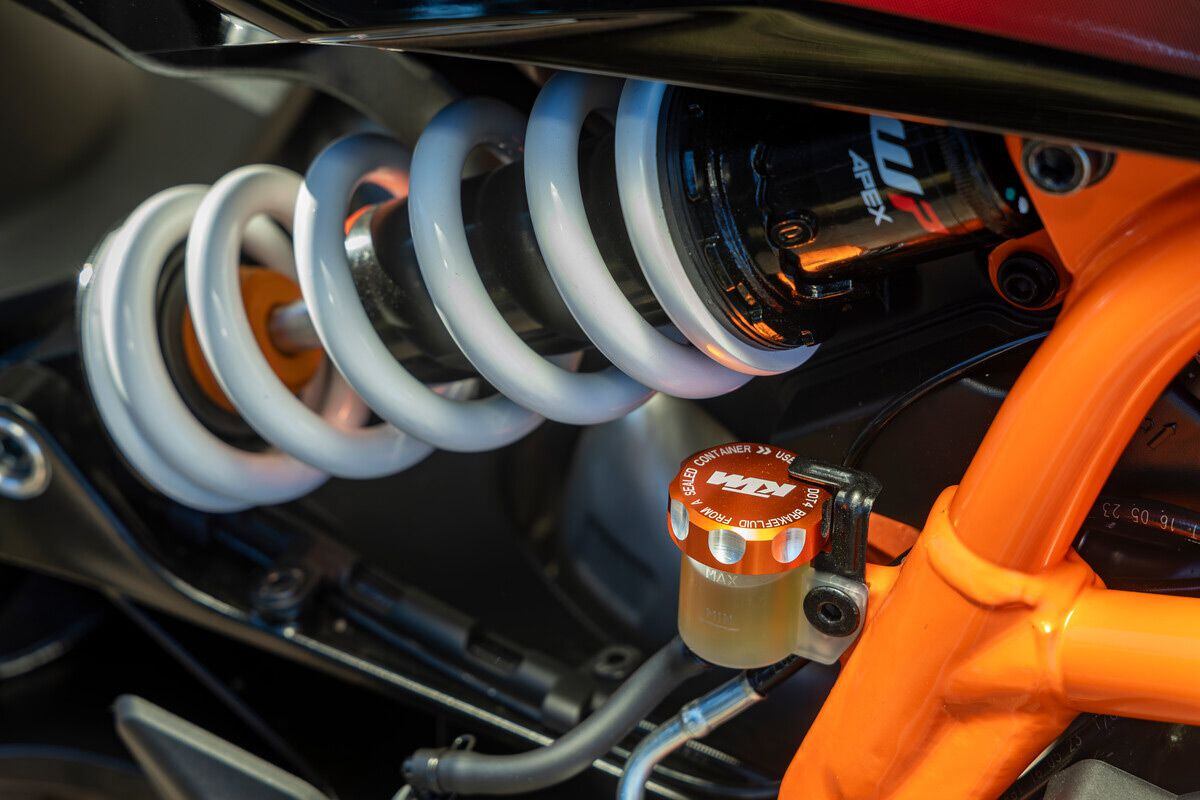
The rear shock is adjustable for preload and rebound. (KTM/)Brakes retain the 2023 bike’s single, radial-mount four-piston ByBre caliper with a 320mm disc at the front and two-pot caliper paired to 240mm disc at the rear, although both are relocated to the right side of the machine for styling purposes.
Handling
Out in the stunning hills near Malaga in southern Spain, the chassis updates are as obvious as those to the engine. The Apex fork generates sporty feedback and control, and performs well above the bike’s sub-$6,300 price tag. That new side- and directly-mounted shock feels a little firm at the bottom of its stroke, something exacerbated by a thin seat.
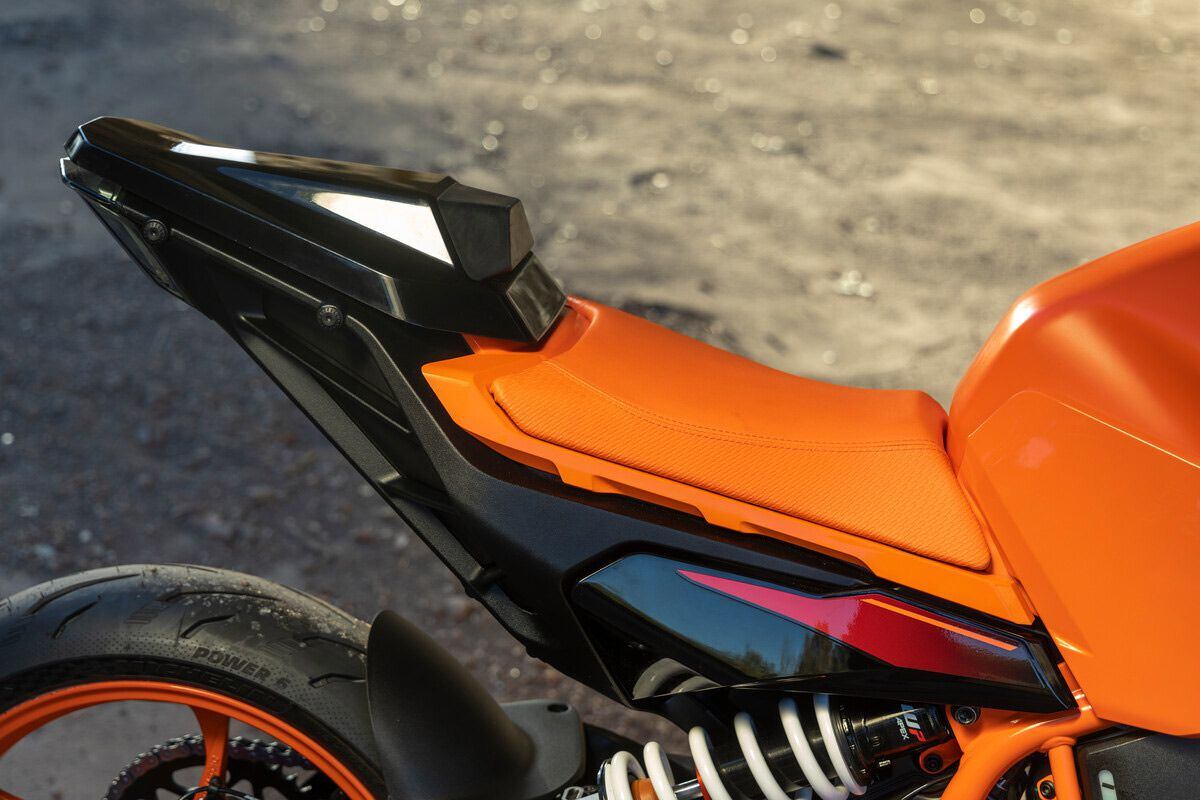
A thin seat does wear on the rider fairly quickly—this is not a touring motorcycle, no doubt. (KTM/)The steering is, of course, supremely light, the turn-in to the apex so quick and accurate—so addictive on twisty asphalt!—you begin to wonder why anyone bothers with bigger, heavier machines. Crucially, the 390 is reassuringly stable at speed, and not at all flighty like some lightweights can be. Michelin Power 6 tires are a solid choice of rubber, but fit some sticky racetrack tires and the 390 Duke would indeed be ready to race.
Brakes
Even the brakes, reportedly unchanged, feel sharper and better. This might be down to the superb feedback from the new fork, or perhaps, the much-reduced unsprung weight of the new wheels. Either way, they match the chassis’ finessed agility, working hard with just a gentle squeeze on the lever. Meanwhile, the lean-sensitive ABS isn’t too intrusive while being a huge safety net for new riders.
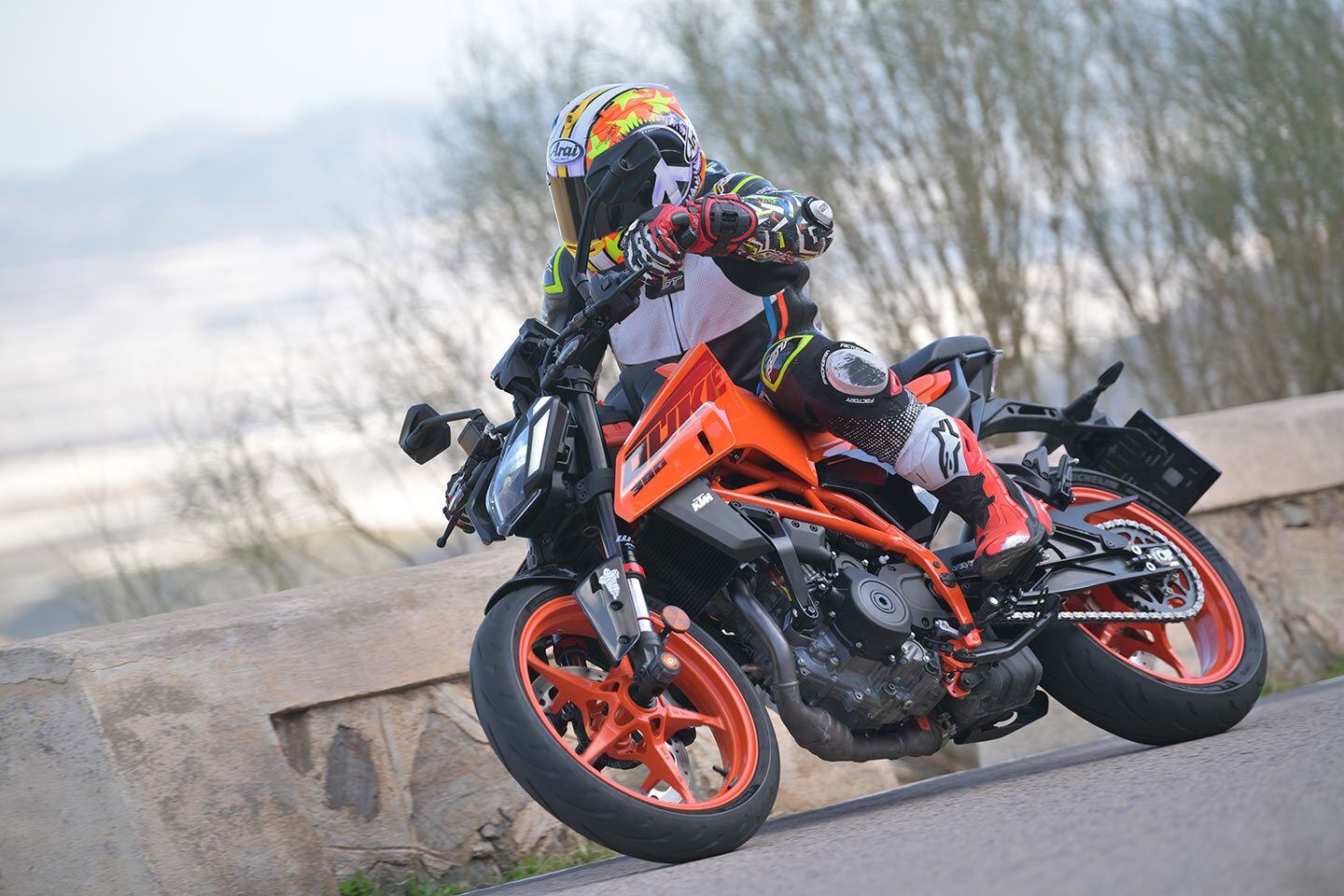
ABS isn’t too intrusive, despite the entry-level status of the 390 Duke. (KTM/)As you’d expect, the 390 is fuel efficient. KTM claims 67 mpg (US). After 80 miles of largely immature riding, we averaged 49 mpg (US), which is excellent considering the throttle was wide open for much of the time. With a 4-gallon fuel tank that equates to around 190 to 250 miles between fill-ups.
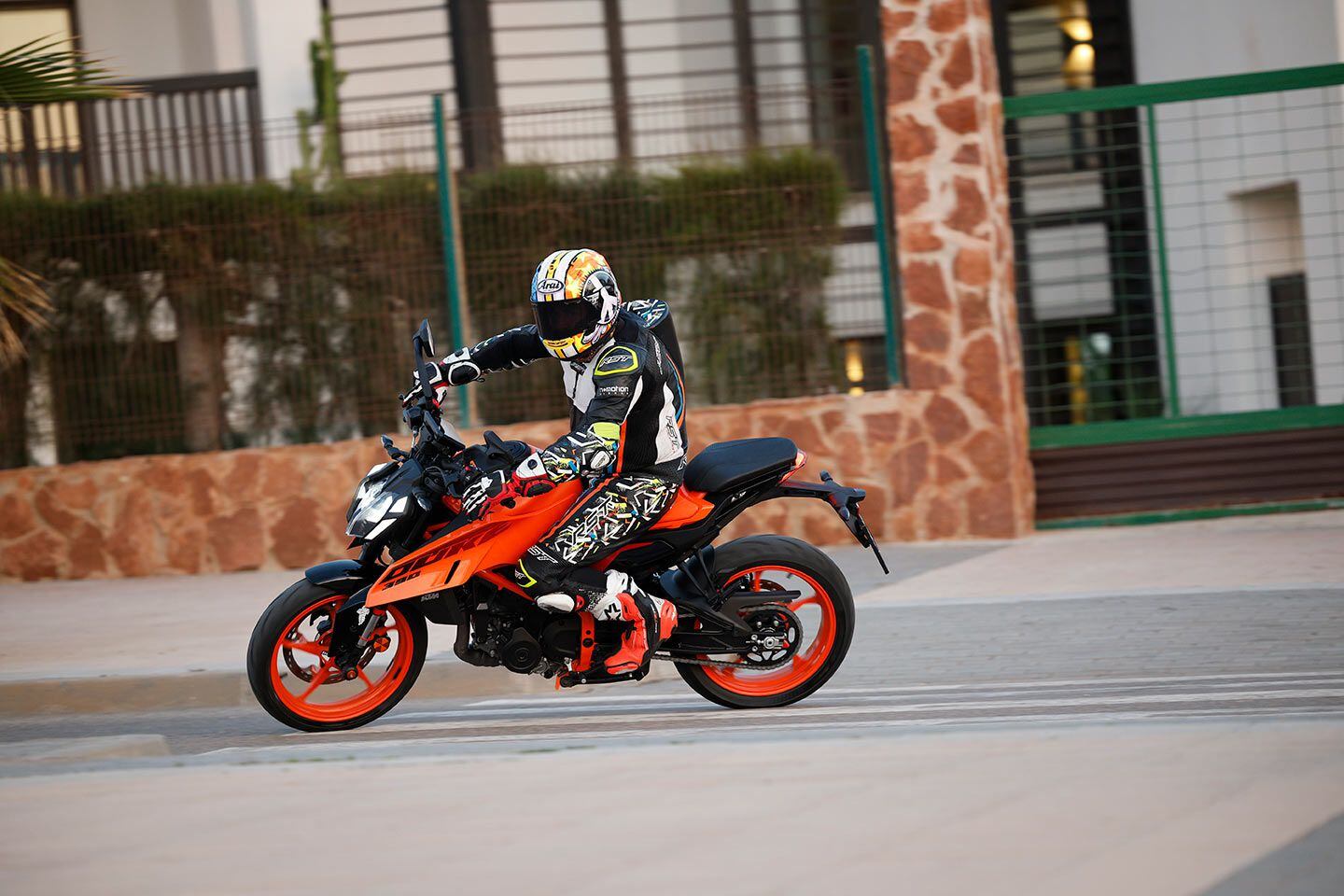
Around town and commuting, the 390 Duke is capable and fuel efficient. (Full leathers not required in town…) (KTM/)Despite that decent range, you’d be hard-pressed to volunteer for a touring trip. KTM has tried to make the 390 as accessible as possible, and the seat is even lower, down by 0.4 inch to 32.3 inch, but comfortable it is not. At only 5-foot-7, I wasn’t too cramped but taller and heavier riders suffered in Spain as the seat is firm and the direct-mounted WP suspension lacks plushness over big bumps.
Conclusion
The Duke’s price has been confirmed at $6,299, despite its raft of new technology and a higher-end finish. We can assume some of this cost saving is down to the bike being produced in India, not Austria like the larger 990 and 1390, because it’s something of a challenge to see where KTM has otherwise saved on costs.
The switch gear is unremarkable and you could argue the 390 lacks the solidity of the other bikes in this class. But it comes with lean-sensitive rider aids, riding modes, launch control, a pit-lane limiter, adjustable and quality WP suspension, and decent rubber. With that state-of-the-art TFT dash with connectivity and bold looks, it should appeal to all young riders with a sporty outlook. Oh, and it really is ready to race.
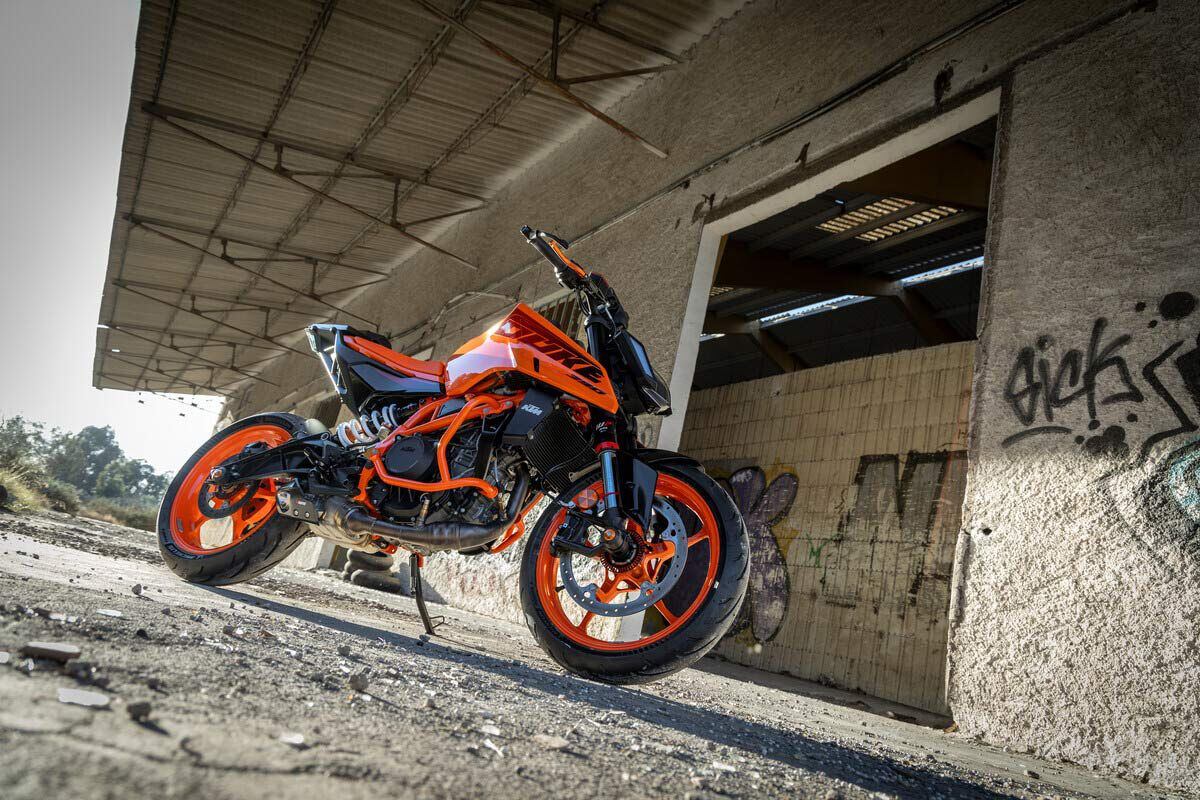
Even though it’s the smallest Duke and meant for newer riders, the 390 Duke still sticks to the KTM promise of “ready to race.” (KTM/)2024 KTM 390 Duke Specs
MSRP: $6,299 Engine: DOHC, liquid-cooled, four-stroke single-cylinder Displacement: 399cc Bore x Stroke: 89.0 x 64.0mm Transmission/Final Drive: 6-speed/chain Claimed Horsepower: 44.3 hp @ 8,500 rpm Claimed Torque: 28.8 lb.-ft./39Nm @ 7,000 rpm Fuel System: Bosch EMS w/ ride-by-wire Clutch: Wet, multiplate, antihopping; mechanical actuation Frame: Steel trellis frame Front Suspension: 43mm WP Apex, compression and rebound damping adjustable; 5.9 in. travel Rear Suspension: WP Apex monoshock, spring preload and rebound damping adjustable; 5.9 in. travel Front Brake: Radial fixed 4-piston caliper, 320mm disc Rear Brake: 2-piston floating caliper, 240mm disc Seat Height: 32.3 in. Fuel Capacity: 4.0 gal. Claimed Wet Weight: 364 lb. Contact: ktm.com -
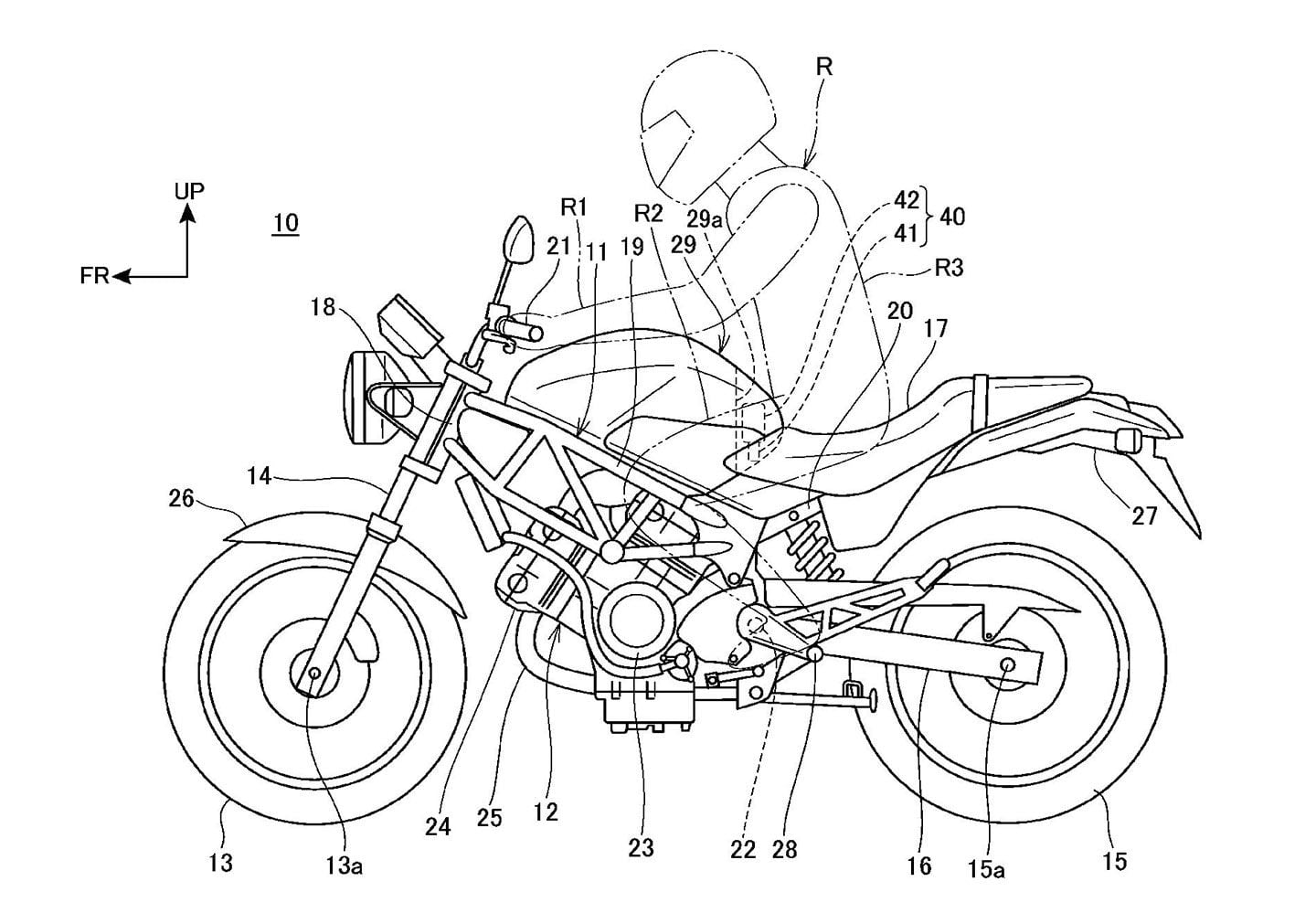
Honda’s concept is designed to deploy the airbag from the back section of the tank, with the airbag wrapping around the rider and then detaching so that when the rider leaves the bike, the airbag will be with them. (Honda/)Motorcyclists often have a strange relationship with safety. We all acknowledge that we do something that poses a risk but ideas to mitigate that danger are often eyed with suspicion. But a new airbag system under development at Honda could be a game-changer—decreasing the chance of injuries in the event of a crash but without any onus on the rider to change their habits.
Like ABS and traction control, airbags are one of those safety aids that first got a foothold in cars, and which manage to be unobtrusive. Unlike safety ideas that require the user to proactively buy into them such as seatbelts in cars, for instance, or helmets for motorcycles, car airbags are something we can simply take for granted right until the moment you need them.
On motorcycles, that sort of airbag isn’t a reality yet. Yes, we can choose to wear airbag-equipped riding gear—but Murphy’s Law says that the day you need it will be the one when you choose not to put it on. Alternatively, Honda has been selling airbag-equipped Gold Wings since 2007, but the Wing’s car-style airbag works specifically on that large touring motorcycle and still hasn’t been adapted to fit on more conventional two-wheelers. Last year we saw Honda’s first patent illustrating a new type of airbag that solves both problems, and now the company has filed more detailed documents about the same system, showing it’s still under development and being refined toward a potential production future.
Related: Alpinestars Tech-Air Off-Road Review
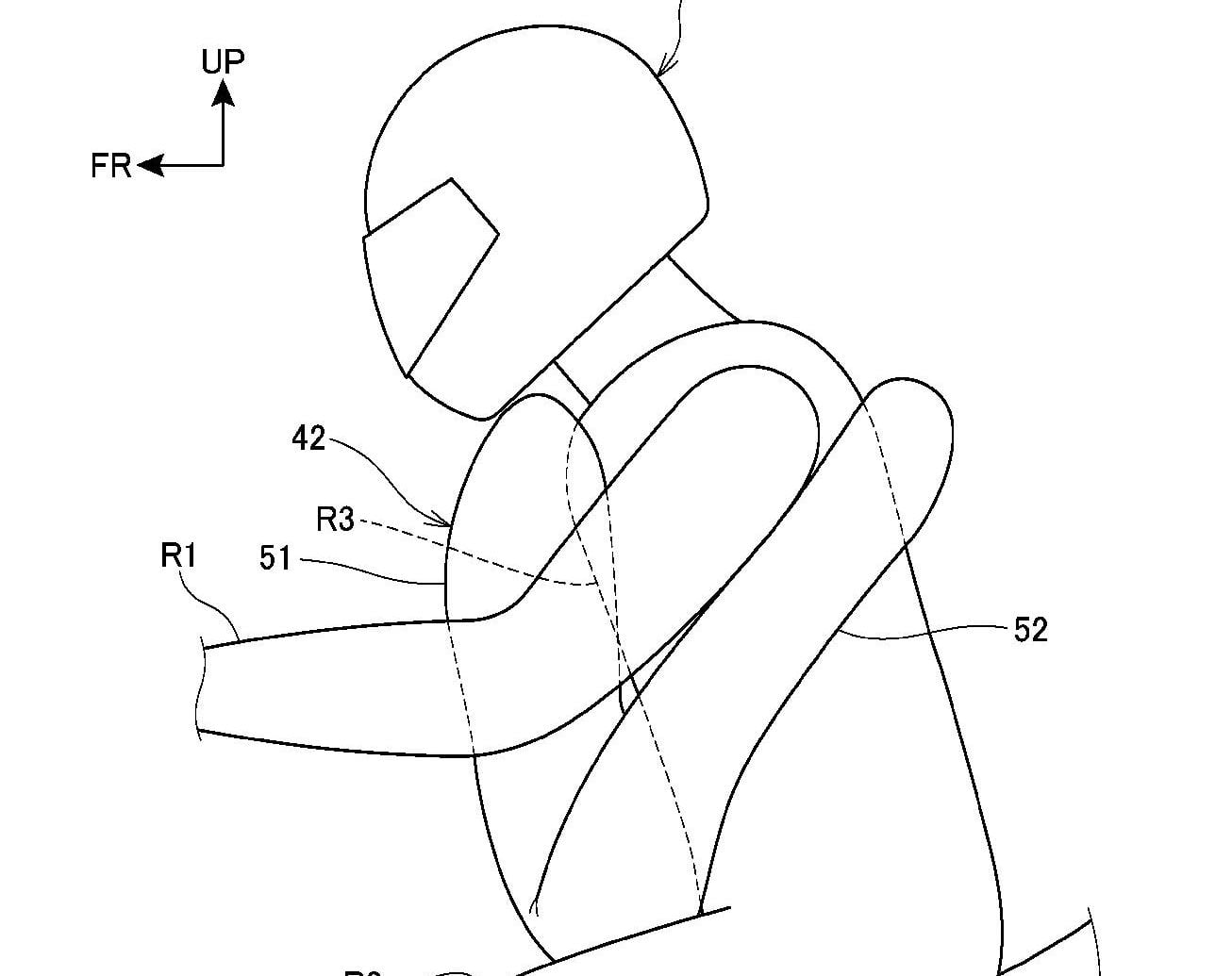
The proposed airbag would wrap around the rider’s torso. (Honda/)The idea is to create an airbag that, like those in cars, doesn’t need to be visible or thought about, but when activated it works more like a wearable airbag than the car-style design used on the current Gold Wing. It’s illustrated as being mounted in the rear section of a bike’s fuel tank area, under a cover, and when activated by an acceleration sensor that can detect impacts, it inflates. So far it appears to be a conventional airbag. But there are two key differences. The first is the bag’s shape. Instead of a balloon-like design it’s sculpted into a “W” shape, with outer sections that extend under the rider’s arms and a central part that goes against their chest. As it fills with air, it wraps around the rider and holds them, rather like a life jacket.
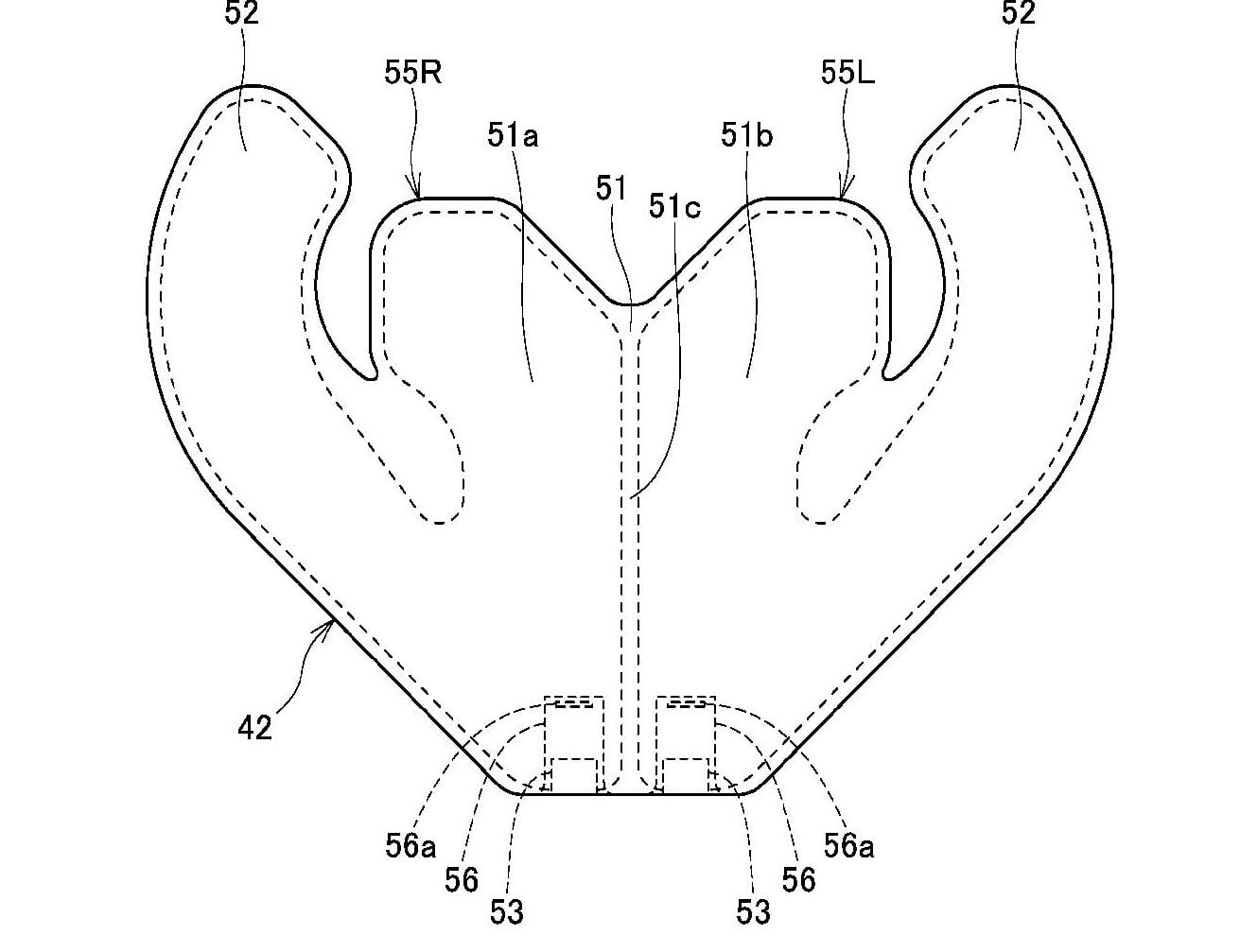
A closer look at the shape of the airbag. (Honda/)The second difference is that, once inflated, the airbag detaches from the bike and its inflators—two inflators are used—seal themselves to maintain pressure. It all happens in a fraction of a second, as soon as an impact is detected and before the rider separates from the bike, so when the rider does come off, the airbag remains wrapped around them, not attached to the bike. The result is like having a protective jacket that you weren’t wearing when the accident started.
Honda’s latest patent on the system revolves around the complexities of the separation system, showing how the airbag detaches once the pressure inside it equalizes with the pressure inside the two inflators. It’s a design that needs to be relatively simple to keep costs down and to ensure reliable operation without multiple electronic or moving parts, so when activated—even after years of dormancy—it can be relied upon to do its job.
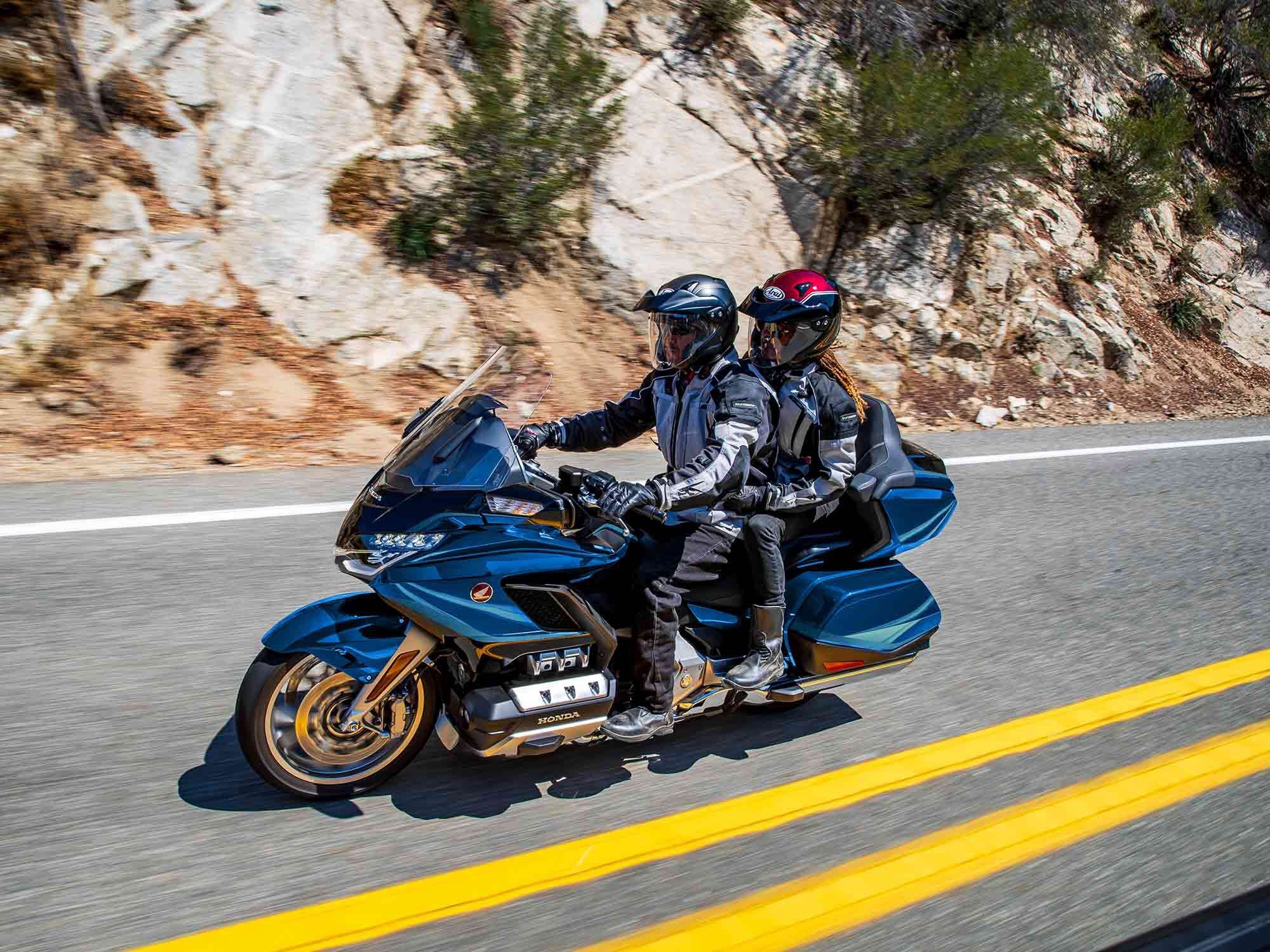
An airbag-equipped Gold Wing has been available since 2007. (Honda/)As usual with technical patents, it’s impossible to guess how soon this idea might reach production but Honda has now filed so many patents related to this concept that it’s impossible to conclude that it’s anything other than a serious R&D project. The potential benefits are huge and given Honda’s stated aim to eliminate fatalities involving its motorcycles or cars by 2050—just 26 years from now—it makes sense to prioritize it. And there are commercial benefits on offer too: A bike that can be proven to be safer than others will be a big draw, particularly when it comes to attracting new riders who might be unsure about making the leap to two wheels.
-
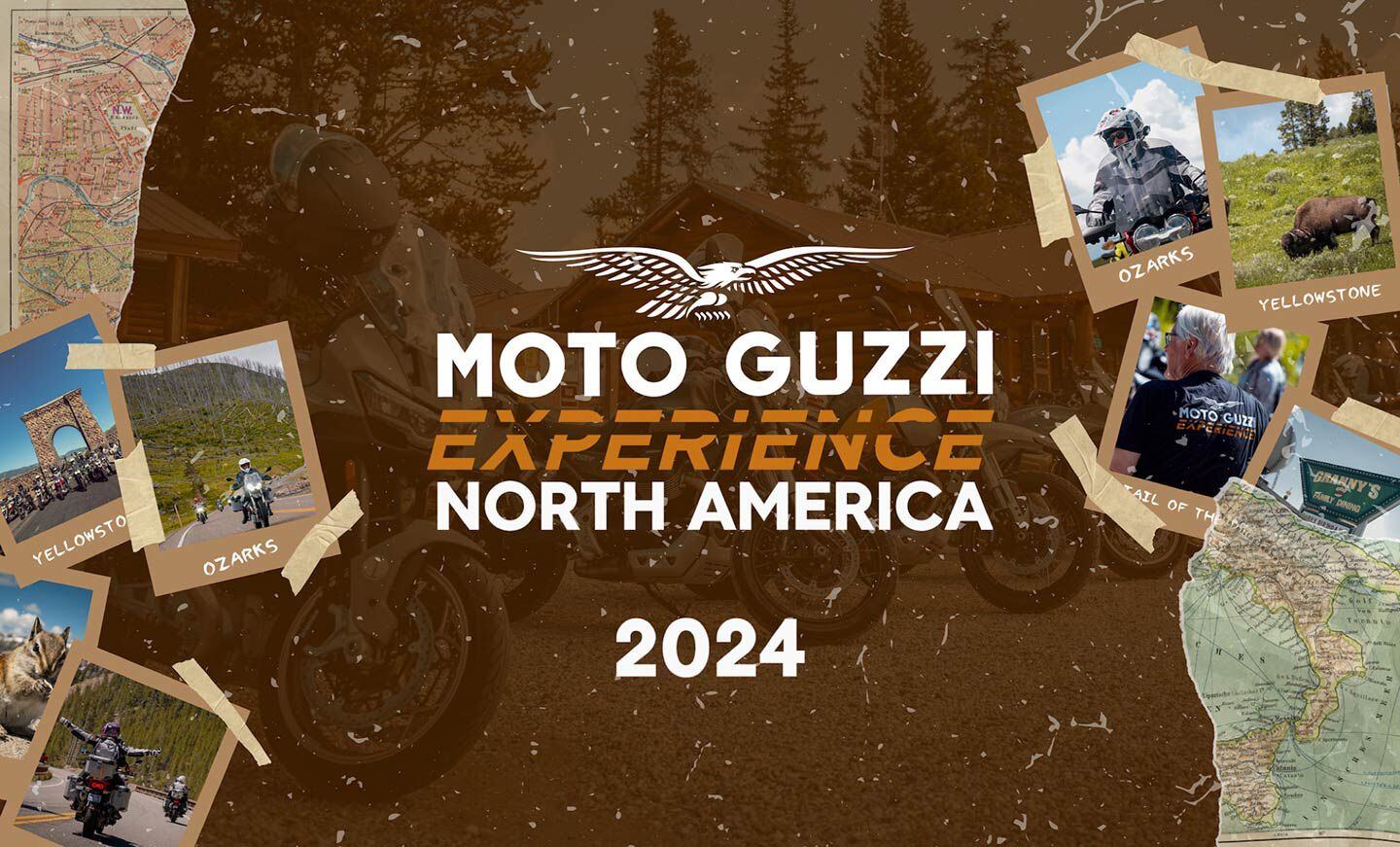
2024 Moto Guzzi Experiences Announced For America (Moto Guzzi/) Moto Guzzi Press Release:
BUCKETLIST TOURS ACROSS THE UNITED STATES, MATCHING PICTURESQUE DESTINATIONS WITH SOME OF THE COUNTRY’S MOST CELEBRATED ROADWAYS ON THE LATEST MOTO GUZZIS
THE YELLOWSTONE AND SMOKY MOUNTAIN TOURS OF PAST YEARS, WELCOME THE ADDITION OF EXPERIENCES IN THE PACIFIC NORTHWEST AND SOUTHERN ROCKIES, ALONG WITH THE ARRIVAL OF THE NEW 2024 MOTO GUZZI STELVIO
Moto Guzzi is happy to announce the highly anticipated 2024 Moto Guzzi Experience in the United States. This exclusive event invites customers to join the marque on an unforgettable journey through some of the country’s most picturesque and desirable routes aboard the latest Moto Guzzi models.
Unlike any other ride experience, the Moto Guzzi Experience is not only about stunning scenery but also about rewarding riding. Participants will tackle some of the country’s most challenging and bucket-list-worthy roads and highways, offering a true test of skill and adrenaline.
“We are excited to invite Moto Guzzi enthusiasts to join us on the 2024 Moto Guzzi Experience,” said Marco d’Acunzo, President and CEO of Piaggio Group Americas, “This event series promises to be a one-of-a-kind opportunity to explore the beauty of the United States while experiencing the thrill of riding our latest Moto Guzzi models on some of the most iconic routes in this beautiful country.”
The 2024 Moto Guzzi Experience is open to riders of all skill levels, from seasoned adventurers to those seeking their next great ride. Spaces are limited, and interested participants, for those who look to rent a new Moto Guzzi or bring one of their own. Interested parties are encouraged to reserve their spot early to ensure they don’t miss out on one of these unforgettable journeys.
The 2024 Moto Guzzi Experience will showcase the brand’s commitment to adventure and exploration, offering participants the opportunity to ride the new Moto Guzzi Stelvio, V100 Mandello, and V85 models in four distinct tours:
- <b>Rocky Mountains, June 5-9, 2024 (3-day Ride)</b>
Traverse the breathtaking landscapes of the southern Rocky Mountains, taking in sweeping vistas, towering peaks, and winding mountain passes throughout Northern New Mexico, and Southern Colorado.
Tickets: https://motoguzzi.ticketspice.com/mg-exp-2024-rocky-mountains
- <b>Pacific Northwest, July 15-21, 2024 (5-day Ride)</b>
Explore the rugged beauty of the Pacific Northwest, from the lush forests and mountains of Oregon’s Cascade region out to the Blue Mountains alongside the meandering riverways of Eastern Oregon.
Tickets: https://motoguzzi.ticketspice.com/mg-exp-2024-pacific-northwest
- <b>Yellowstone, July 31 – August 5, 2024 (4-Day Ride)</b>
Embark on an epic journey inside and around Yellowstone National Park, where geysers, hot springs, and wildlife await amidst the stunning backdrop of the northern Rocky Mountains, on a tour that features exaggerated summits and exploits the breathtaking roads of Montana and Wyoming.
Tickets: https://motoguzzi.ticketspice.com/mg-exp-2024-montanawyoming
- <b>Smoky Mountains, September 11-16, 2024 (4-Day Ride)</b>
Conquer the legendary Tail of the Dragon and experience the thrill of riding some of the country’s most technical and exhilarating roads on a tour that takes you back and forth between Eastern Tennessee and North Carolina, around the Blue Ridge and Smoky Mountains’ best roads.
Tickets: https://motoguzzi.ticketspice.com/mg-exp-2024-tail-of-the-dragon
For more information and to register for the 2024 Moto Guzzi Experience
Visit https://www.motoguzzi.com/us_EN/experience/ or reach out to the brand directly at [email protected]
-
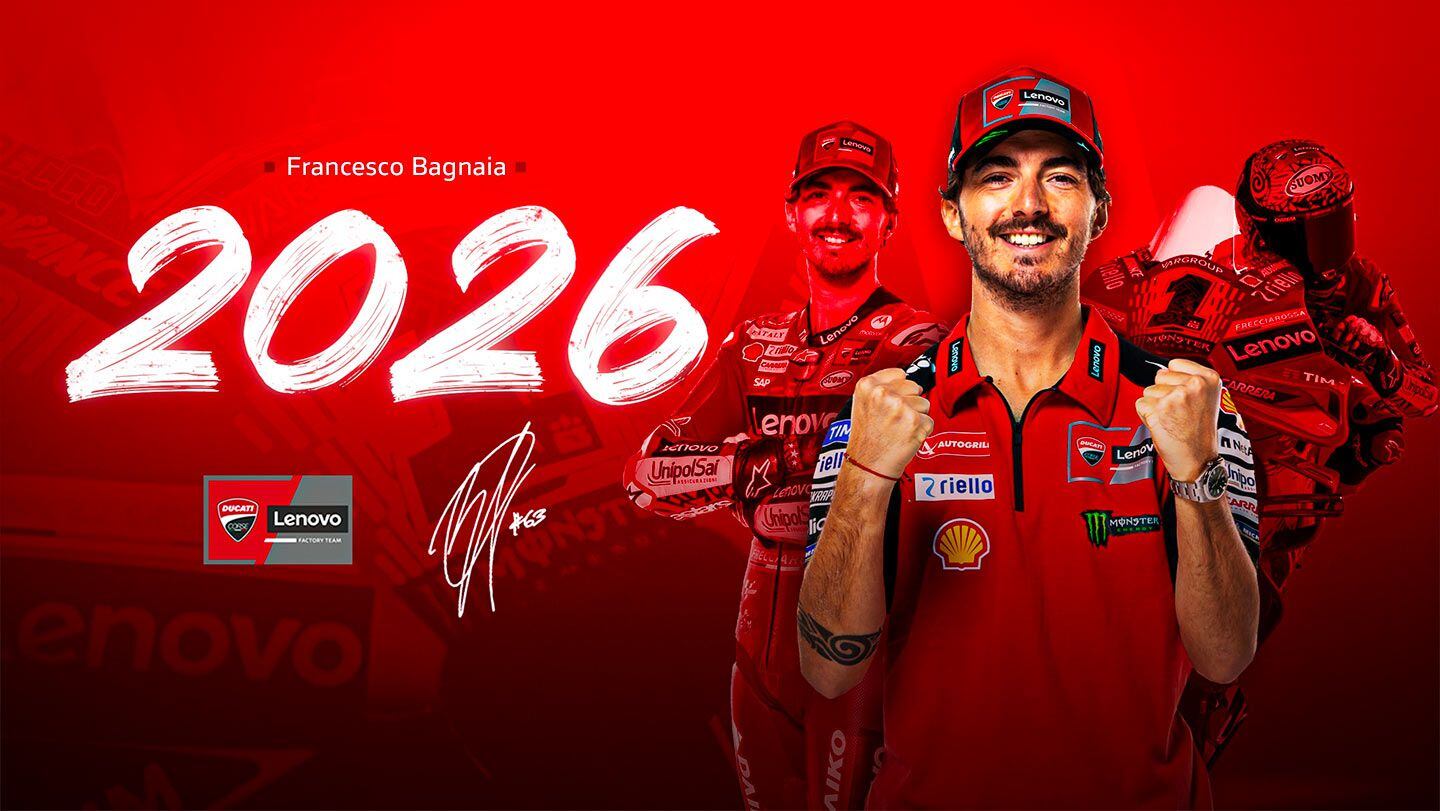
Ducati Corse and Francesco Bagnaia Sign Renewal for Another Two Seasons (Ducati/) Ducati Press Release:
Just days before the start of the 2024 MotoGP World Championship, Ducati Corse and Francesco Bagnaia solidified their future together by putting pen to paper, announcing the signing of an agreement that binds the two-time MotoGP World Champion to the Borgo Panigale manufacturer for the 2025 and 2026 seasons as well.
The contract renewal ensures continuity for an all-Italian winning pair: a perfect combination of the technology and performance of the Desmosedici GP and the talent, passion, and determination of Francesco “Pecco” Bagnaia.
Born in Turin in 1997 and residing in Pesaro, Bagnaia joined Ducati with Pramac Racing in 2019. With the extension of his current contract, he will further solidify his place in the history of the Borgo Panigale manufacturer, becoming the second rider to be linked with Ducati for a total of eight years.
Bagnaia made a name for himself in 2020 by securing his first MotoGP podium in his home race at Misano Adriatico, and in 2021, he was promoted to the factory team. During his first year riding the red Ducati Lenovo Team machine, he narrowly missed out on winning the World Title, finishing as the runner-up after an exhilarating season finale. The year 2022 marked Bagnaia’s breakthrough, as he clinched his first MotoGP Riders’ World Title, also becoming the first Italian to do so on an Italian bike: the Desmosedici GP. This victory marked Ducati’s second Riders’ World Title, following Casey Stoner’s success in 2007, 15 years earlier. With the number 1 on his bike’s front fairing, Bagnaia was again crowned World Champion in 2023, thanks to another remarkable season that saw him claim 15 podiums, 7 victories, and 7 pole positions.
Francesco Bagnaia (#1, Ducati Lenovo Team)”I am so happy to continue racing with the team of my dreams! Wearing these colours is an honour for me. It’s fantastic and a source of pride. Together with Ducati, my team, and all the guys at Ducati Corse, we’ve achieved incredible things. In these three more years (including 2024) ahead of us, we’ll continue to give our best to achieve as much success as possible. I am overjoyed and ready to hit the track in Qatar for the first race of the year.
”Claudio Domenicali (CEO Ducati Motor Holding)”Pecco is truly the perfect rider for Ducati. He represents our values at their best: style, elegance, and performance. Not only is he fast, determined, and tenacious on track, but he also stands out for his elegance and education off the track. I am very happy for this renewal, which I am sure Ducatisti all over the world will welcome with enthusiasm.
”Luigi Dall’Igna (Ducati Corse General Manager)”We are extremely happy to have Bagnaia with us again for 2025 and 2026. Together, we have written an important page of motorcycling history: Pecco was the first Italian rider to win a World Title in MotoGP with an Italian bike, our Desmosedici GP. Together, we brought back a Riders’ World Title that had been missing for 15 years, and we did it again last year. He is a two-time World Champion and has proven on more than one occasion that he truly deserves the number 1 on the fairing of his bike. In addition to these results, Bagnaia continues to demonstrate that he is in perfect harmony with his bike and team. For all these reasons, it was natural for us to want to continue with him. Therefore, we look forward to this new chapter together, confident that we can achieve other important results.”
Statistics from 2019 to date
GP Starts with Ducati in MotoGP: 86
First GP: Qatar 2019
Wins: 18
First GP Win: Aragón 2021
Podiums: 35
First Podium: San Marino 2020
Pole Positions: 18
First Pole: Qatar 2021
Fastest Laps: 13
Points: 1085
World Titles: 2 (MotoGP 2023, MotoGP 2022)
Bagnaia and the Ducati Lenovo Team will hit the track for the opening Grand Prix of the 2024 MotoGP World Championship from March 8th to 10th at the Lusail International Circuit in Qatar.
-
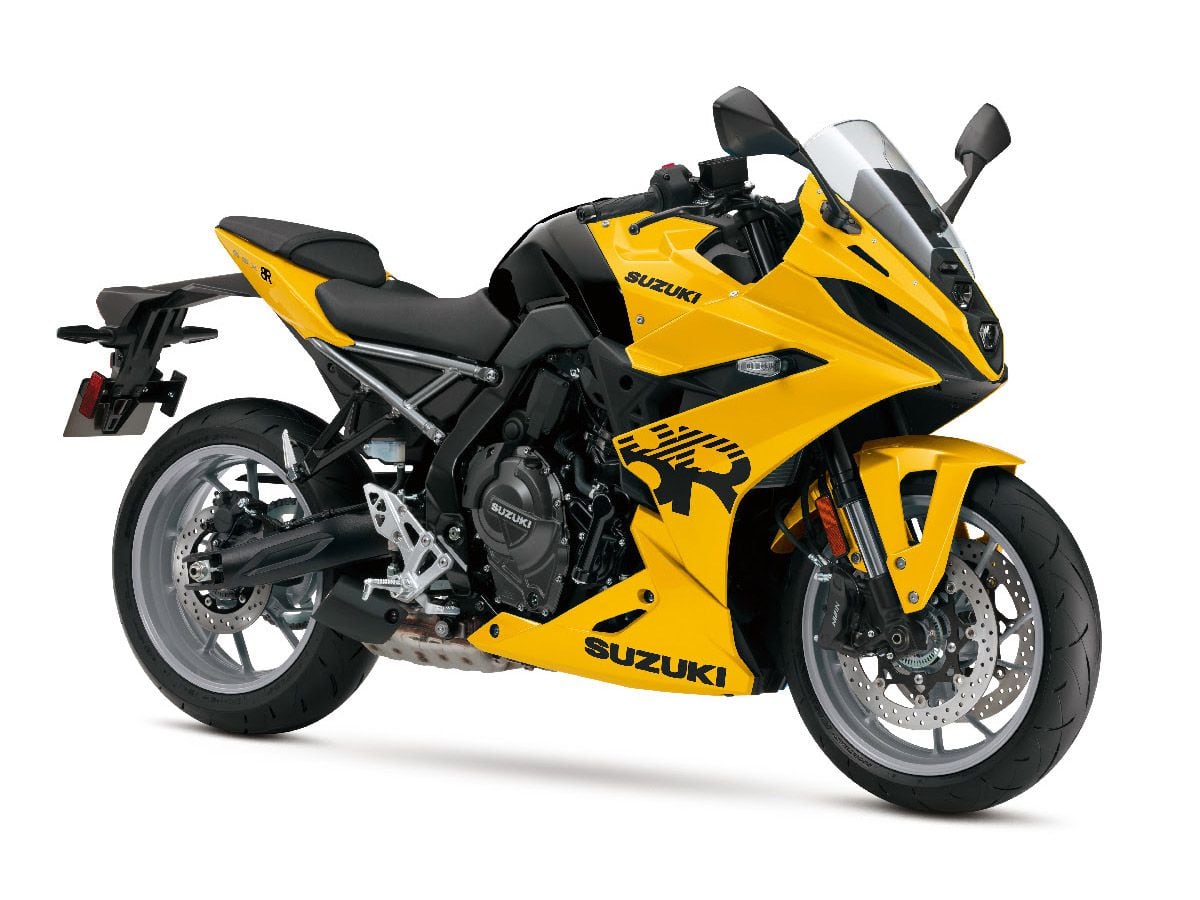
New for 2024, the Suzuki GSX-8R sportbike brings its spirited performance and fresh styling to Suzuki demo rides this year, starting with Daytona Bike Week. (Suzuki/)Suzuki Press Release:
Suzuki Motor USA LLC (Suzuki) has kicked off its 2024 Demo Tour with a full range of exciting 2024 models to demo ride and will be on the scene at some of motorcycling’s highest-profile events, as well as visiting Suzuki dealers nationwide.
The Tour gives riders a chance to throw their leg over and test-ride a wide range of awesome 2024 Suzuki motorcycles. The Tour launched at Bike Week at Daytona International Speedway March 1-9, 2024, in Daytona Beach, Florida.
You’ll have a great opportunity to test ride, experience, and learn more about Suzuki’s latest motorcycles on the Tour. Demo rides are available from 9:30 AM to 4:30 PM EST every day of Daytona Bike Week.
Riders looking to experience Suzuki’s latest and greatest may visit the Suzuki display at Daytona International Speedway. There, riders may book a Suzuki demo ride in just minutes.
The 2024 Suzuki Demo Tour features Suzuki’s world-class GSX-R and Hayabusa sportbikes, V-STROM adventure tourers, high-performance GSX-S1000GT+ sport-tourers, power cruisers, dual sports, and more.
In addition, Suzuki will have on display many fully accessorized models, custom bikes, Suzuki racing bikes, and a selection of Genuine Suzuki Accessories. Pro rider autograph sessions at key stops are also planned.
The 2024 Suzuki demo tour offers licensed riders seat time on the latest Suzuki models including:
• GSX-8R sportbike
• GSX-8S
• V-STROM 800DE and 800 Adventure Tourers
• V-STROM 1050DE and 1050 Adventure Tourers
• Hayabusa – the ultimate sportbike
• Hayabusa 25th Anniversary Edition
• GSX-R1000R, GSX-R750, GSX-R600 sportbikes
• GSX-S1000GT+ high-performance sport-tourers
• GSX-S1000
• DR-Z400S and DR-Z400SM Supermoto
• DR-650S DualSport
• M109R Power Cruisers and more
A key highlight of the Suzuki Demo Tour is the all-new Suzuki parallel-twin 800cc motorcycle range, headed up by the exciting new Suzuki GSX-8R sportbike, and including the GSX-8S standard as well as the V-STROM 800 range of adventure tourers.
The GSX-8R has been lauded by the press as the new standard in sport, and uses the powerful and compact new 776cc Suzuki parallel-twin engine cradled in a strong, compact frame. The GSX-8R rewards riders with performance, technology, and style to lead the middleweight class in rideability and fun.
With stellar performance and features, riders are sure to enjoy all the GSX-8R has to offer as well as the rest of the 800cc Suzuki middleweight line during Bike Week.
The Tour continues throughout 2024 with planned stops at key MotoAmerica races, the US round of MotoGP, displays at select NHRA drag races, key national and adventure rallies, and more. Not to mention tour stops at Suzuki dealerships around the US.
Visit SuzukiCycles.com/events for more information and to see the complete schedule of Suzuki demo ride events.
Demo riders interested in purchasing a new Suzuki will also find several aggressive retail offers entering the 2024 riding season by clicking to SuzukiCycles.com/offers. It’s never been easier than right now to demo and buy a phenomenal new Suzuki.
Click your browser or smartphone to SuzukiCycles.com often as demo events are added throughout the season. Be sure to keep an eye on Suzuki’s social media channels on Facebook, X, and Instagram @suzukicycles for information on upcoming events, locations, and times as more events are finalized.
There is no better way to explore and ride the new Suzuki you’ve been wanting than at a Suzuki Demo Tour event. Bring your gear and ride with us at the 2024 Suzuki Demo Tour at Daytona, or a Suzuki dealer or event near you.
-
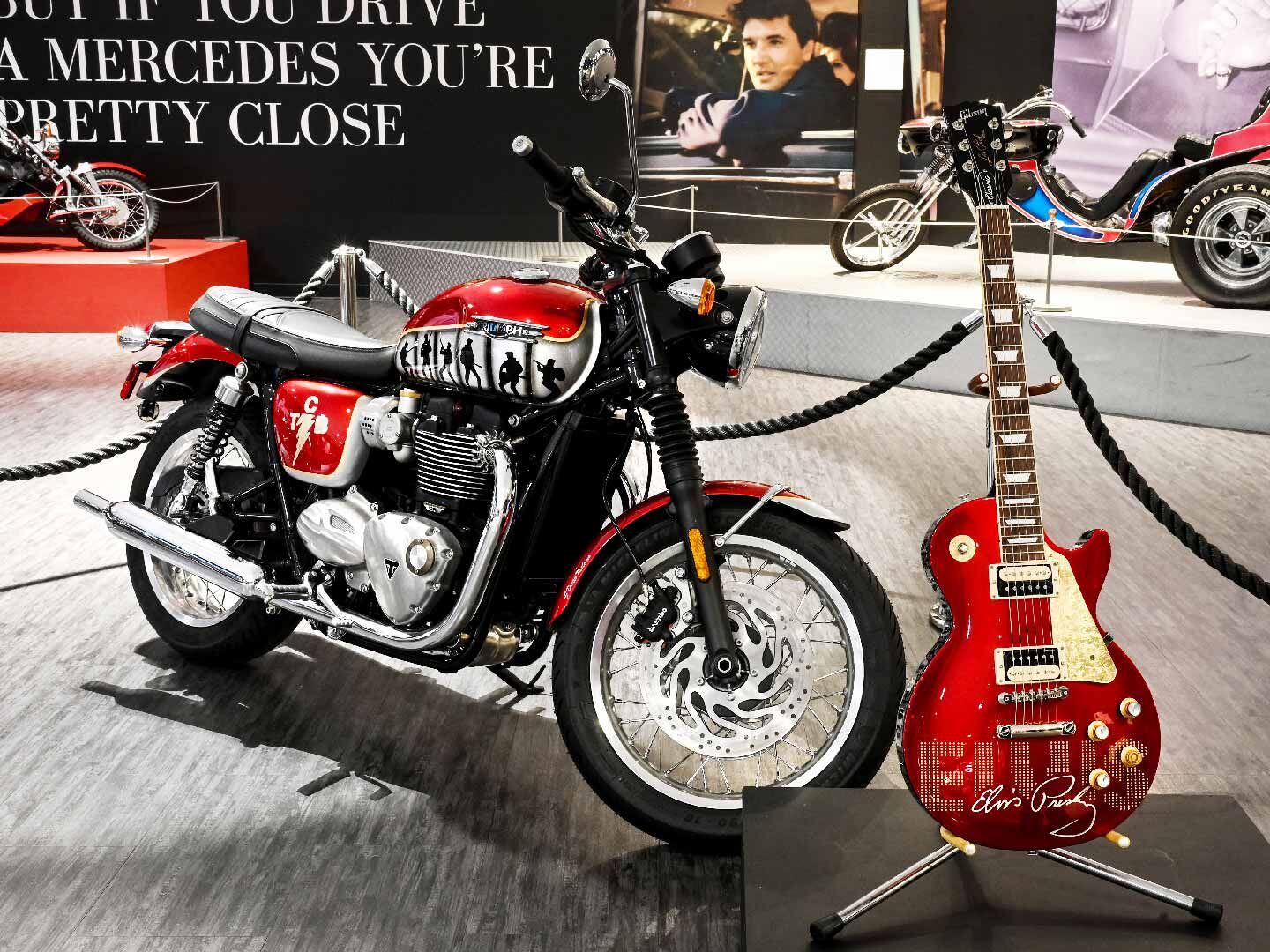
Sold! A Unique Presley Triumph Motorcycle and Gibson Les Paul Guitar Raise Thousands for Charity (Triumph/)Triumph Press Release:
A one-of-a-kind ‘Elvis Presley’ Triumph Bonneville motorcycle and matching Gibson Les Paul Guitar has sold for $20,000 USD at the Amelia Island Auction held by Bonhams|Cars on February 29, 2024. The auction was in aid of the Elvis Presley Charitable Foundation, who continue Elvis’ legacy of generosity by supporting numerous charitable causes.
This motorcycle, a brand-new range-topping T120 model, features a custom design by award-winning custom artist J Daar and is inspired by the original ‘Memphis Mafia’ Triumphs and the Bonneville Desert Sled which featured in the 1968 Stay Away, Joe movie. It is also influenced by Elvis’ iconic 1968 Comeback Special look, featuring red, silver and gold.
The bike was unveiled at the 2023 Barber Vintage Festival in Birmingham Alabama and has since been on display at Presley Motors Automobile Museum at Graceland.
The legendary musician and cultural icon was famously passionate about motorcycling. Elvis’ introduction to Triumph motorcycles was in 1965 while taking a break from filming, and spending time with his closest friends, known as the ‘Memphis Mafia’, at his Bel Air home. Friend Jerry Schilling had ordered a new Triumph T120 Bonneville and Elvis took it for a ride around the neighborhood. Elvis was impressed, and when he returned, he told his transportation manager, Alan Fortis, to “order one for all the guys, but...it has to be tonight!” Motorcycle dealers Bill Robertson & Sons managed to deliver seven Triumphs that night, and Elvis and his friends rode together around Bel Air late into the evening, only stopping when neighbors called the police to complain.
The matching Les Paul guitar, donated by Gibson, was also customized by artist J Daar and was offered for sale with the motorcycle. The choice of guitar was inspired by another instance of Elvis’ generosity; when rehearsing for the ‘68 Comeback Special, Elvis played a Les Paul, which he then gifted to his chef.
“This lot has clearly been a huge hit with Elvis and motorcycle fans, raising a fantastic figure for good causes,” said Paul Stroud, Chief Commercial Officer, Triumph Motorcycles. “The T120 and the Gibson guitar look, featuring custom designs by J Daar, look so distinctive and they are a wonderful tribute to the legend.”
Dana Carpenter, Executive Vice President, Entertainment at Authentic Brands Group, owner of Elvis Presley Enterprises added: “We are excited to partner with an iconic brand like Triumph to bring this one-of-a-kind custom Bonneville T120 to life while benefiting one of Elvis’ favorite charities. The added generosity of our friends at Gibson for contributing a matching custom Les Paul guitar, strengthens the legacy of generosity and community that Elvis Presley stood for.”
-
The R 1301 is a supermoto, naked bike, and adventure bike all mashed up into one.
-
 1
1
-
-
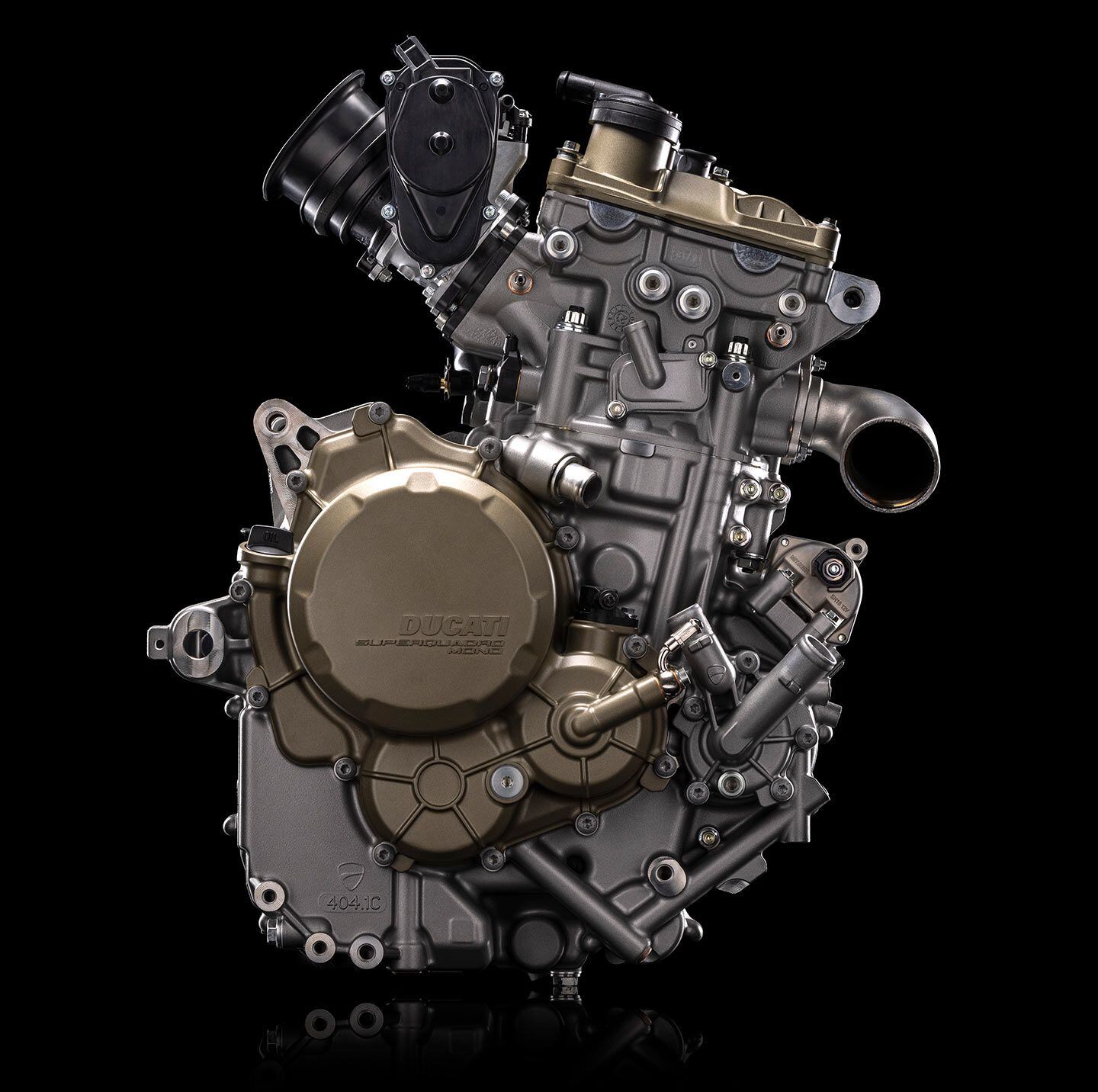
The compact house of power that is the 659cc single-cylinder desmodromic-head Superquadro Mono engine now introduced in the Hypermotard 698 Mono and Mono RVE. (Ducati/)New-model press releases almost always leave out some of the most interesting details about the development process, so we wanted to fill in those blanks on Ducati’s Superquadro Mono single-cylinder engine that powers the 2024 Ducati Hypermotard 698 Mono and 698 Mono RVE.
More basic than that, we wanted information seldom discussed in a press release: How did Ducati choose to design and build this unusual engine? What challenges did engineers encounter?
To answer these questions and more, Technical Editor Kevin Cameron and I arranged an hour of digital face-to-face time with Ducati Engine Development Manager Stefano Fantoni, and Product Communication Specialist Edoardo Licciardello.
It was said at the recent press introduction for the Hypermotard 698 Mono that the bike was a “passion project.” But we would ask what recent Ducati model wouldn’t be considered such?
So, aside from passion, how did this project come into being?
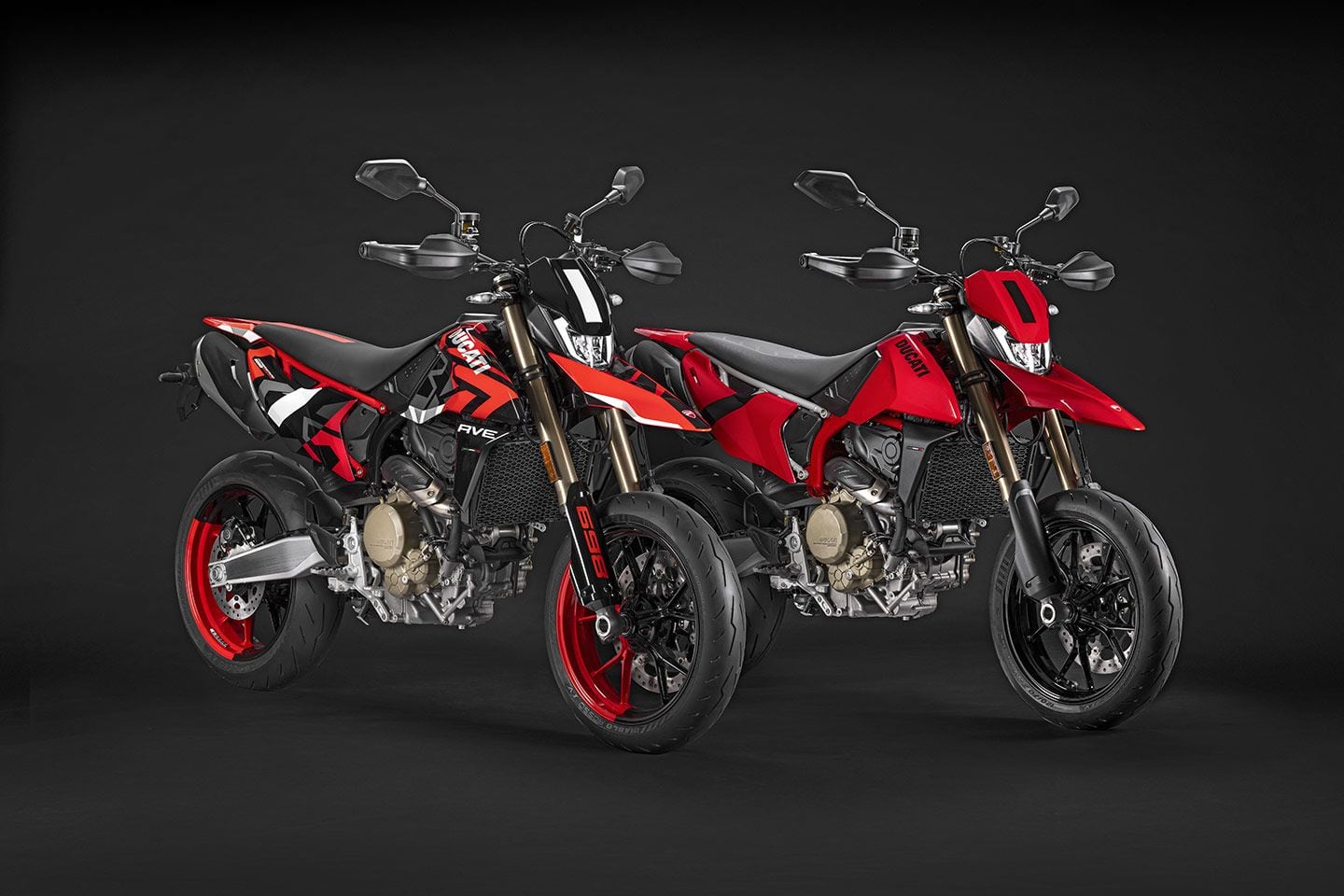
The $14,495 2024 Ducati Hypermotard 689 Mono RVE and standard $12,995 Mono mark Ducati’s return to a single-cylinder engine and entry into a new class and market. (Ducati/)“It was a marketing target to create a completely new engine,” Fantoni says. “Because Ducati would like to create a new vehicle that is light, slim, and has high agility, to deliver riding fun in twisty roads and city streets. We also had in mind that this vehicle can be appreciated in Supermotard use. It is directed toward new Ducatisti—young people who come to the Ducati world for the first time.” Ducati says its target customer for the Hypermotard 698 Mono is around 25 years old.
Creating paths into the brand is a never-ending conversation at motorcycle companies, particularly as it relates to young people, because loyalty is often fostered over generations. As an example, after 15 years Victory managed to grow annual sales volume to something on the order of 10,000 motorcycles. When Polaris launched Indian, total motorcycle sales for the company more than doubled in the first year. After that, Indian kept growing and Victory sales declined. Polaris ultimately closed Victory to concentrate on the historic brand whose name and style resonated in the larger culture across generations. There was simply a higher return on every dollar invested in Indian.
This also underlines that even with passion projects, motorcycle making remains a business. How do we sell more?
Related: 2025 KTM 690 SMC R and Enduro R Spied
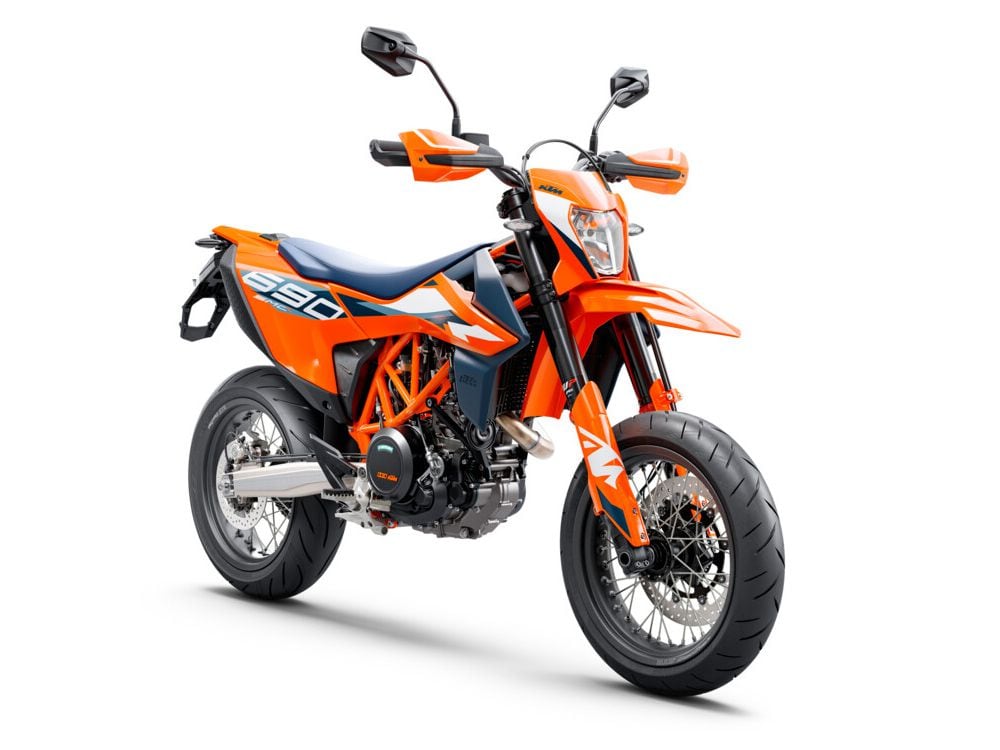
Ducati openly states both in this interview and in the press information from the Hypermotard 698 Mono product launch that it is targeting the KTM 690 SMC R and its Pierer Mobility stablemates, the GasGas SM 700 and Husqvarna 701 Supermoto. Fun motorcycles make an excellent target. (KTM/)“This segment is roughly 7,000–8,000 units yearly, worldwide, with what is substantially the same bike from KTM/GasGas/Husqvarna,” Licciardello says. “Even if we manage to sell one-quarter to one-third of this total yearly, for a small house like Ducati, with 60,000 worldwide sales, they are significant numbers.”
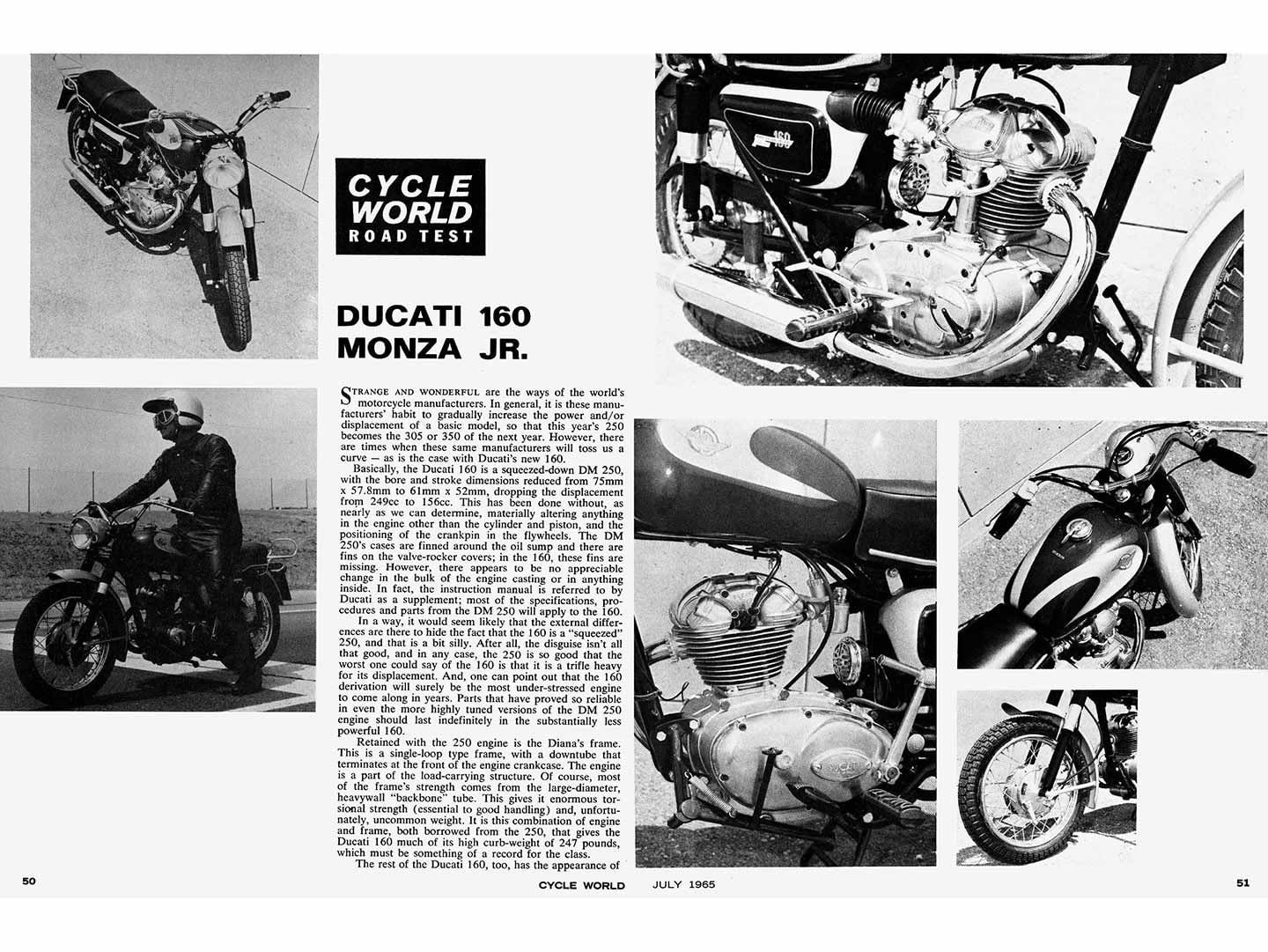
<i>Cycle World</i> road test of the 1965 Ducati 160 Monza Jr. Ducati was first a singles company, and then essentially combined a pair of single top ends on a common crankcase to deliver its first 90-degree V-twin. (Cycle World Archive/)In motorcycles, Ducati began as a singles company. In the 1970s as the superbike was born and Honda CB750 Fours and others filled great demand, Ducati became a twins company by taking its bevel-driven overhead-cam singles (both desmo and spring head), and combining them into the 90-degree V-twin that defined the brand for decades.
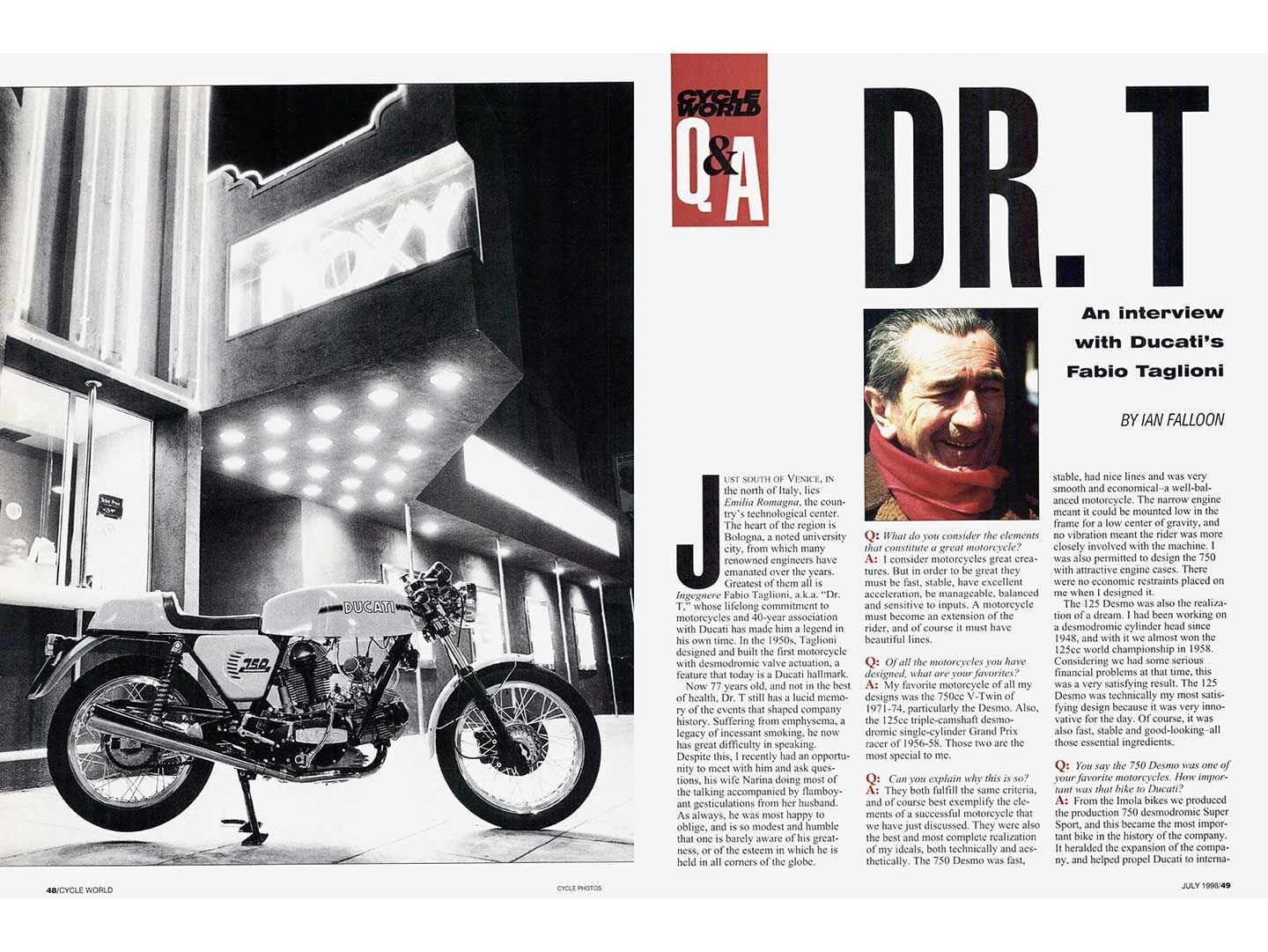
Can’t mention classic Ducatis without mentioning Dr. Fabio Taglioni, the man responsible for bringing Ducati’s first V-twin to life. (Cycle World Archive/)When in 1993 the Ducati Supermono 549cc single was introduced, it was a 90-degree V-twin with the vertical cylinder removed, but it kept the connecting rod and a piston-weight mass at the end of that rod working on an internal pivot, and in this way was perfectly balanced.
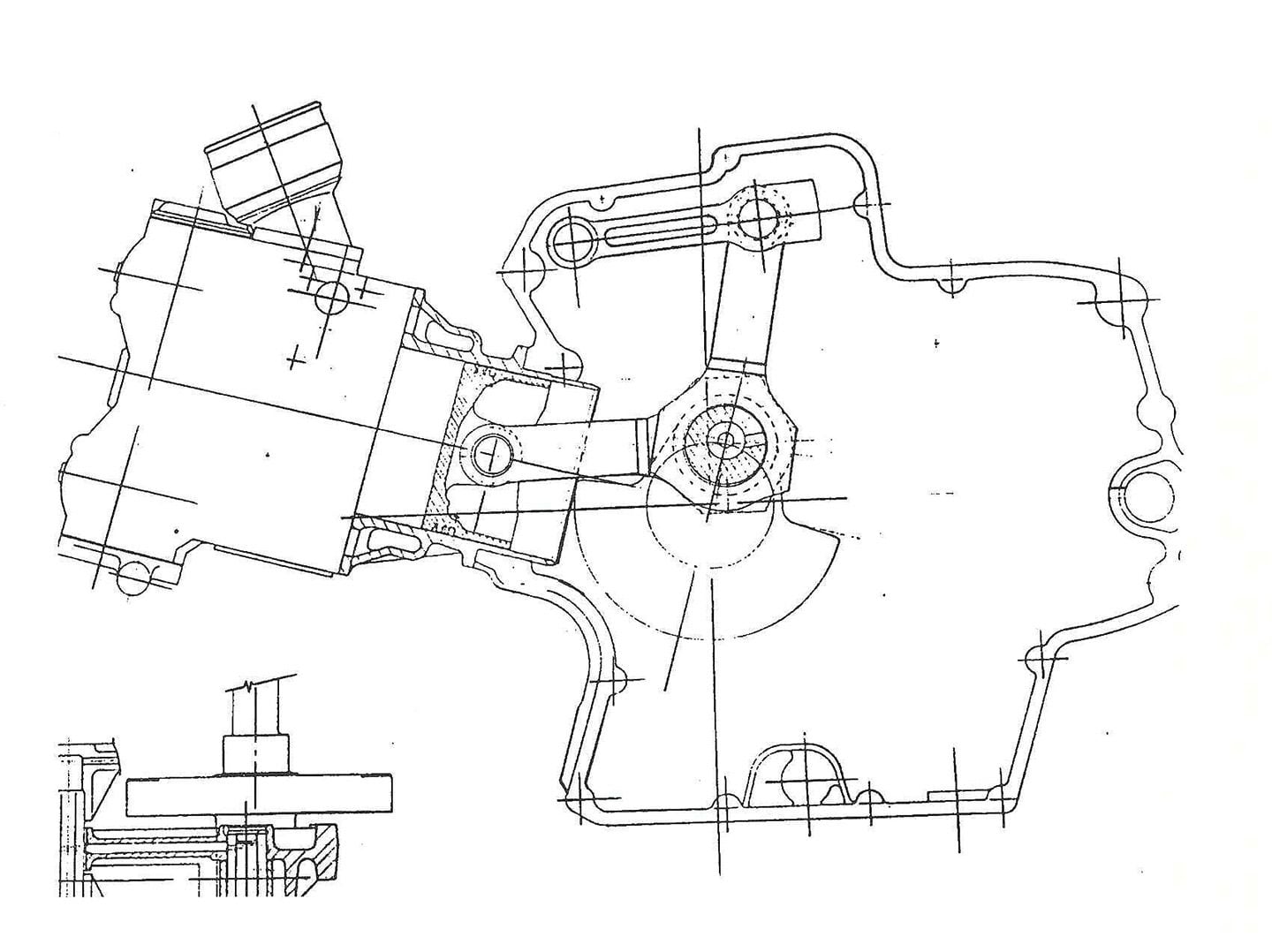
This is a direct scan of the fax Ducati sent to <i>Cycle World</i> for the 1993 Kevin Cameron tech story on the Supermono single—right out of the archive. The horizontal cylinder remains but the vertical cylinder was removed. The vertical cylinder connecting rod operated a reciprocating weight that made this single as smooth and balanced as a twin. (Cycle World Archive/)It makes sense as Ducati returns to single-cylinder engines that it would take a slice of its recent superbike to build this new 659cc single.
“Our first idea was to take from our history: the big-bore 1299 Panigale engine that was the most advanced V-twin engine Ducati ever produced,” Fantoni says. “From this basis we started to develop this engine.”
Related: What Is The Nature Of The Combustion Chamber Shape?
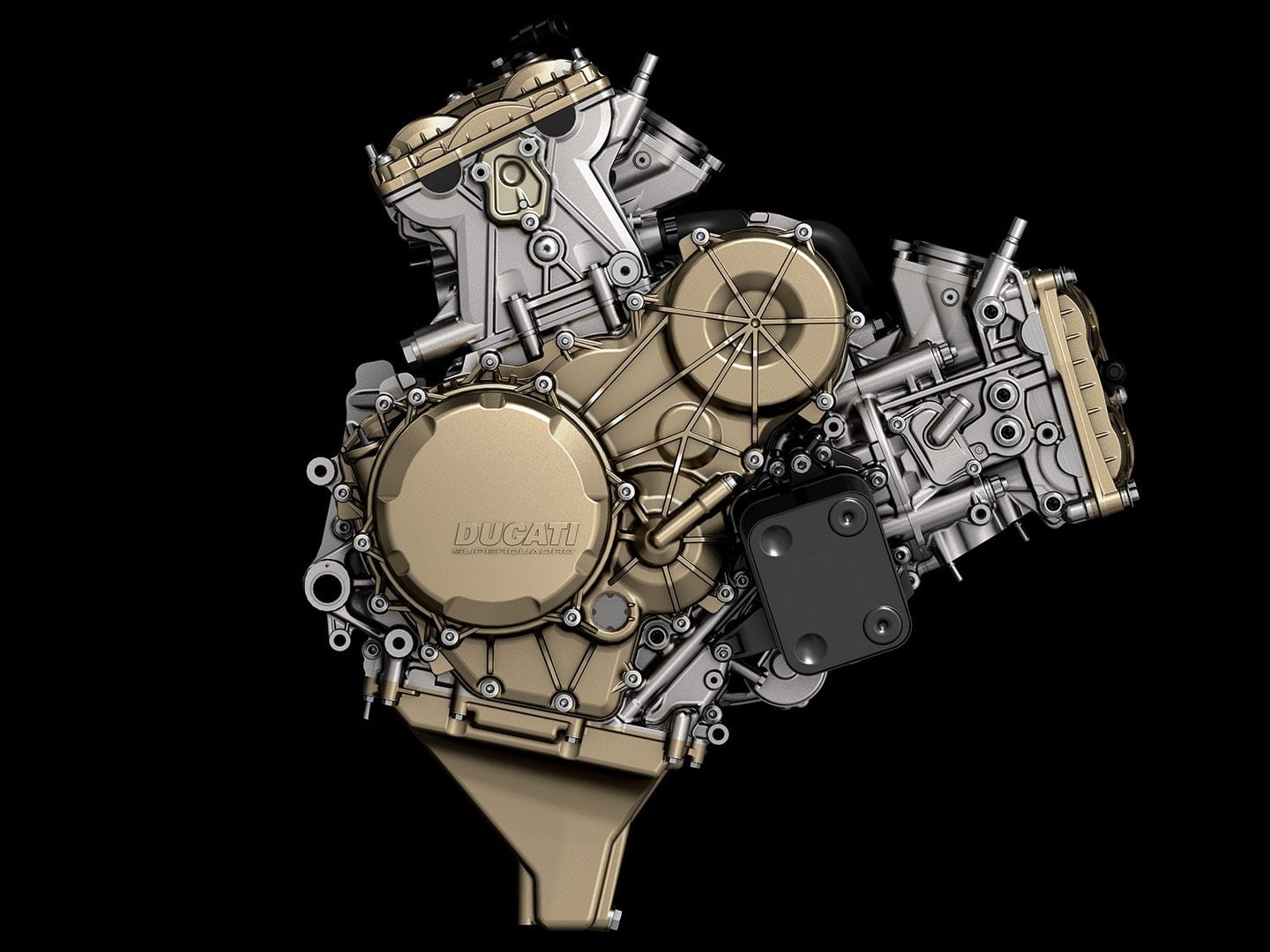
If we just cut this right about here… Ducati 1299 Panigale engine that served as the basis for the 659cc Superquadro Mono. It is not uncommon for motorcycle companies to start with a combustion chamber as the basis for a new engine. With the Superquadro Mono, Ducati had much more than just a good combustion chamber shape to work with. (Ducati/)Just as Ducati needed to maintain engine balance with the Supermono and introduced the clever connecting-rod method, so did this very large bore engine need balance. In addition to the primary balancing effect, the second piston in the 1299 exchanges energy with the other during rotation.
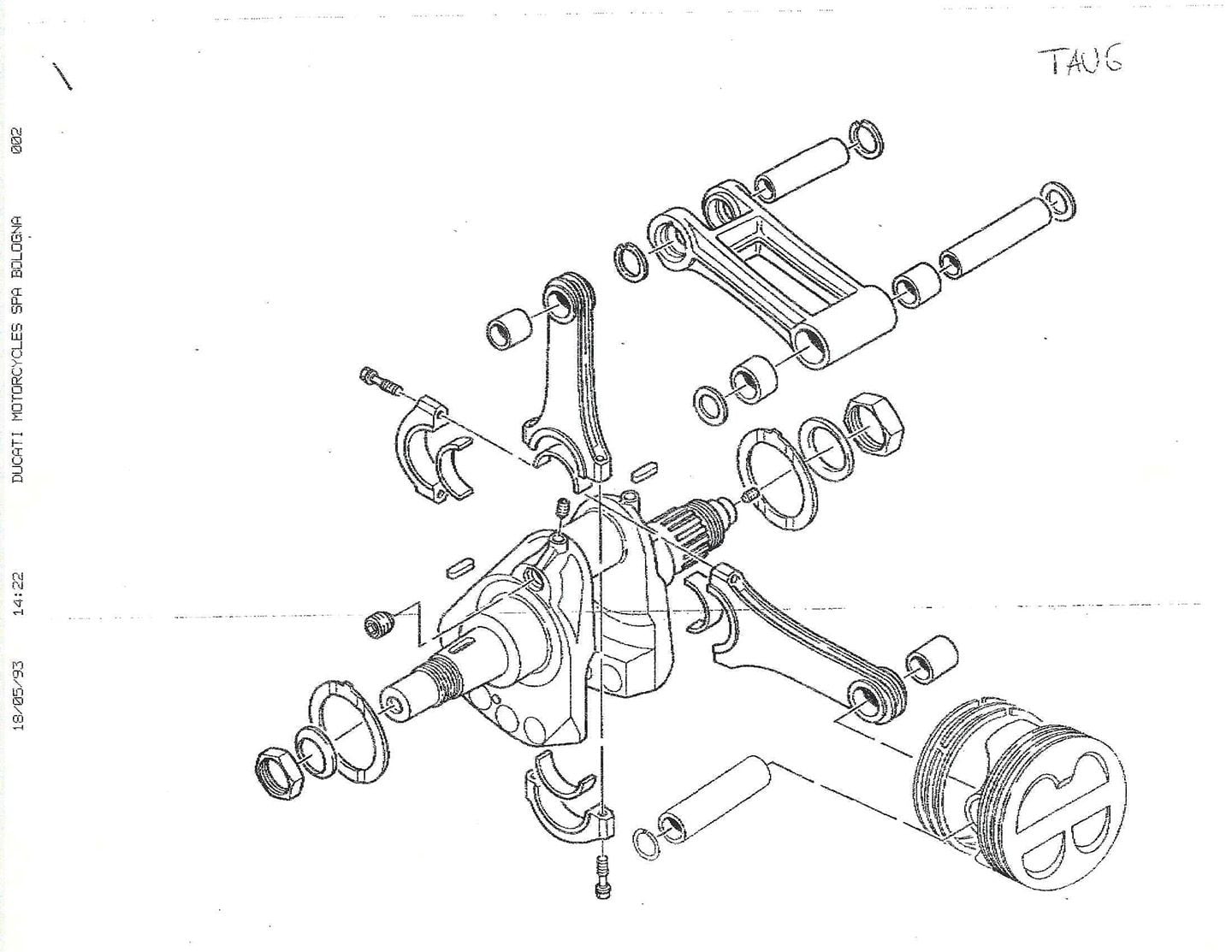
Another angle and different look at the 1993 Ducati Supermono engine internals. Two connecting rods, only one piston. Small print on the left edge of the image is the fax information: “Ducati Motorcycles SPA Bologna” from when it was sent to the Cycle World fax machine in May 1993. (Cycle World Archive/)When one piston hardly moving near TDC or BDC, the other is near its maximum speed. But in a single with this same large (116mm) piston, it exchanges energy instead with the crankshaft. This causes crank speed to vary quite a bit during each engine revolution. Did that variation in crank speed create a problem on the Superquadro Mono?
“We were a little bit scared of this oscillation [cyclic variation of crank speed] but honestly speaking we do not have much issue about that,” Fantoni says.
Fantoni also made it clear that dyno running answered many questions. Will X be a problem? They run a test and find it’s not so bad. As much as can be done with CFD and stress models, motorcycle development remains a physical process aimed at problem solving.
“We had some issues however with the starting system,” he says. “We gave the driveline of the starting system a little torque-limiting clutch that has the opportunity to slip if this big piston kicks back during cranking. This preserves the mechanical safety of the starter driveline.”
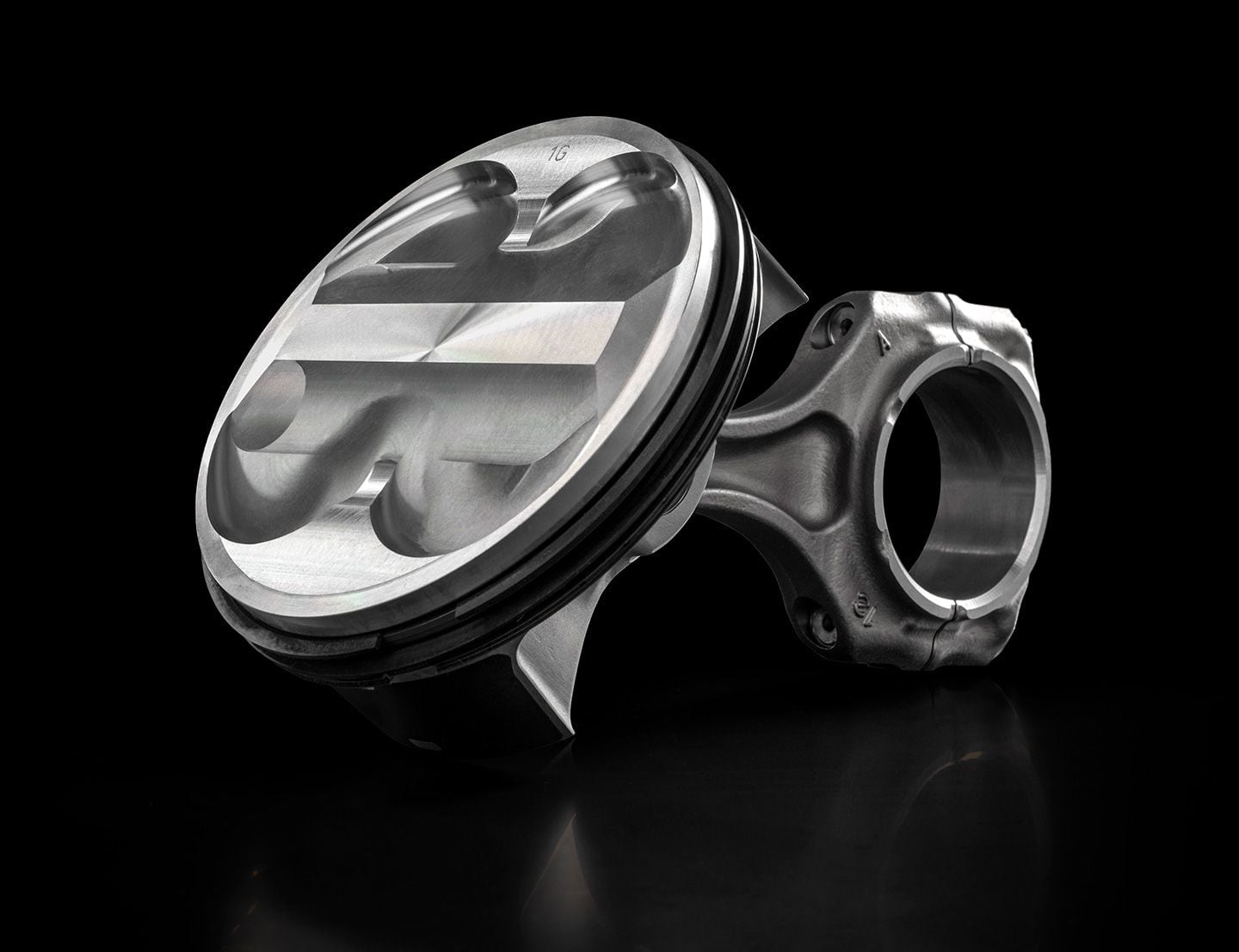
The 116mm piston atop its fracture-split connecting rod. The rod is slightly shorter than that used in the 1299 Panigale, despite the Superquadro Mono’s slightly longer stroke—62.4mm versus 60.8mm. The hidden bottom of the piston is “box-in-box” reinforced—think of a multiroom apartment below the piston crown whose walls give great strength and pick up the short wrist pin. An oil jet is aimed at piston bottom for cooling. (Ducati/)Photos of the short, stout connecting rod attached to the very large piston raised the question of rod length.
“Connecting rod length is 109.3mm, a little bit shorter than in 1299,” Fantoni says. “There is some cylinder offset to reduce piston side-thrust friction.”
Cylinder offset has been used on engines for more than 100 years but it’s come into more frequent use again recently. The “offset” is moving the cylinder centerline from directly above the crankshaft main bearings so that on the power stroke the rod has less angle and therefore piston thrusts against the bore wall with less force.
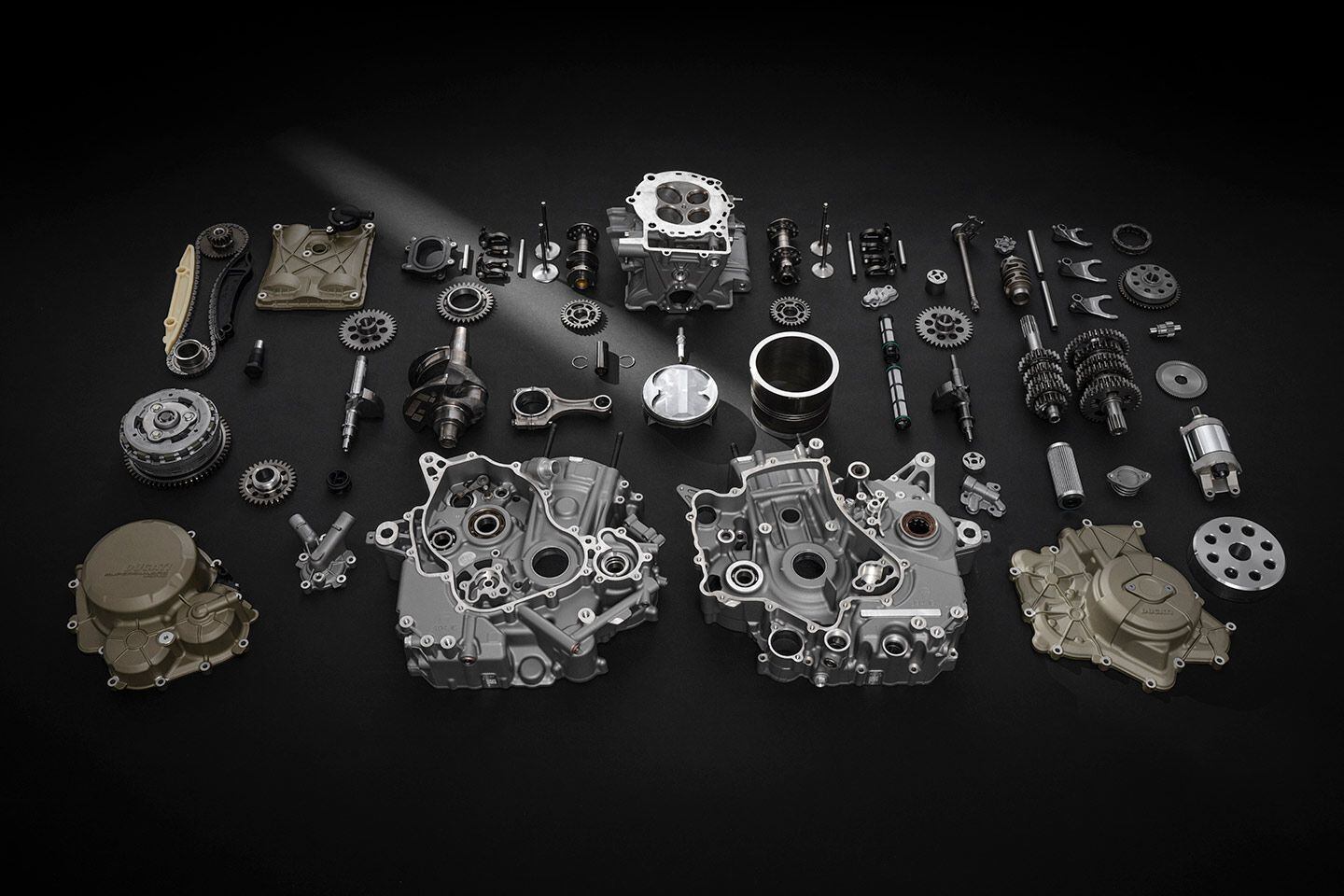
So many beautiful parts. The Superquadro Mono’s desmodromic valve gear is laid out next to the cylinder head, featured top dead center (see what we did there?). Deep ribs in the castings give strength; magnesium covers reduce weight. (Ducati/)A goal with internal combustion engines is reducing what engineers often refer to as “cycle to cycle variation.” This means they work very hard to have every combustion event from idle to redline to be perfectly repeatable. This is particularly difficult in big-bore singles, especially at idle. Cameron offers that the problem can be dilution by exhaust product remaining in the cylinder: if the spark occurs as a whiff of exhaust gas swirls past the plug, there will be a misfire.
“During the design what we did to improve idle stability, compared to the 1299 Panigale engine, was to reduce valve overlap,” Fantoni says.
Related: 2022 GasGas SM 700 and ES 700 First Ride
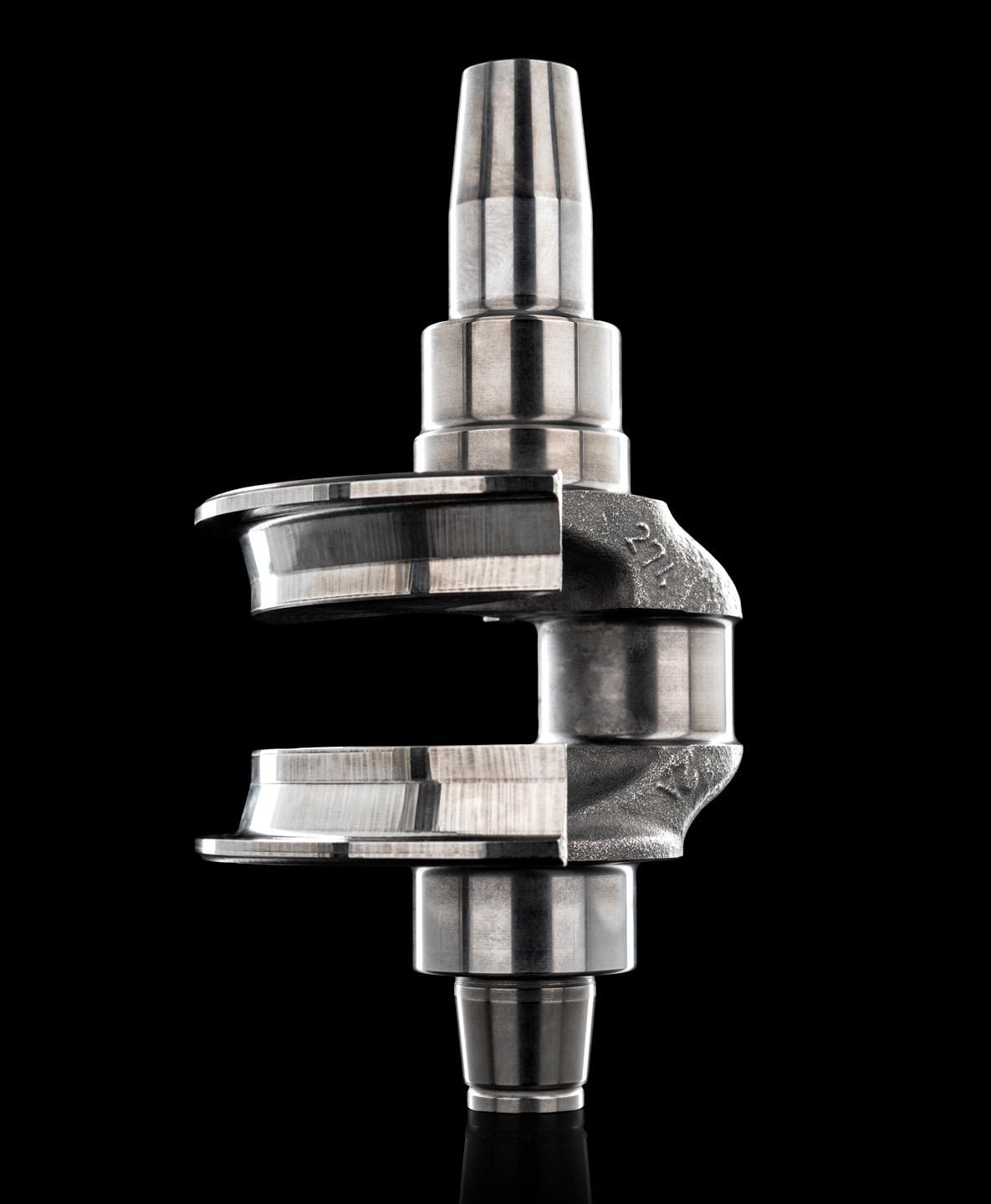
The Superquadro Mono crankshaft uses plain main bearings, not rollers as Ducati did for so long. Fun fact: The 1993 Ducati Supermono single also used plain crank bearings, a feature engineering Massimo Bordi intended to introduce on the twins much sooner than actually happened. (Ducati/)“Valve overlap is the period centered on TDC at the end of the exhaust stroke, when the exhaust valves have not completely closed, yet the intakes have begun to open,” Cameron explains. “If you imagine the engine idling, but with some wave action still taking place in the exhaust pipe, you can see that the longer this overlap is made, the greater the chance that the exhaust fraction in the gas above the piston may be high enough to cause some misfiring.”
“Alpha [valve overlap in degrees] of 1299 Panigale was 45 degrees, but in this, only 20 degrees,” Fantoni adds. “Duration and lift are also reduced. These changes have two main advantages: We get a smoother torque curve in wide-open-throttle condition and also improve combustion stability at low rpm close to idle.”
Throttle-body dimension is also reduced. “The round equivalent of the 1299′s oval throttle is 67.5mm. This one is only very huge at 62mm,” Fantoni adds with a smile.
This is a 15 percent reduction in intake area.
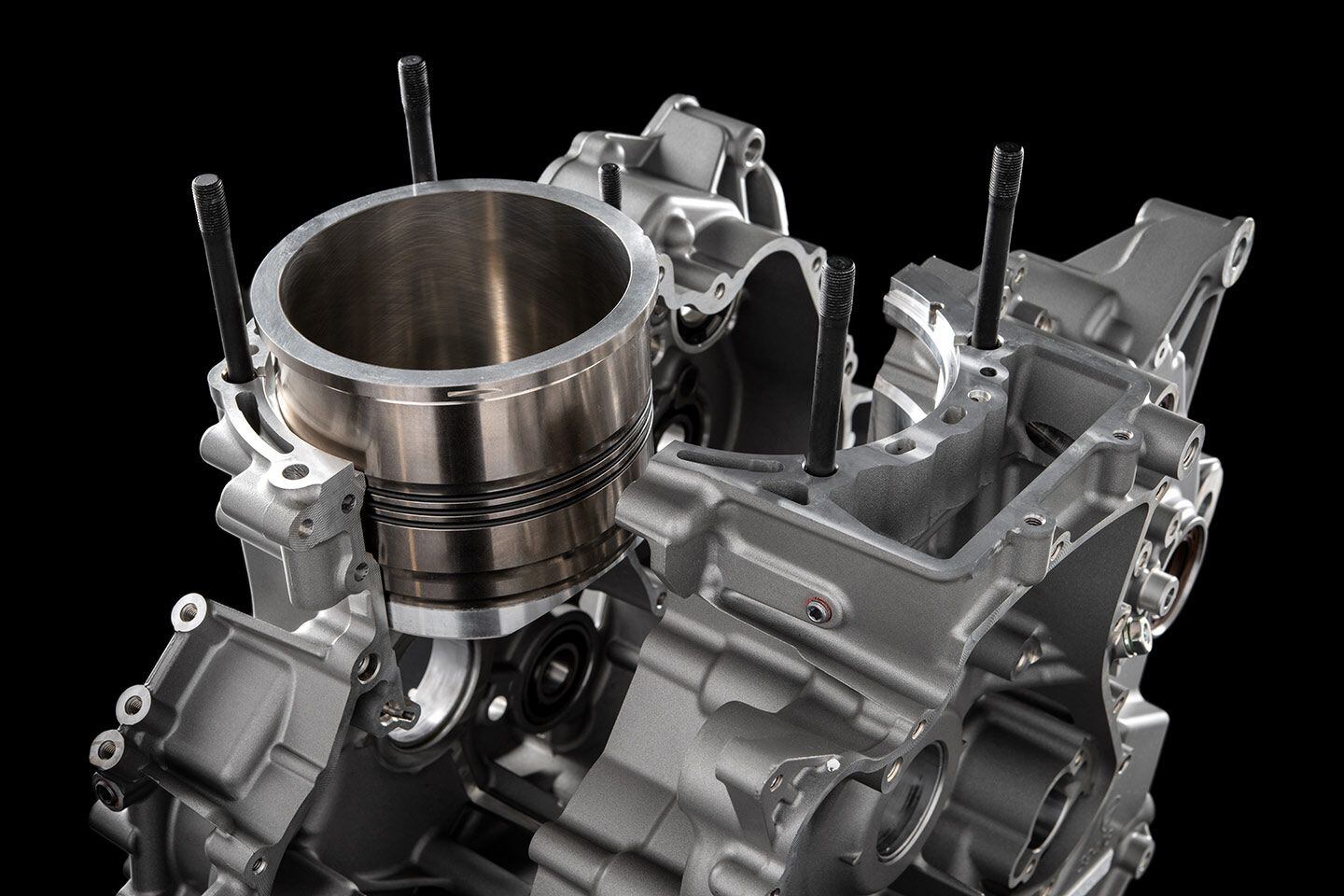
Cylinder liner is like that used in the 1299 Superleggera. Why? Weight! The standard 1299 Panigale liner was steel. The Superleggera and now Superquadro Mono is aluminum. (Ducati/)In a further aid to stability, idle speed is raised to 1,700 rpm, a few hundred rpm higher than that of the 1299.
“The kinetic energy of a very light crankshaft is small at rpm close to idle—too close to the energy required to push the piston through compression,” Cameron says. “If the piston bounces back against compression, the engine stalls. Because kinetic energy rises as the square of speed, a modest increase in idle speed can help a lot. Fantoni noted that in this engine, the mass rotating at crank speed consists of the crank itself, a large-diameter alternator, and the two balance shafts.”
Cameron had speculated that some reduction of compression ratio might have been needed to stabilize idle, but not so. Compression is actually increased in proportion to the increase in stroke from the 1299 (from 1299′s 60.8mm stroke to 62.4mm in the SQ Mono), so it is 13.1:1.
“If high compression could be an issue, we immediately began to assess if it would work,” Fantoni says. “The knock tendency of this engine is not very high so changes to the intake and exhaust system and cam profile were able to provide combustion fast enough to prevent knocking events. We also added a knock sensor and ECU control to reduce spark advance in case of knock events—a safety device to protect the engine from strange atmospheric conditions or lower-octane fuel. There is one central spark plug, with two electrodes, as is typical for racing applications.”
He noted that the “intake duct is quite different from other manufacturers.”
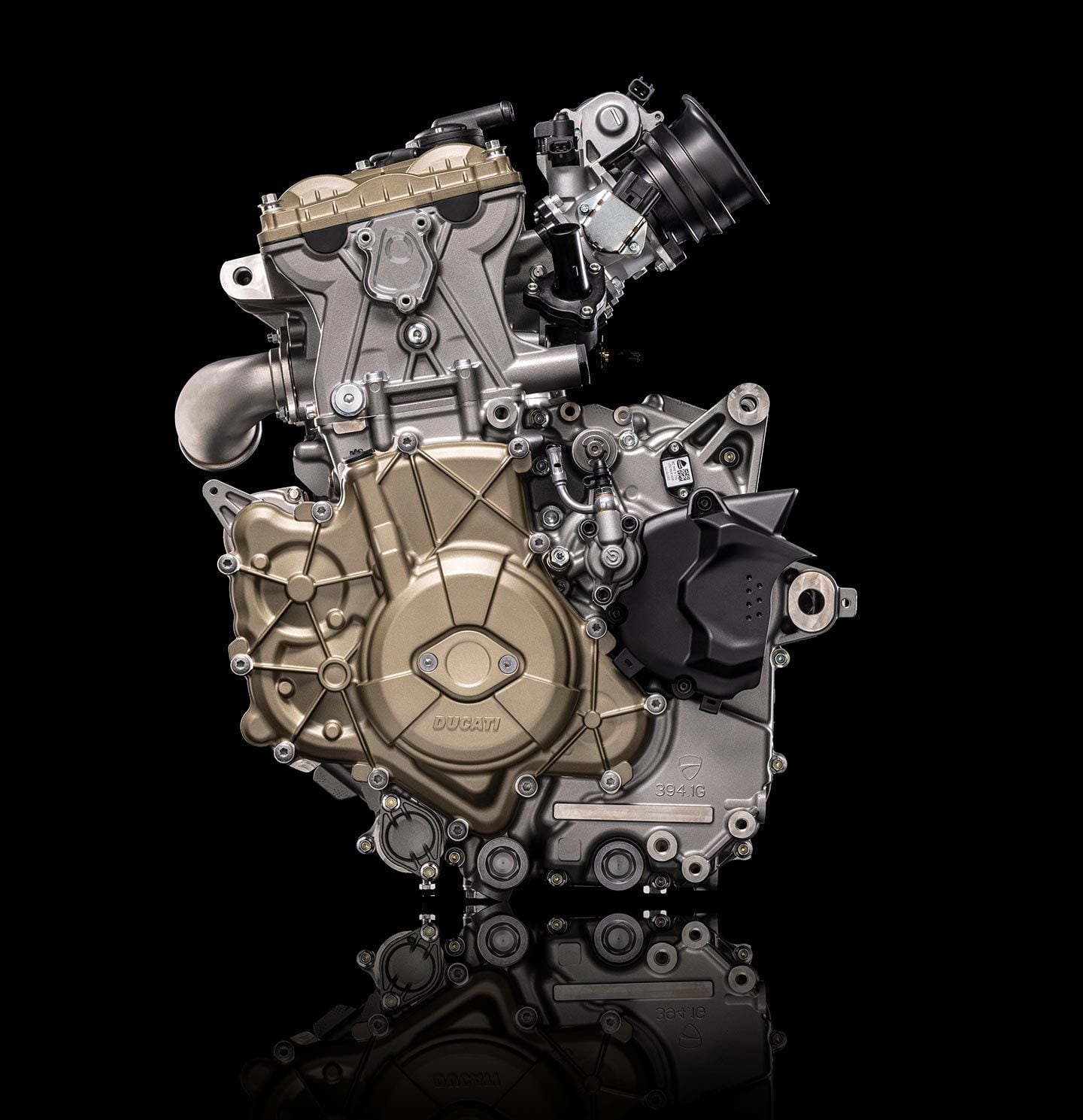
We think it’s likely that Ducati has some form of “Combustion Department” that has made extensive work of all the technical influences on the combustion process, including intake angle as it relates to the cylinder centerline. It takes work to make a 116mm cylinder bore fire cleanly with a single spark plug. (Ducati/)I asked Cameron about this. “Engines of many other makers have quite steep intake downdraft angles, close to 45 degrees,” he says. “Ducati engineers understand that intake angle and runner diameter influence the level of turbulence during combustion. The function of charge turbulence is to make combustion fast enough that chemical changes necessary for detonation have too little time to occur; it is as though detonation has ‘a fuse.’ This may be why the Superquadro 659cc engine has less intake downdraft—near 25 degrees, directing more energy into the in-cylinder ‘tumble’ motion that compression can turn into turbulence near TDC.”
Fantoni shared his screen to show us the engine’s torque curve, which though it has a shape similar to that of the 1299 Panigale, midrange has been fattened and the steepness of the rise to peak torque is reduced.
“We decided to reduce overlap and total duration, also to reduce a little bit the intake duct diameter,” Fantoni offers “We look for torque good for twisty roads and streets, not only at the track. You have to find the balance.”
A small reduction in intake runner diameter has long been used as a means of boosting midrange torque. This works in two ways: First, the resulting higher intake velocity can continue flowing into the cylinder past BDC (bottom center) longer, even against the rising piston, and second, higher intake velocity also boosts turbulence to achieve quicker combustion.
Intake valve lift, he said, is 14.4mm, which is 31 percent of valve head diameter and a 1.0mm reduction from 1299, or about 7 percent.
We asked about piston oil-cooling jets.
“We have only one piston oil-cooling jet, same diameter as the two in 1299,” Fantoni replies. “We were able to put it on the exhaust side.” The exhaust side of the piston is hotter, and shooting cooling oil there increases heat transfer.
He explained that to simplify plumbing, in 1299 the jets were in the Vee, hitting the intake sides of the pistons first. There are windows in the struts that stiffen the piston crown, allowing the oil jet to flow in contact with the hot aluminum clear across the underside of the piston to the intake side, where it is deflected down into the crankcase by the intake skirt.
A scavenge oil pump pulls a partial crankcase vacuum: “That is 40 millibars with respect to ambient,” Fantoni says. “There are a lot of rotating parts—crank, two balance shafts, and also the gears that drive them. If you have oil that interacts with these rotating parts, you lose performance, you increase friction. This dry sump system collects from the clutch and alternator area, not only from the crankcase, so the scavenge pump has to collect oil and gas, and transfer oil to the pan.”
Cameron asked the final question: “What aspects of this new engine especially please you?”
“It was a long design, begun four years ago,” Fantoni says. “At the end we are proud that this engine is compact and light: It is a real Ducati engine. When you hear it on the test bench you recognize it is very sporty and can run at very high engine speed. It is more similar to a V-twin engine than to a single. It’s a very sporty bike, very close to our DNA.”
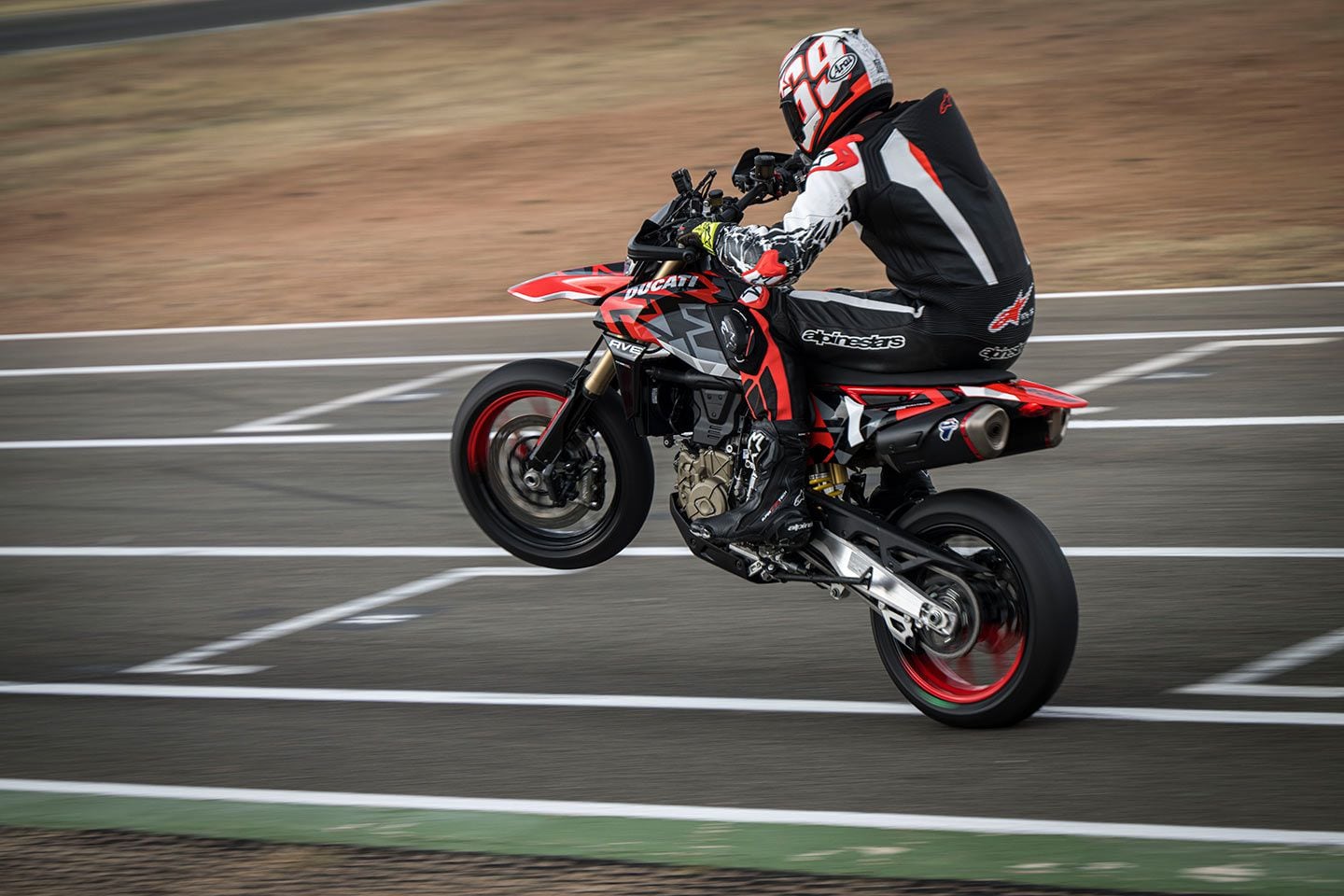
How does a claimed 77.5 hp and 333 pounds wet, no fuel look on a track? Like this—a lot! <i>CW</i> staffer Bradley Adams tests the production Hypermotard 698 Mono RVE at a kart track in Spain. Read his <a href="https://www.cycleworld.com/motorcycle-reviews/ducati-hypermotard-698-mono-first-ride-review/" target="_blank">full review here</a>. (Ducati/)Licciardello adds, “The present is a very positive time for Ducati. We are increasing our market, winning in competition and we are designing new products. The whole industry now is under attack from good Chinese products that are becoming competitive in price-to-performance ratio. The Japanese have capacity to produce many not-so-sophisticated models for Southeast Asian markets.”
This leaves to the European producers the up-market segment for sophisticated motorcycles of highest quality and performance—the market that Ducati serves so well.
-
 1
1
-
 1
1
-
-
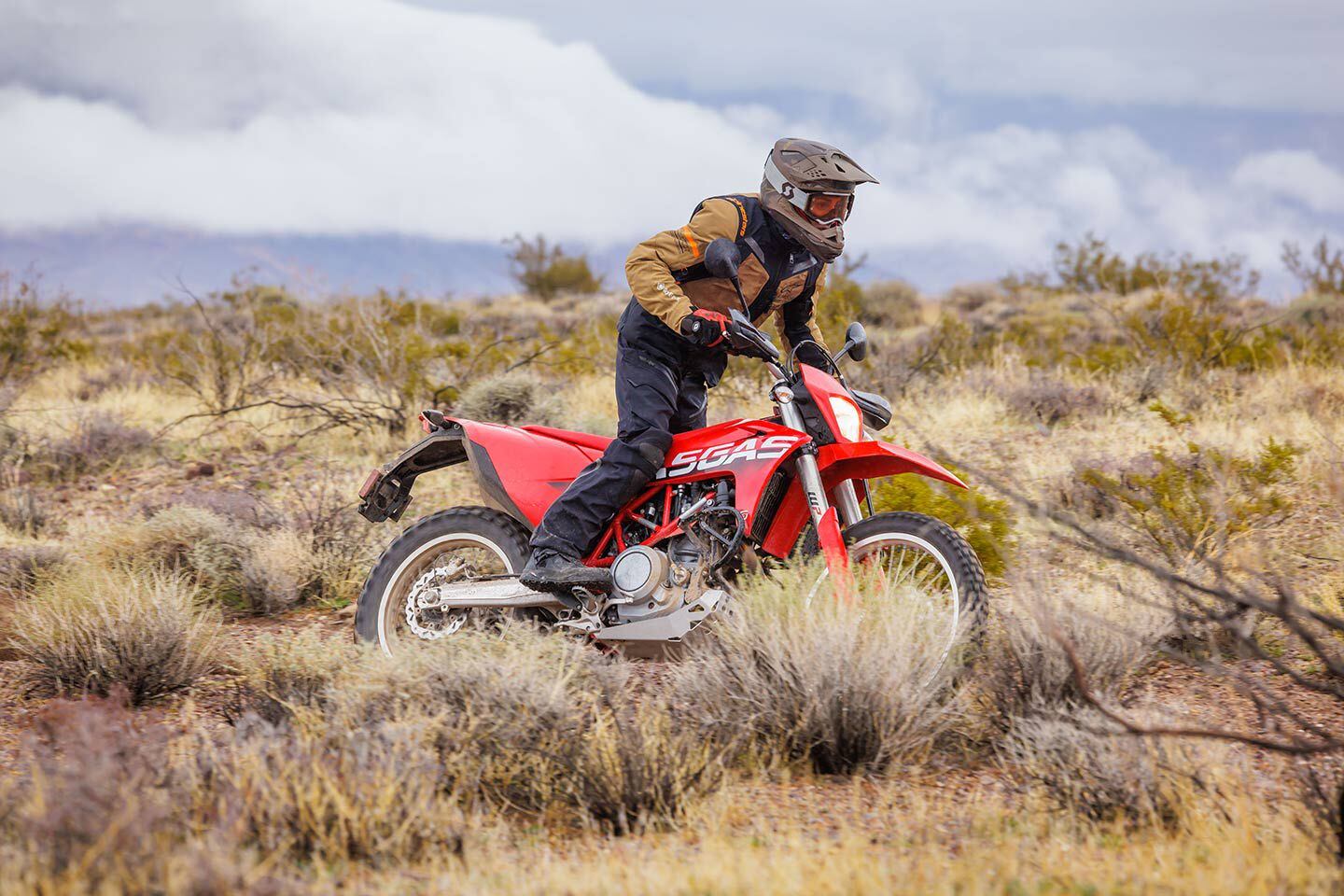
Alpinestars’ Tech-Air Off-Road is not intrusive when riding and visually unnoticeable in the front. (Alpinestars/)Alpinestars has been protecting riders with airbag systems for more than 14 years. The Italian company began logging crash data in 2003. In 2009 the Tech-Air Race was used in MotoGP. By 2011 the Tech-Air Race became available to the public. Since then, Alpinestars has developed a range of airbags including the Tech-Air 10, Tech-Air 5, Tech-Air 3, and recently announced Tech-Air 7x. All these systems are designed to protect roadracers and street riders, but what about the off-road folk? Now, with the launch of the Alpinestars Tech-Air Off-Road, dirt bike and adventure riders can benefit from the same impact protection as the Tech-Air Race, Street, 10, 7x, 5, and 3.
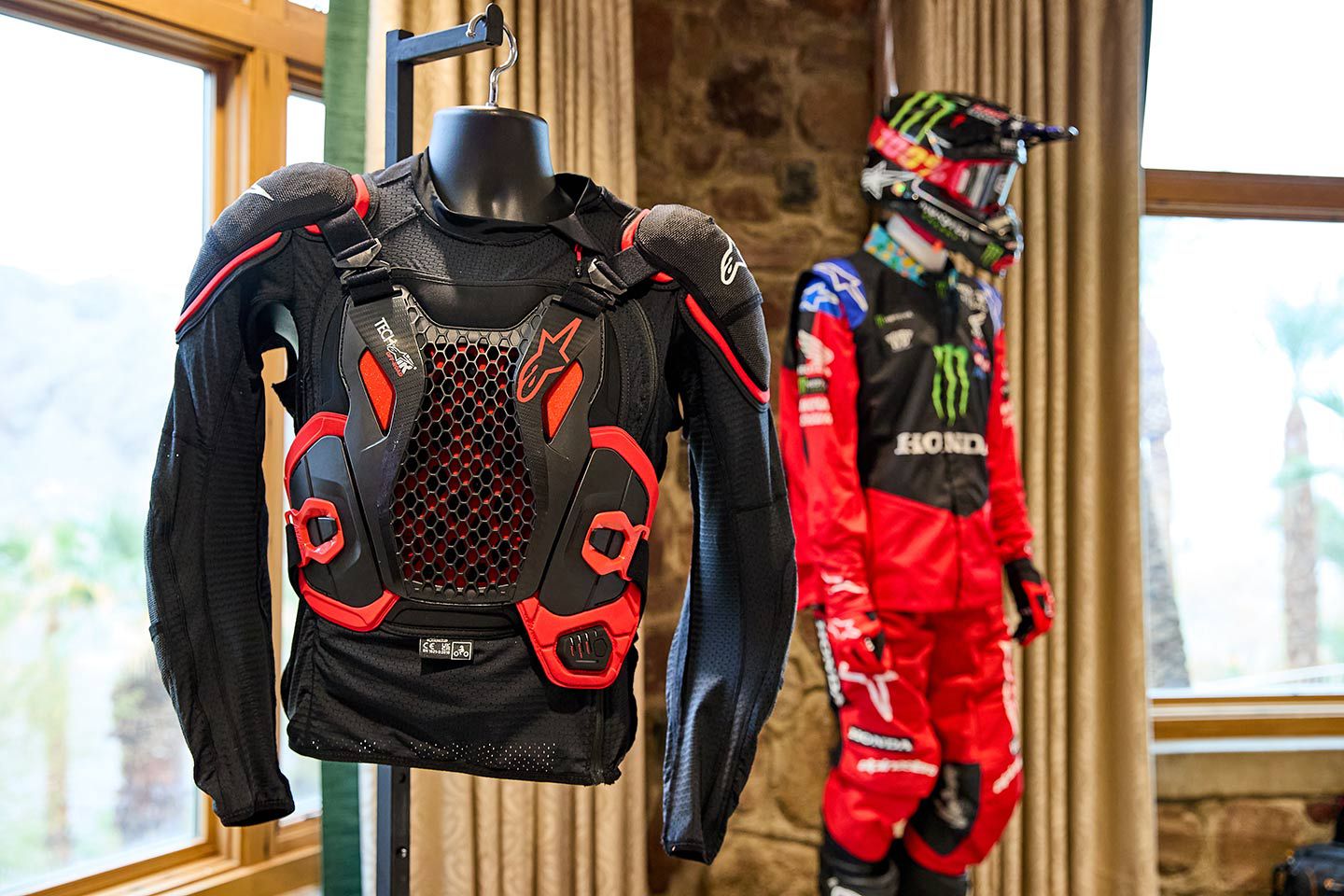
Alpinestars Tech-Air Off-Road ($999.95). (Alpinestars/)Alpinestars began designing the Tech-Air Off-Road in 2017. A year later, the system was being used in competition by professional rally racers. By 2023, 83 Dakar competitors were wearing the system. And now, the Tech-Air Off-Road (two argon canisters included) will be available to the public for $999.95.
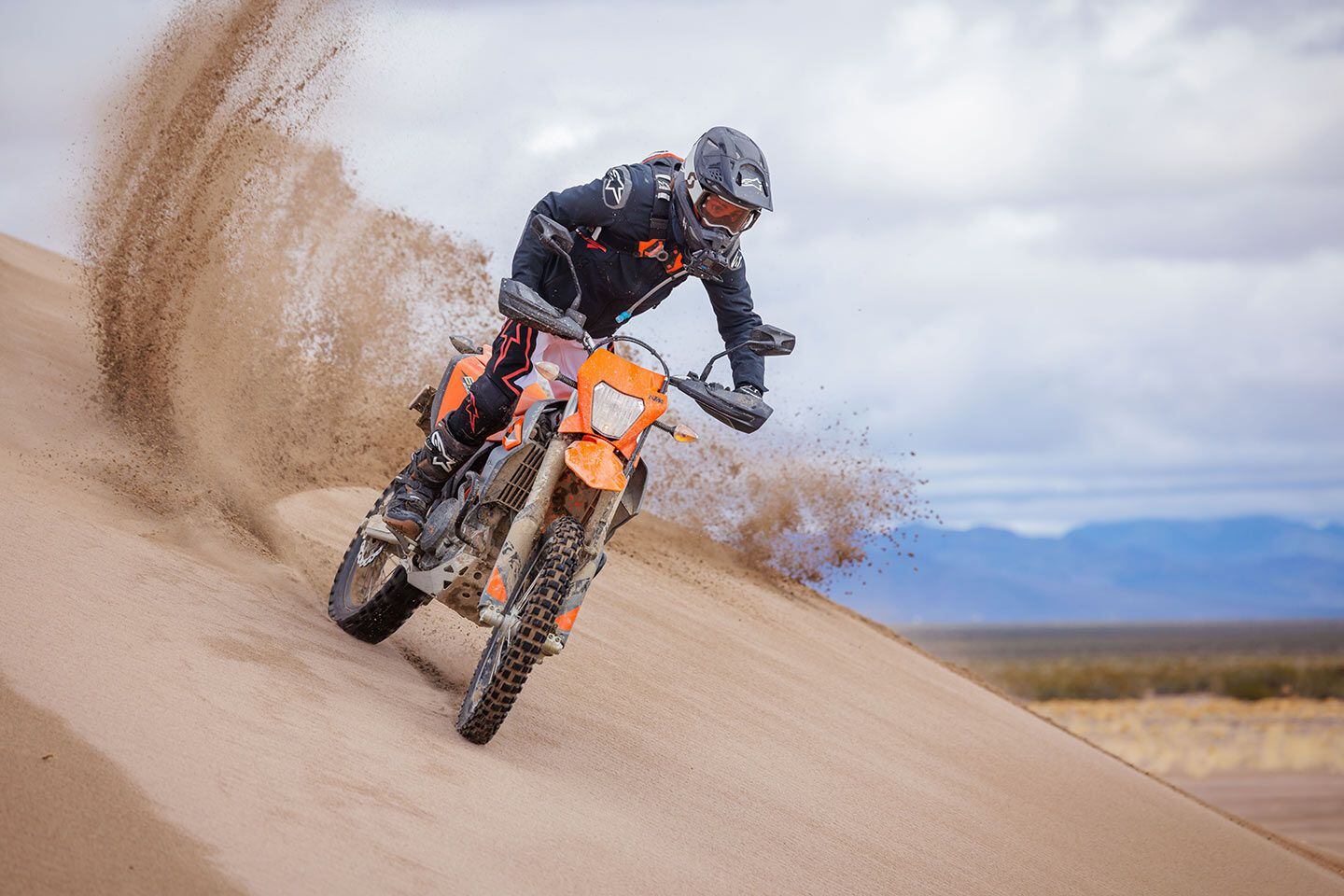
In the 2024 Dakar, the Alpinestars Tech-Air Off-Road had 323 individual deployments and zero false positives. (Alpinestars/)Tech-Air Off-Road Details
The system is typically worn as an undergarment or under jacket, but can fit over base layers and jerseys. Alpinestars Tech-Air Off-Road offers passive protection (CE Level 1: shoulder, elbow, and back; CE Level 2: chest) as well as active protection (airbag). The electronic control unit, located in the back protector, utilizes six triaxial sensors (three gyroscopes, three accelerometers) reading every one millisecond. In the event of a crash, one of two canisters deploys the system before impact. Located in the back protector, the “bag” will inflate, covering the chest, back, neck, and shoulders within 40 to 60 milliseconds, depending on the size of the garment. The Tech-Air Off-Road is available in five sizes ranging from S to 2XL. The ECU, airbag, and the passive protection can be removed from the under jacket for cleaning.
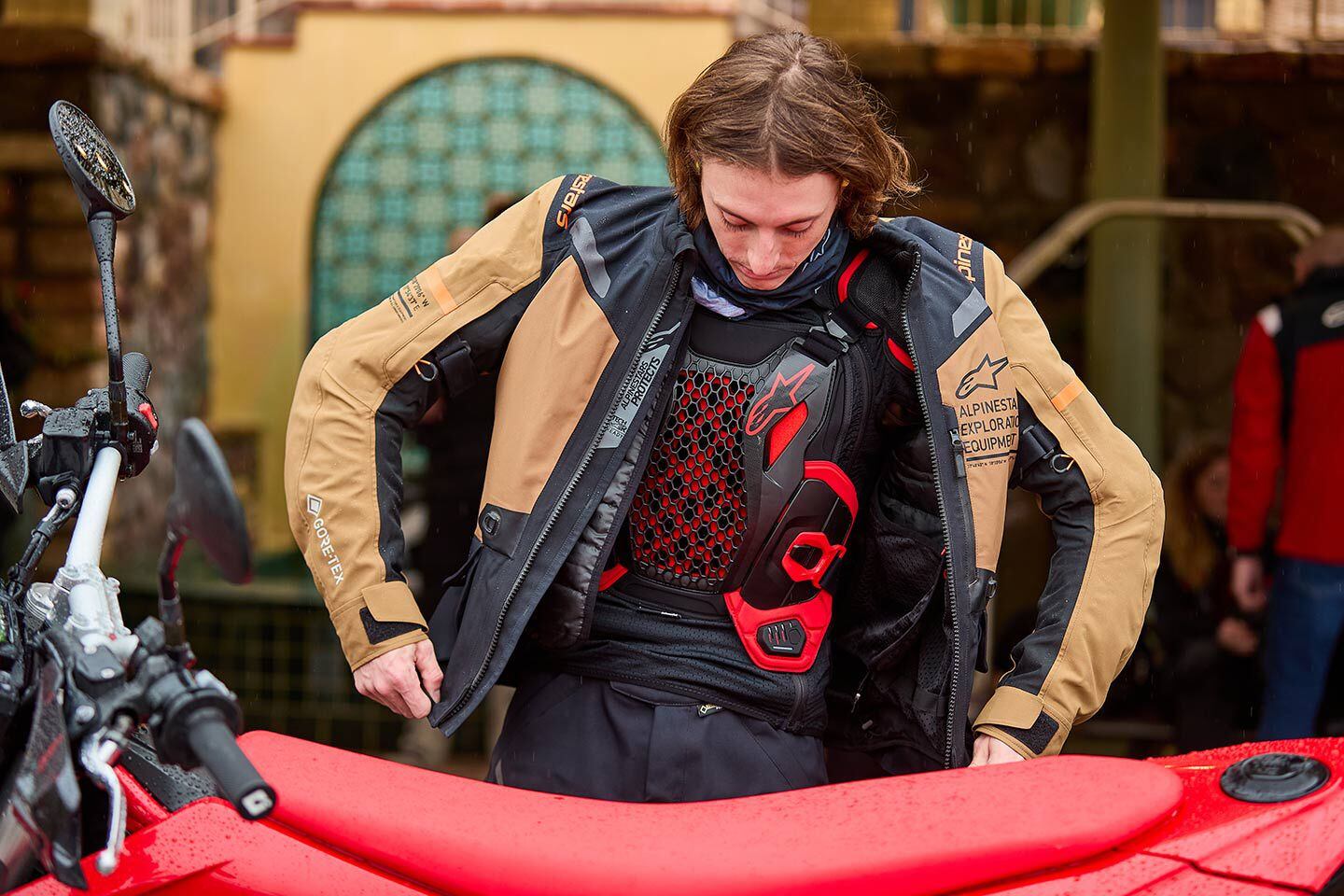
The Tech-Air Off-Road’s ergonomics allow for easy layering in cold conditions, but are highly vented and breathable for warmer temperatures. (Alpinestars/)The Tech-Air Off-Road has three different modes, Street, Rally, and Enduro, each with discipline-focused algorithms. Street mode is “optimized for tarmac roads and traffic conditions” and is the same algorithm used in every other Tech-Air system. Rally mode is “optimized for fast off-road action on any type of terrain.” Enduro mode is “optimized for low- and medium-speed trail off-road action on any type of terrain.” To activate the system, simply zip up the under jacket connecting an internal magnet, giving power to the system. A two-second vibrating haptic will alert the rider that the system is on.
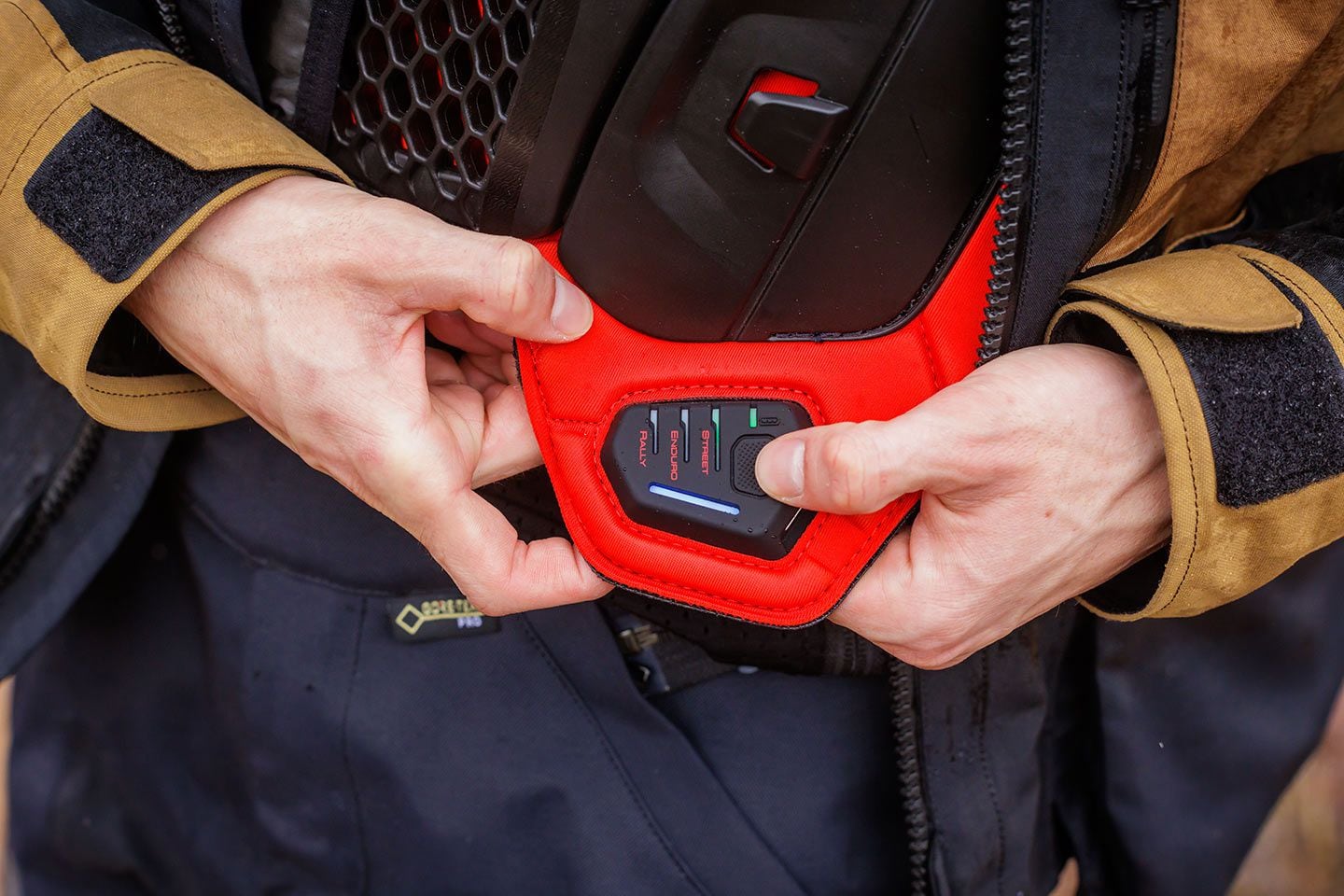
An LED Display shows battery level (Green: over eight hours; Yellow: four to eight hours; Red: one to four hours; Flashing Red: less than one hour), standby status (Blue: system active; Red: system fault) as well as the selected mode (Green). (Alpinestars/)Using Rally mode while traveling along fast fire roads and bumpy two-track, the system does not deploy on G-outs or jump landings. Enduro mode is exactly as it implies. Best for slow, technical riding. The system is in place to protect you from moderate to severe crashes but, in the event of a small tip-over, the system may not deploy in an effort to save the available canisters for something more serious. Alpinestars sells replacement canisters in a two-pack for $169.95. After four deployments, Alpinestars highly recommends sending the system in to have the airbag inspected and possibly replaced.
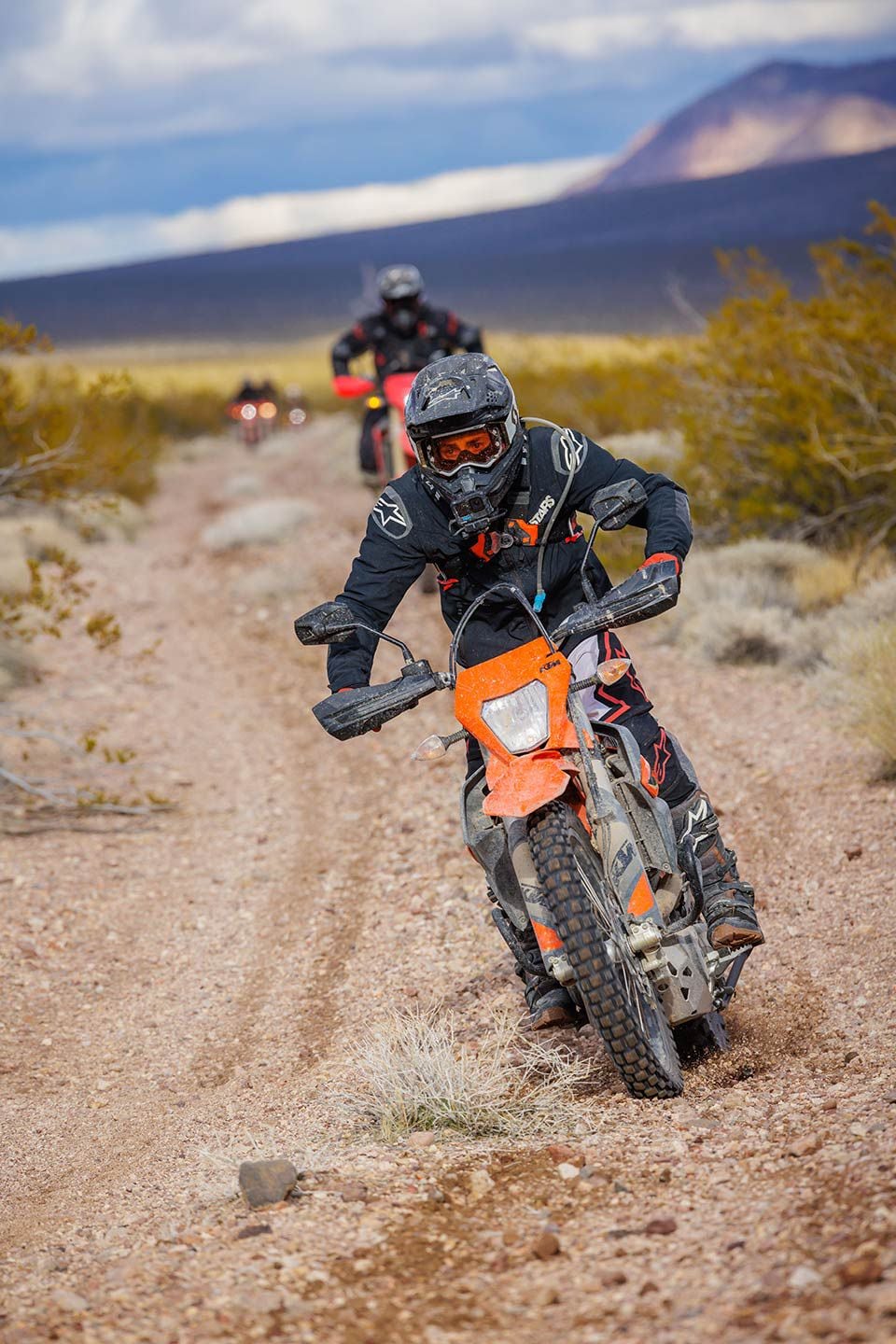
Off-road, the Tech-Air system can differentiate between a heavy load on the bike and an actual crash, determining if the airbag bladder needs to be inflated or not. (Alpinestars/)Riding Impression
The Tech-Air Off-Road is very comfortable and nearly undetectable. We experienced cold, rainy weather during our ride through Death Valley led by six-time AMA motocross/supercross champion Jeff Stanton and Honda HRC rally racers Skyler Howles and two-time Dakar winner Ricky Brabec. I was able to wear two base layers under the Tech-Air Off-Road (size small), and a mid-layer over it along with my Alpinestars ST-7 2L Gore-Tex adventure bike jacket. I wore the same layers on our second day of riding with the Alpinestars Session Race jacket as a shell. The system was equally comfortable in both getups. The only time I noticed the Tech-Air Off-Road on my body was when tucking in behind the bars as the chest and back protectors don’t arch with the curvature of the body in a scrunched position.
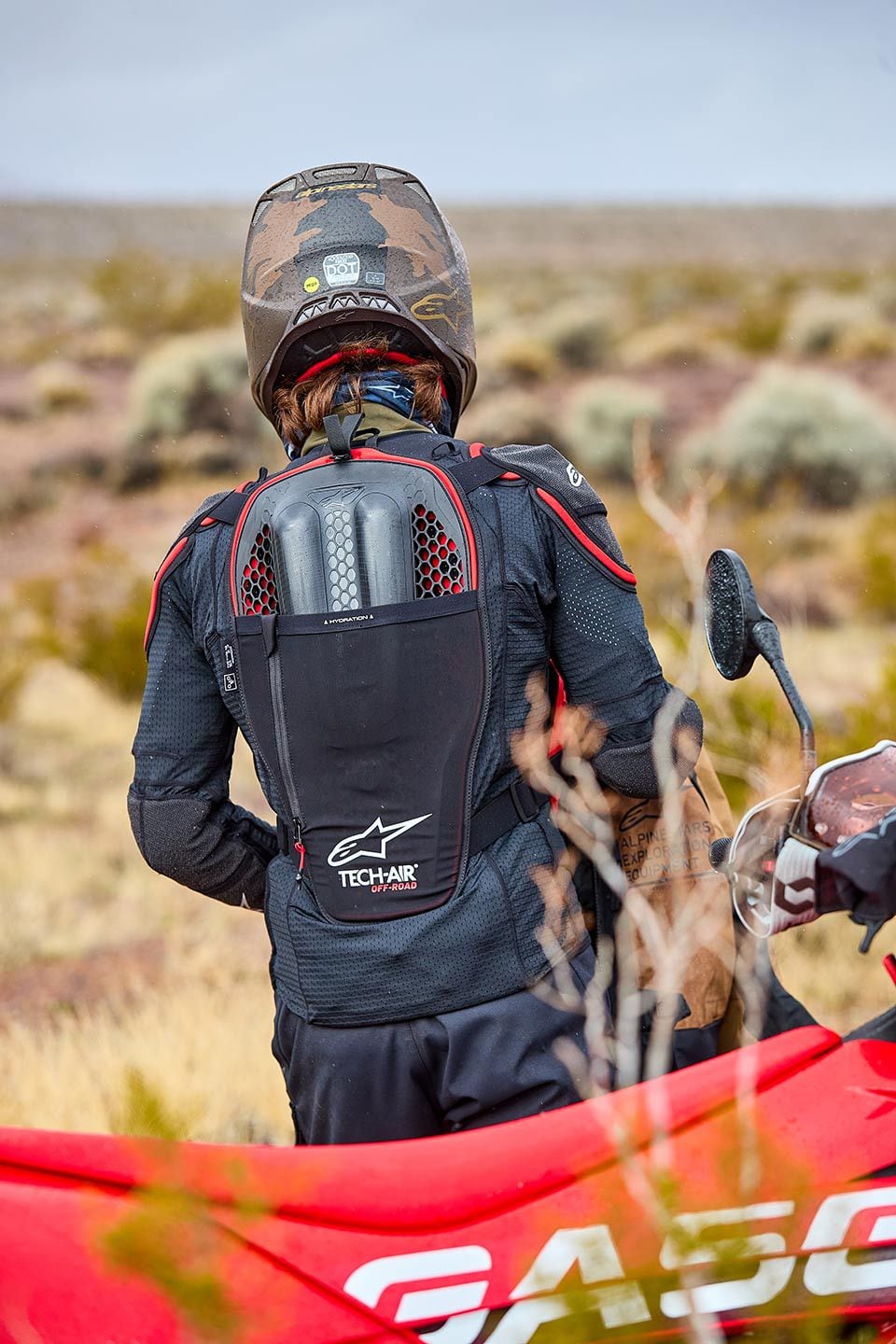
In the back protector is where the two gas canisters and six triaxial sensors can be found. A red light next to each canister indicates if the charge has been deployed or not. The storage pocket on the back of the system can hold a hydration bladder of up to 3 liters. (Alpinestars/)Usability is easy and straightforward. Simply turn the system on by zipping up the garment and select your desired mode via the LED display. If the Tech-Air detects no movement for more than five minutes the system goes to sleep. So make sure you check the system’s status after each coffee break. Battery life offers 30 hours of ride time and the system takes roughly four hours to charge through the USB-C port on the LED display located on the bottom left of the chest protector. The system button located on the LED display allows the rider to shuffle through modes (short press: change riding mode; long press: manual switch off).
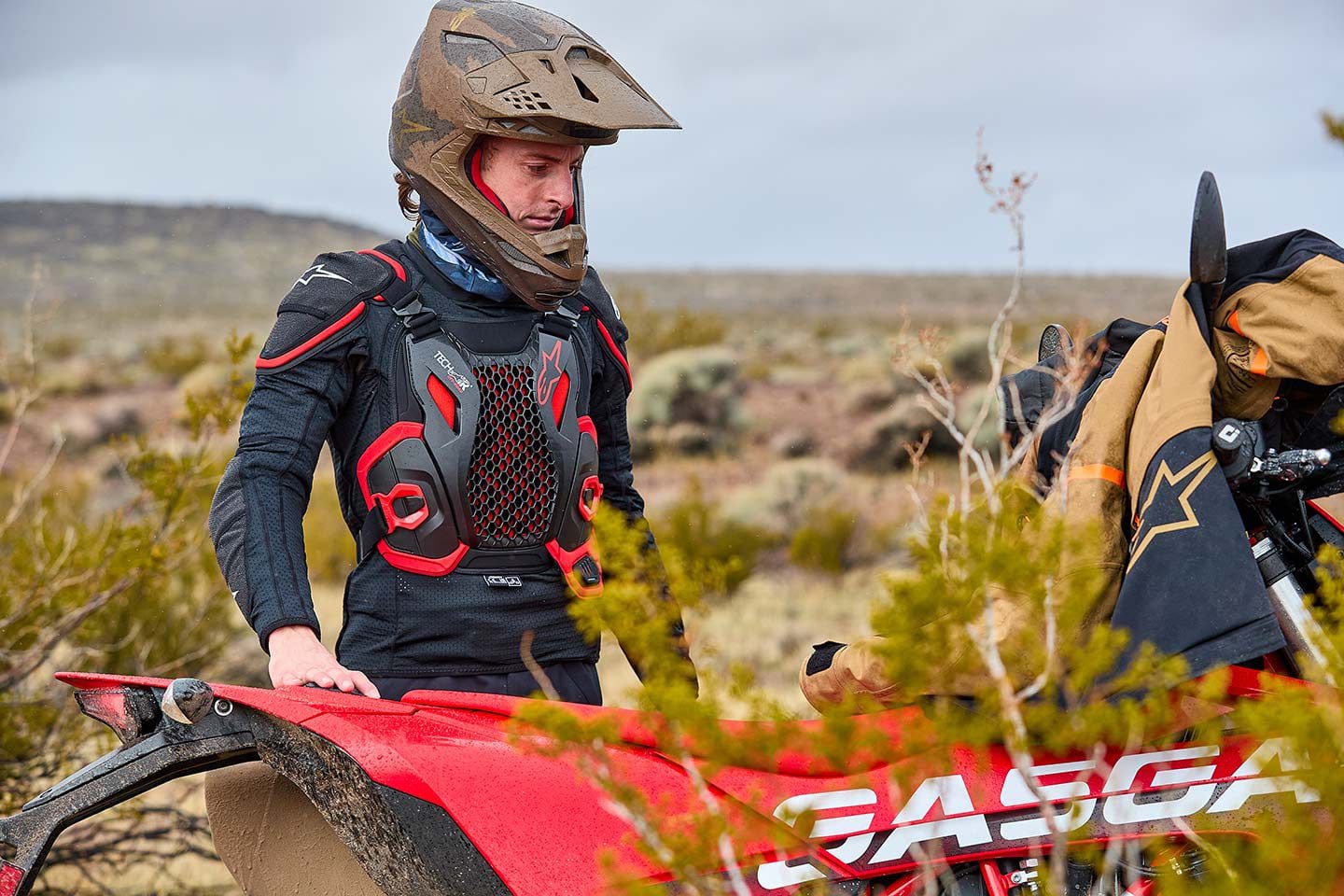
Alpinestars’ Tech-Air Off-Road connects to the Tech-Air app via Bluetooth for system updates, status checks, and records rides through an enhanced Google map. (Alpinestars/)Alpinestars claims the Tech-Air can reduce impact forces up to 95 percent. That’s pretty significant. Whether you’re an avid adventure bike rider, dual sporter, or trail rider, the Alpinestars Tech-Air Off-Road is designed to provide additional protection in the event of a crash. Most motorcyclists wouldn’t ride without proper protection. And for some, the Tech-Air Off-Road may be just as important as a helmet and a pair of boots.
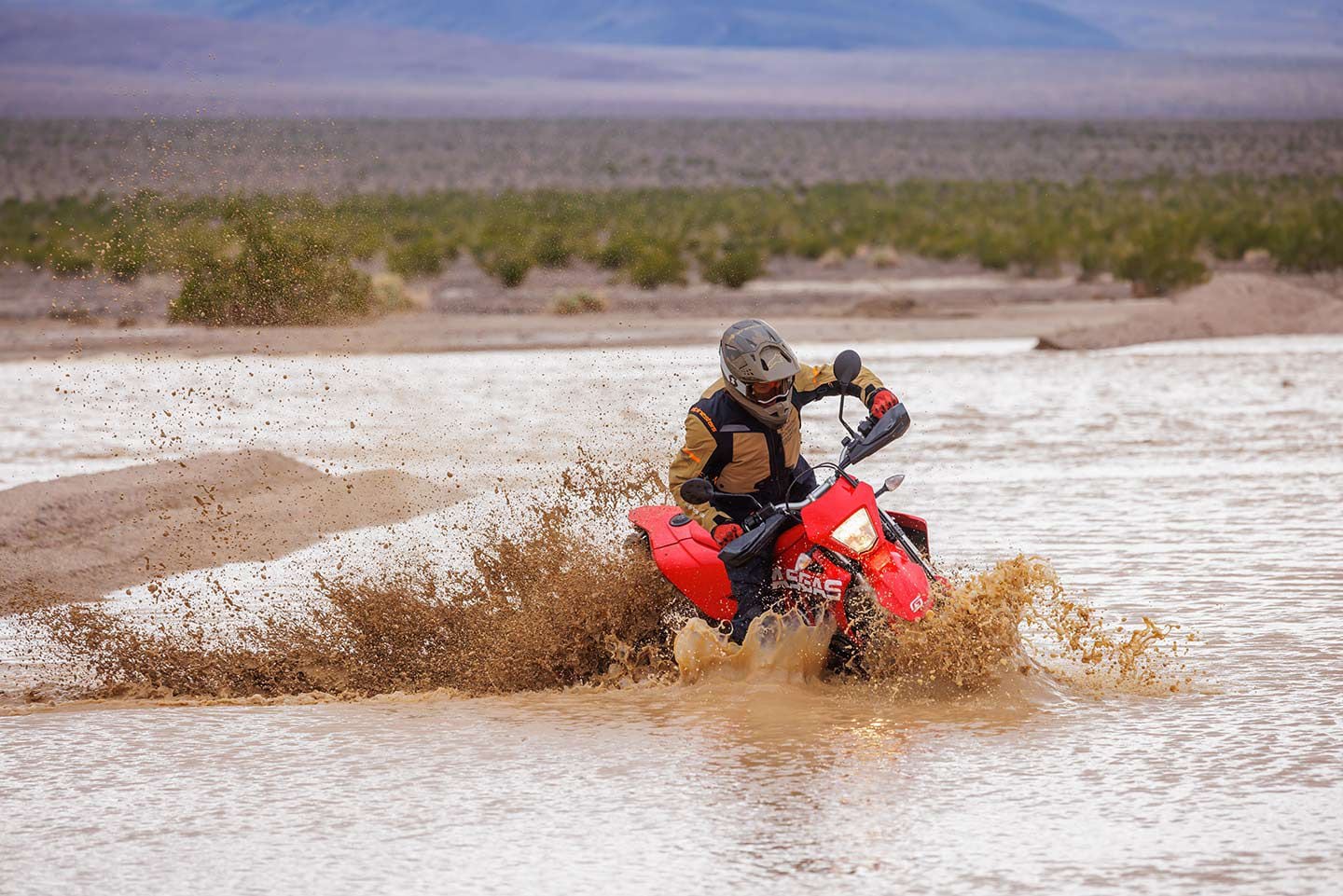
Alpinestars’ Tech-Air Off-Road LED display is waterproof. The electronics located in the back protector are water resistant. (Alpinestars/)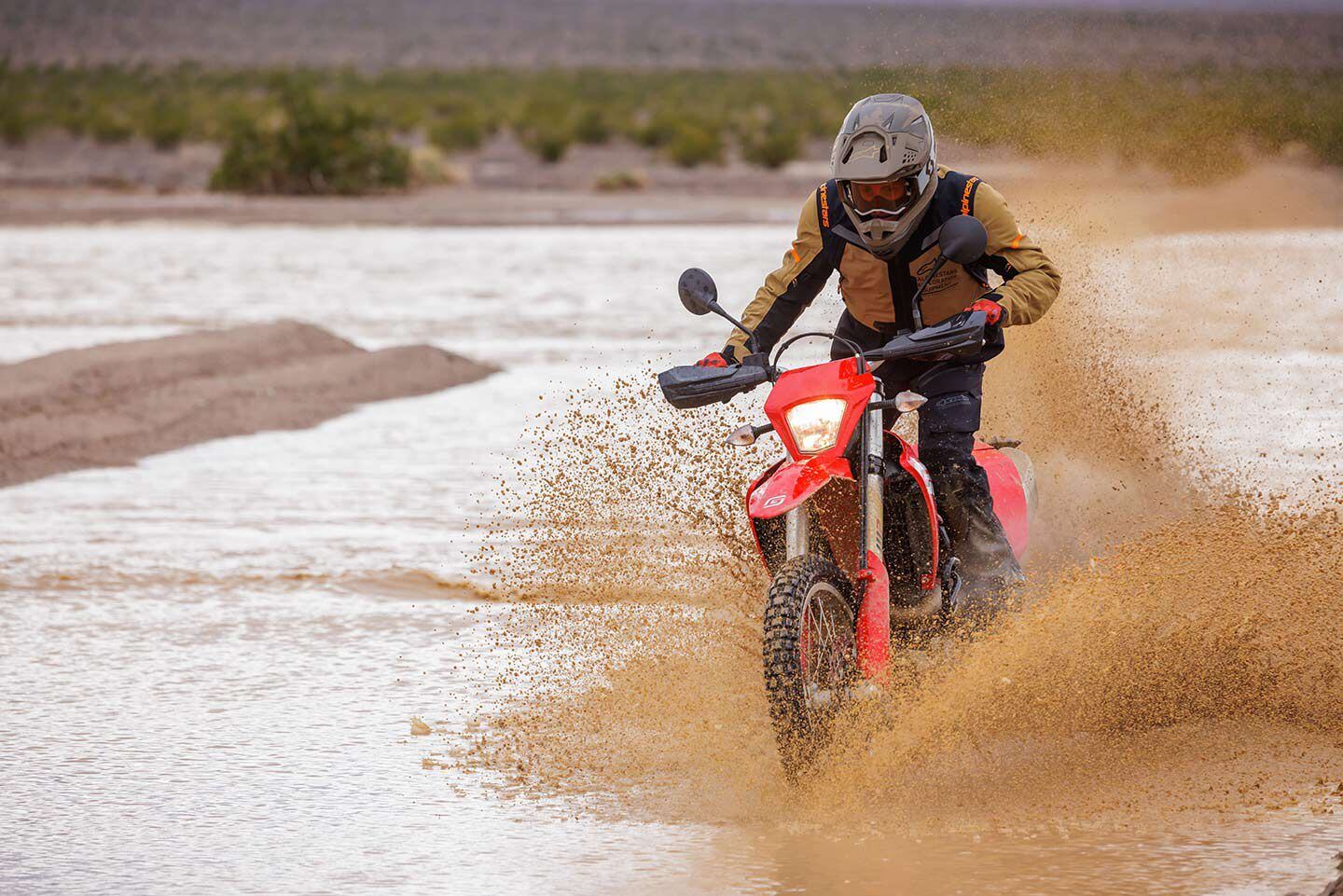
I managed to stay fully dry in my Alpinestars Gore-Tex adventure bike gear. (Alpinestars/)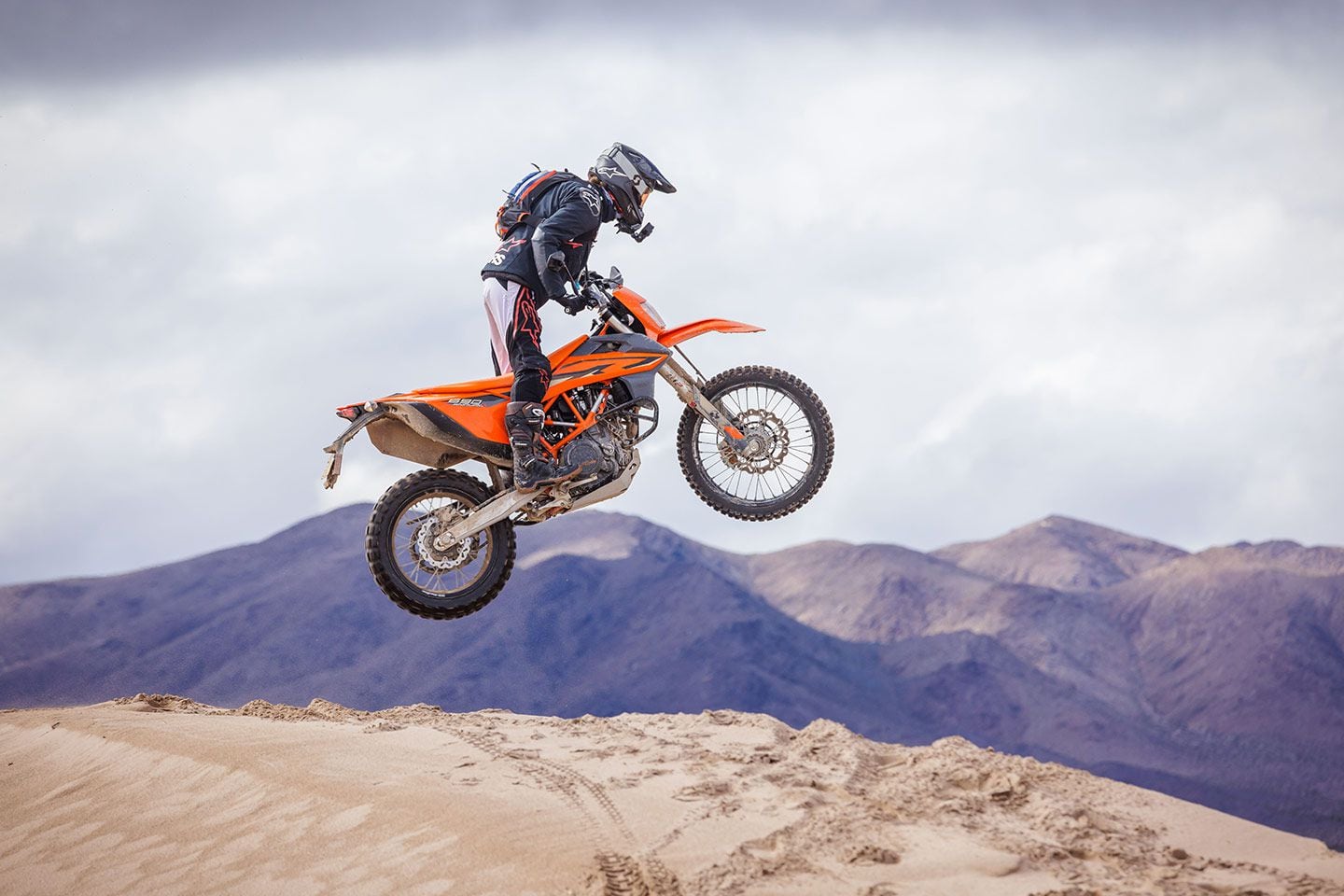
In Rally mode and Enduro mode, the Tech-Air Off-Road will not deploy on most jump landings. (Alpinestars/)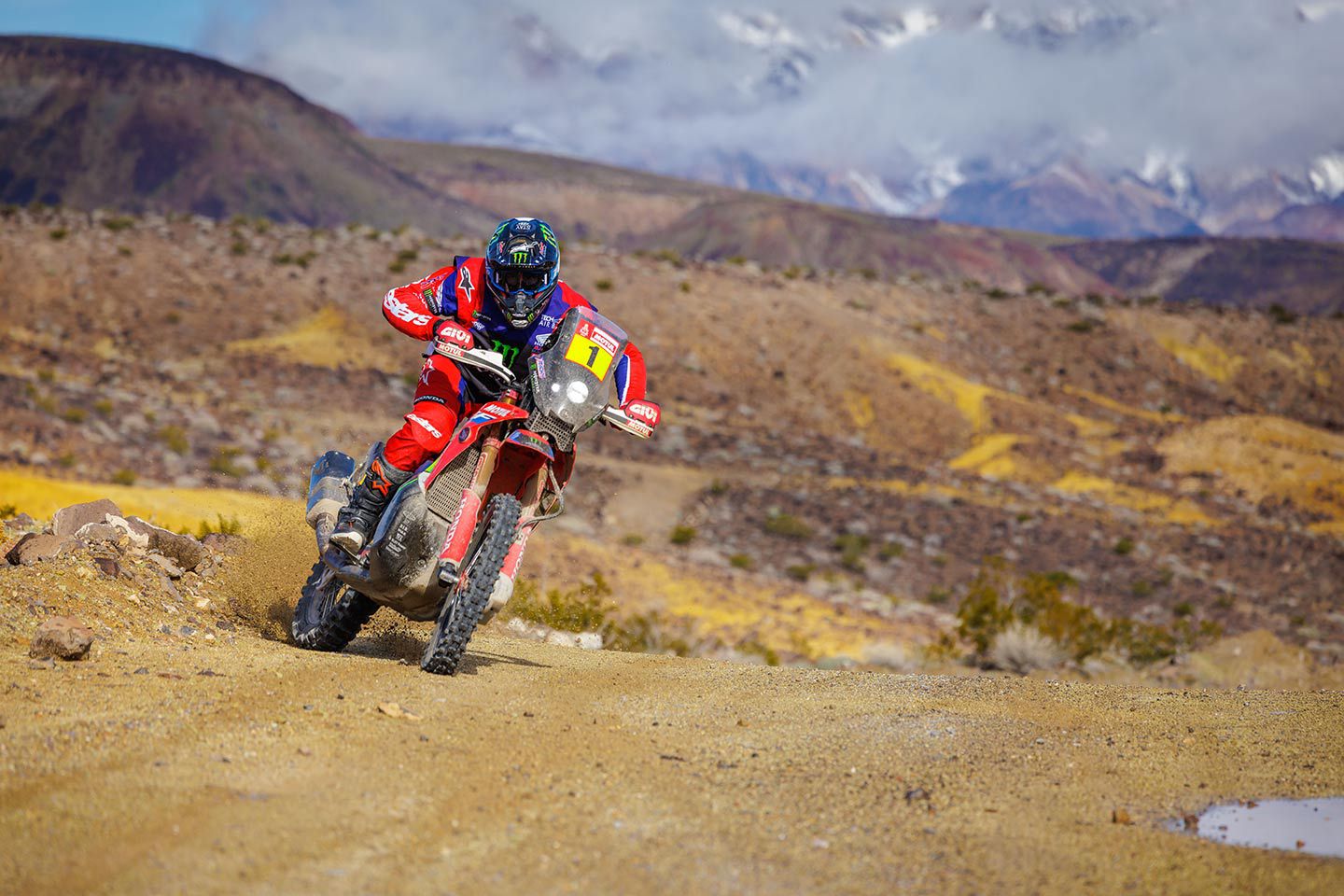
Two-time Dakar winner (2020, 2024) Ricky Brabec on his practice Honda HRC rally bike. (Alpinestars/)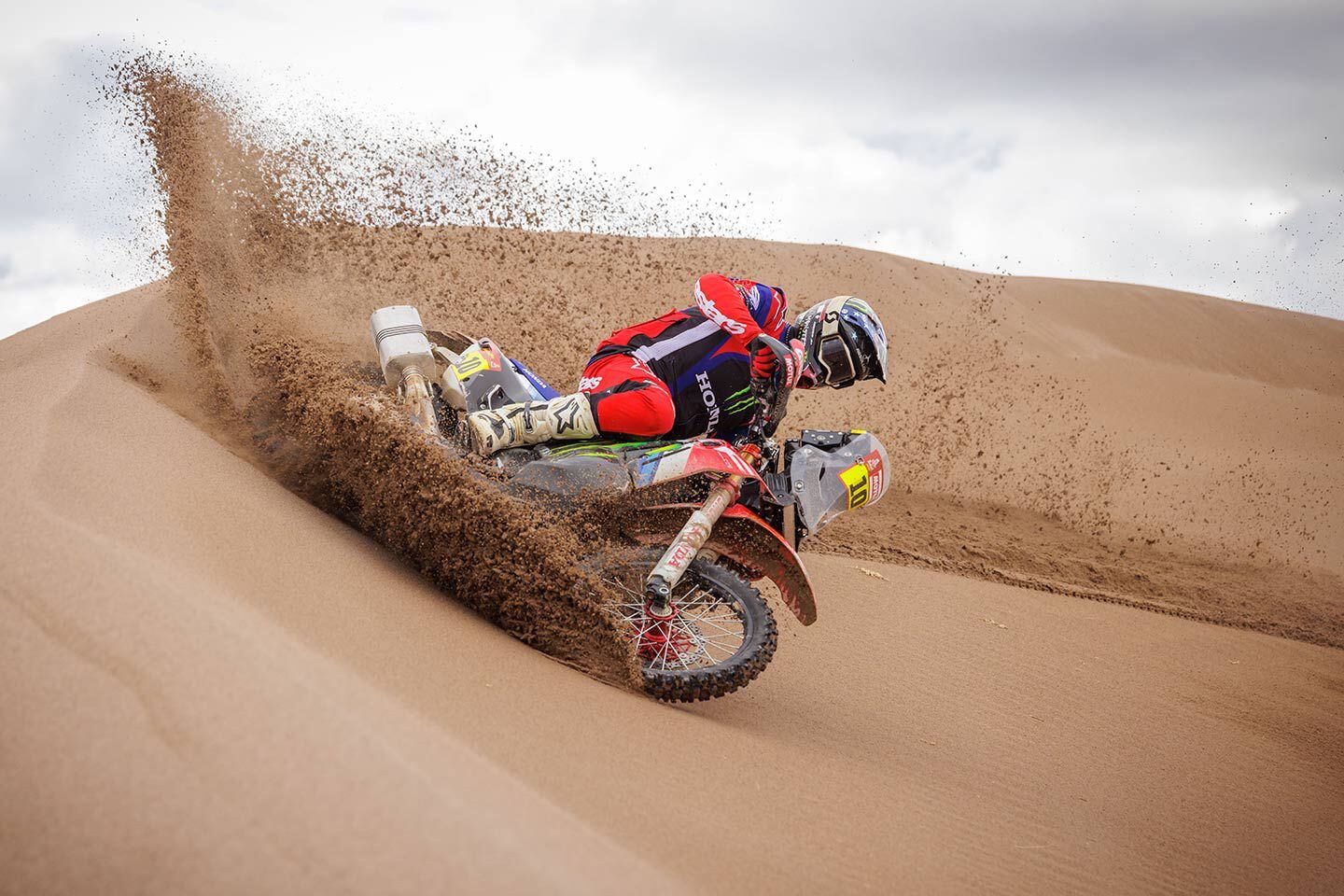
Honda HRC rally racer Skyler Howles sand surfing in the wet dunes. (Alpinestars/)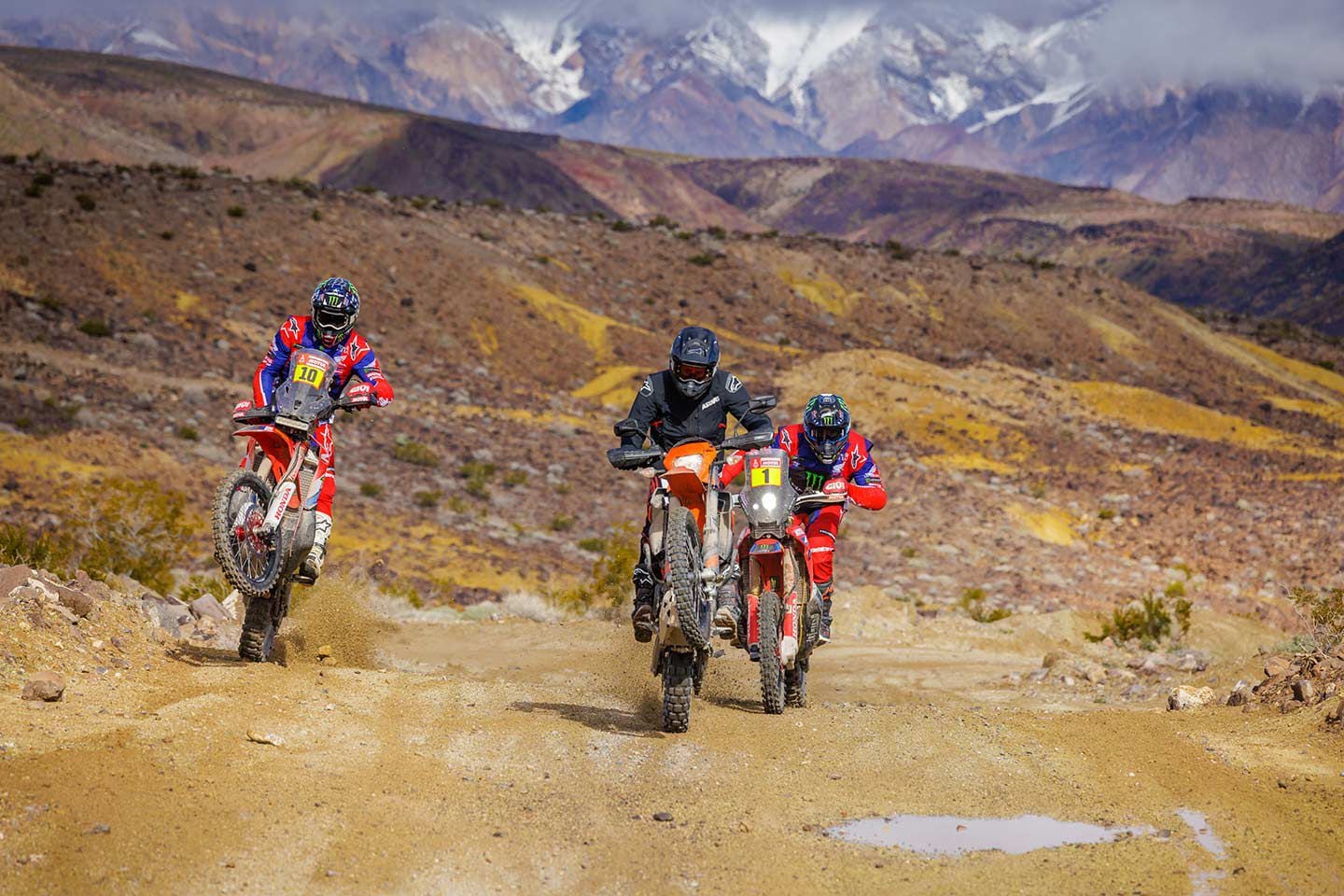
Skyler and Ricky let me lead for a little. Braap! They're gone. That didn't take long. (Alpinestars/)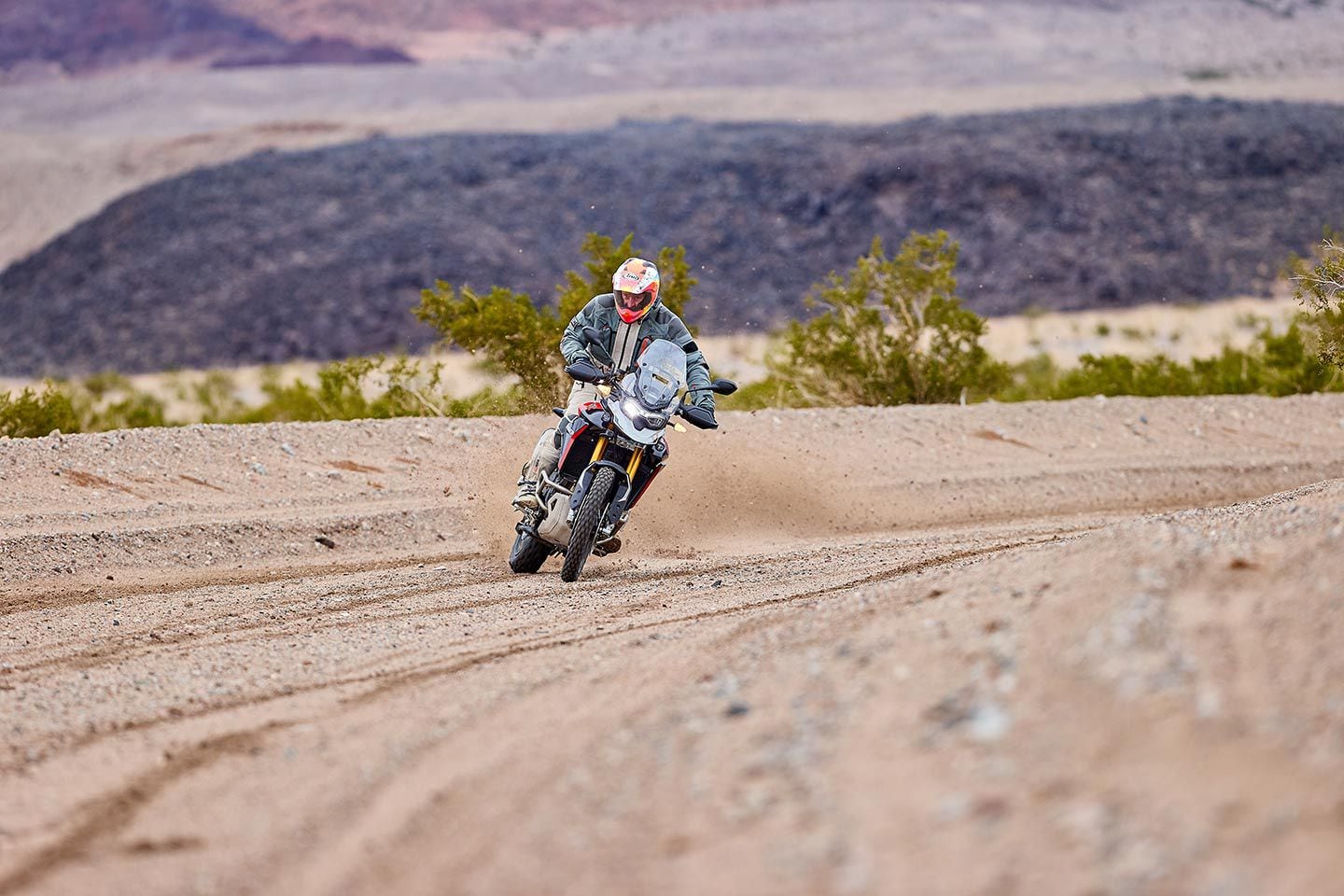
Six-time AMA champion Jeff Stanton steering with the rear on his Triumph Tiger 900 Rally Pro. (Alpinestars/)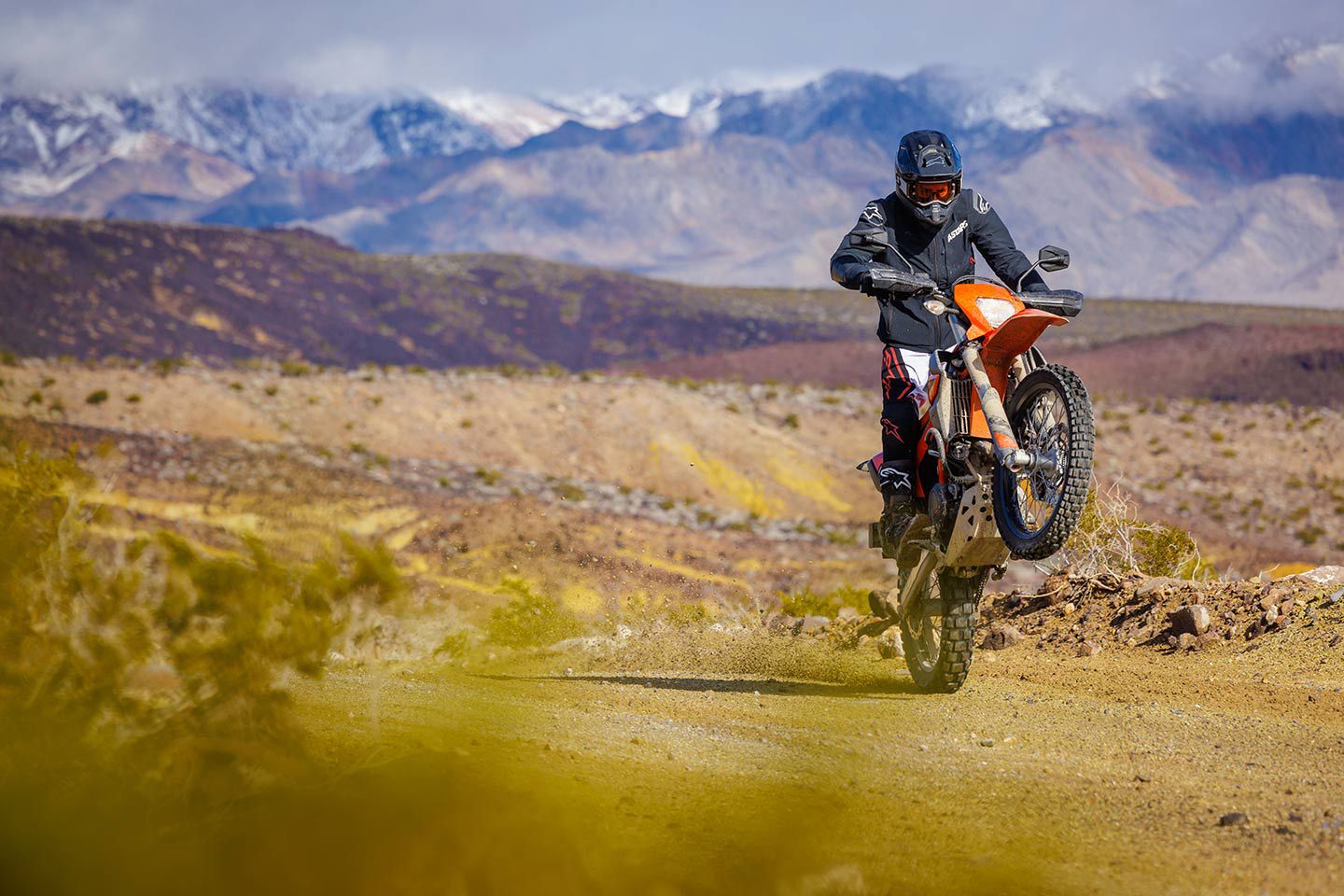
I swear there was a sign that read “Lift front wheel if you wear protection.” (Alpinestars/)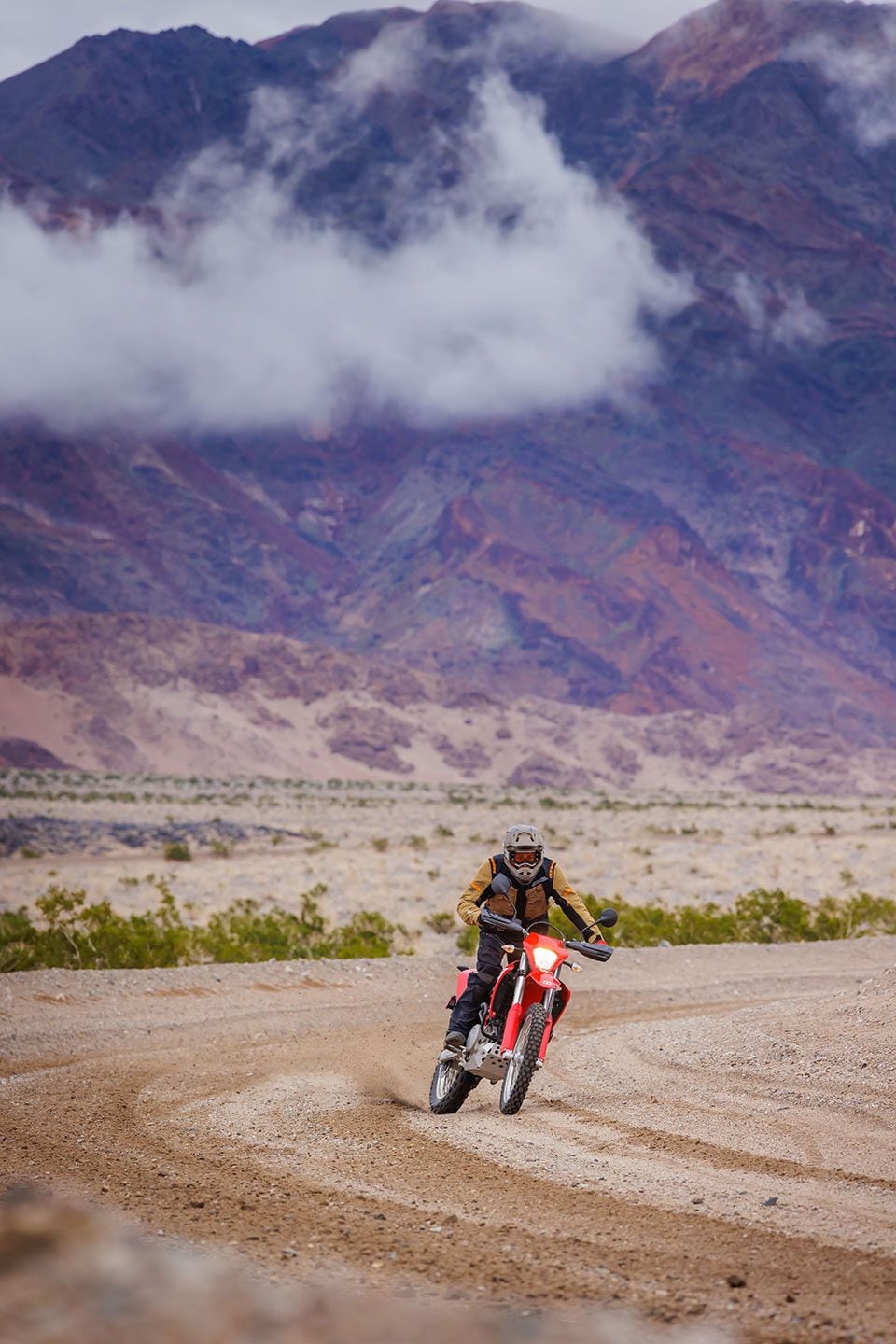
Beautiful Death Valley after a heavy rain. (Alpinestars/) -
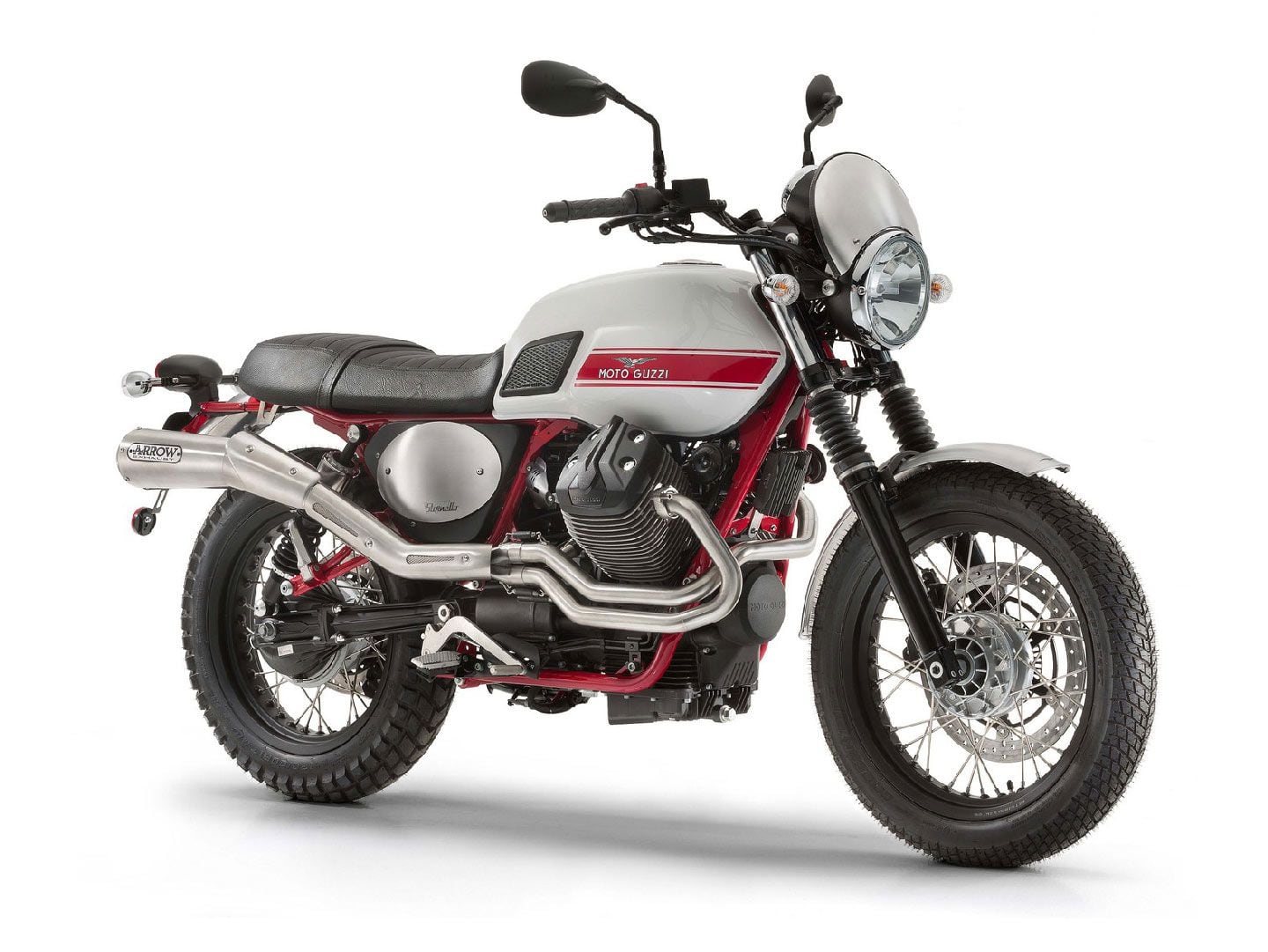
Is Moto Guzzi bringing back the V7 Stornello in the same form it last existed? (Moto Guzzi/)Moto Guzzi has applied for new trademark rights over the Stornello name in the USA after its previous trademark expired last year, hinting that the company has plans to revive the title on a new model in the not-too-distant future.
While many companies will hold onto rights over long-dead model names just in case they feel the need to revive them, the United States Patent and Trademark Office has stricter “use it or lose it” requirements than many other countries, making the new application a stronger hint that the title will reappear on a production bike soon. The last set of US trademark rights that Moto Guzzi’s parent company, Piaggio, held over the Stornello name were applied for back in November 2015—around the same time that the limited-edition 2016 Moto Guzzi V7 Stornello model was launched—and expired in November 2023.
The last, V7-based Stornello model was a tribute to the 1965 to ‘68 Guzzi Stornello 125 Scrambler America, which inspired its red-and-white paintwork and high-level exhaust pipe, but the Stornello name dates back further than that, to dawn of the 1960s when it was introduced on a road-oriented 125cc single. Today, Guzzi has several options when it comes to reviving the name.
One possibility is that the next Stornello will take its cue from the last one. The V7 is still in Moto Guzzi’s range, albeit much improved over the last decade, so a new V7-based Stornello scrambler would be relatively easy to engineer. Alternatively, the V85 TT—which wasn’t part of the Guzzi range back in 2015 when the last Stornello was launched—already has some off-road ability and could easily be reworked into a more retro-style machine with an eye toward competing against Triumph’s Scrambler 900.
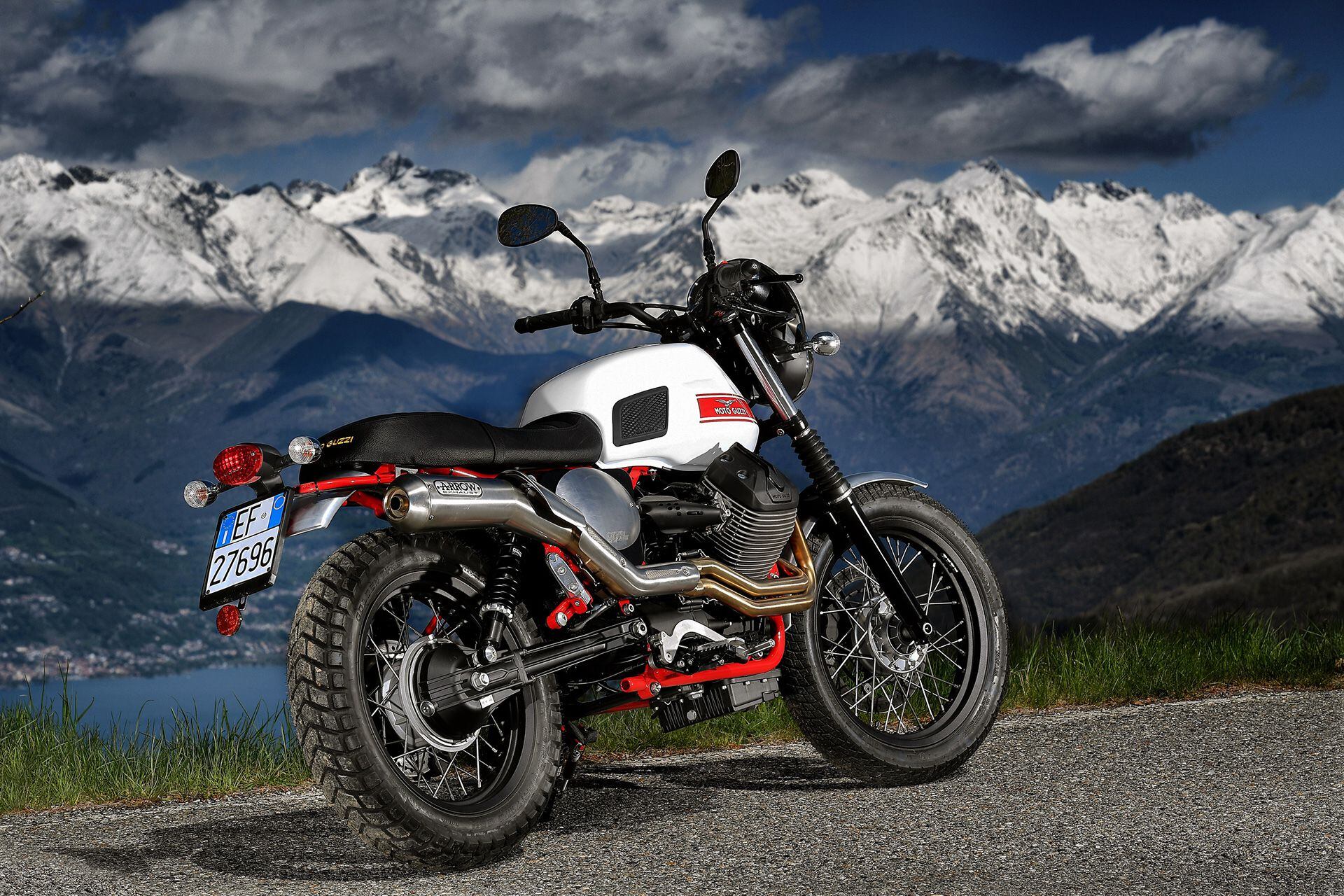
Moto Guzzi’s V7 Stornello. <i>Moto Guzzi</i>Another possibility is that Moto Guzzi will look not to the Stornello Scrambler of the 1960s but the earlier, street-oriented machine for inspiration. The name Stornello actually translates as “Starling” and was originally intended to reflect the fact that the bike bearing it was a small-capacity, lightweight model. At the start of this year Piaggio’s test riders were spotted on a small, unfaired parallel-twin prototype using the parallel-twin engine from the Aprilia RS 457 but wrapped in a chassis and styling that looked very much like it was part of the Moto Guzzi stable. A small, entry-level Moto Guzzi was precisely what the original Stornello was, so if Guzzi goes ahead with a new 450 it might be an apt title for that machine.
-
 3
3
-

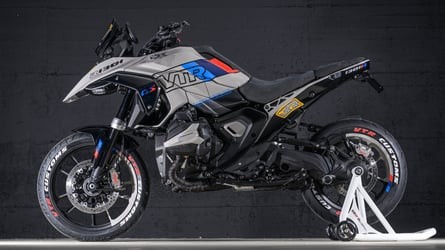
Josh Herrin and Warhorse HSBK Ducati Win 2024 Daytona 200
in Motorbike news
Posted
Josh Herrin won his third Daytona 200. (Ducati/)
Like Mount Everest, Daytona gets our attention “because it’s there.” A lot has changed since the early days, but the Daytona 200-mile motorcycle roadrace carries on.
Last Saturday’s win by Josh Herrin on a Warhorse Panigale 955 Ducati was not really a surprise, but his achievement of a third 200 win establishes him as one of the distinguished multitime winners who know how to stay durably fast on this track through a long afternoon. He also showed the truth of what Kurtis Roberts told us in the entryway of the old Benny Kahn press room years ago: All those miles aren’t racing so much as they are a time for surviving and planning. The final two laps may turn out to be the real race, when the rider who best understands the dynamics of drafting will cross the line first. This time, Herrin won without last-lap drama.
Herrin (center) won his third Daytona 200 without last-lap drama. Tyler Scott (left) was second and Hayden Gillim (right) took third. (Ducati/)
Years ago I spoke with five-time 200 winner Scott Russell, asking him what is central to survival and success in the 200. His words were roughly: “When you come off a corner, you want to open up, accelerate hard, spin the tire. At Daytona you can’t. You have to control yourself and think of the tire.”
Another essential Daytona skill is getting past the clumps of lappers—not being held up, not using any of your nine lives. I well remember the barely contained fury of Miguel DuHamel, who, having nearly been killed by an erratic slowpoke, was surrounded by Honda handlers trying to keep him from saying things they might regret. He explained clearly: “The slow rider has the extra grip to make sudden moves. The fast rider is using all his grip to go fast, so he’s committed to his line.”
The race is long and the track is “not especially smooth.” You see the bikes’ suspension working all the time, and riders are constantly jolted. It’s physical.
Pit Stops
Every team hopes to execute two routine, professional gas and tire stops. MotoAmerica pit reporter Hannah Lopa had it right when she said a successful stop calls for “…not so much physical speed but precision. The crew must be smooth and deliberate.”
In the improvised pre-race “pit-stop contest” with $7,500 to win, I saw what happens so often on race day: fumbles from trying too hard. In one case, the rear axle wasn’t tight and in the other, the team began to push before the air wrench was off the axle. Both were DQ’d. In the race, Herrin’s team did the work professionally.
Fuel Management
Fuel management means someone on each team must be a competent soloist on the hand-held calculator. What mileage are we getting through practice? Tank capacity limit is 19 liters, or 5 US gallons. When Richie Escalante (M4 Suzuki GSX-R750), running second, ran out of gas during his final lap he did what we’ve all done when a bike has cut out: tried leaning and sloshing, hoping to push remote pockets of fuel to the pump inlet. Rider after rider passed him—a bad dream as a sure second became fifth (he was later advanced to fourth). Previously, he had led third place by a comfy 40 seconds. Word had it they refueled 21 laps from the end. Did they know their tank volume accurately? Were they sure of 100 percent fill-ups? Escalante later commented, “I don’t think this place likes me.”
Fuel calculations are key to success at Daytona. (Ducati/)
I have seen people take the empty tank to a gas station and “measure it” by filling it from a gas pump. It’s a clever improvisation, but is it good enough? Bobby Fong, one of the early leaders, was disqualified for a slightly oversized fuel tank.
Dick Mann on one occasion suggested that a high-finishing rider who knows his tank may be “a little big” would be excused for expressing his joy by punching the fuel tank (only works on metal tanks, of course).
Having a 4-liter graduated cylinder enables keeping track of consumption through practice, and it also provides actual knowledge of tank volume.
Herrin’s engine cut just after entering pit lane on one of his stops, but he was able to reach his crew.
Brandon Paasch (M4 Team Hammer Suzuki) led, then his engine stuttered, and he just made it to his first stop. All went well until the fuel can was lifted, at which point the dry-break valve on the can failed to fully close, the resulting spray making it look like a huge fuel-injection nozzle. He rode away wet. We were told by the dry-break manufacturer to use new O-rings, lubricated, because there could be cases in which the spring is unable to close and seal the valve.
Tyler Scott finished second at the 2024 Daytona 200. (Suzuki/)
The difference between the strong, prepared teams at the top and the rest of the field is magnified at Daytona: in 1978, the year of the notorious intake restrictors, Kenny Roberts lapped the field. Near the end of this year’s race, Josh Herrin was lapping ninth place.
Changes Over the Years
How has Daytona changed? For years, displacement formulas were in force. Back when it was Triumph versus Harley-Davidson, it was 500cc for overhead valve engines and 750 for side-valves. The 1968 Competition Congress reset to a straight 750 formula beginning in 1970, and racing became international, with Triumph, BSA, Honda, and Harley-Davidson factory teams. Daytona became the one race every manufacturer yearned to win. Through the two-stroke years (1972–1984) displacement still ruled: Lightweights were 250s, pro bikes were 750s.
Daytona’s driving force in those factory-team days was the hope of pushing product into the world’s greatest market. And how they tried! Honda won it in 1970, BSA the year after, but in both cases it was the race savvy of Dick Mann making it possible. As the two-stroke era began in 1972, the number of Japanese engineers in each team became the yardstick of power. One top crew chief at the time joked that somewhere in the back of the Yamaha garage were two unopened crates. One was stenciled, “Open this one if it won’t run under 2:02,” and the other, “Open this crate if it won’t speed-trap over 190.”
Production-based four-stroke 750 Superbikes became the Daytona 200 class in 1985, and the coming of supersport continued the idea of displacement-limited racing: 600 and 750.
When the class became 750 two-stroke, 1,025cc four-stroke in 1980, Honda for 1982 entered its tire-eating V-4 “FWS,” and riders Mike Baldwin and Freddie Spencer led effortlessly. Honda came prepared, with trick hardware to enable rapid tire changing. It proved no match for what Daytona can do to rubber. Tire changes have been the norm in the 200 ever since.
When it was decided for 2009 that nothing should run over 180 mph at Daytona, 600 Supersport replaced Superbike in the 200. That was when Mat Mladin referred to the 600s as “minibikes.”
Richie Escalante ran out of gas on the last lap while running second. He crossed the line fifth, but was awarded fourth after Bobby Fong was DQ’d for an over-capacity fuel tank. (Suzuki/)
When sportbike sales augured in after the 2008 economic crash, 600 sales collapsed. Whatever shall we do if Japan stops building 600s? A fresh idea emerged: Let’s race bikes of similar lap time, not of identical displacement. This is Supersport Next Generation, which includes Ducati 955 twins and Triumph and MV triples, along with the usual 600s, Kawasaki’s 636s, and Suzuki’s GSX-R750—all subject to periodic performance adjustments.
Superbike remains MotoAmerica’s premier class at all other events.
Present-day Daytona lap times can’t be compared with those of earlier times because the need for more motorhome parking has caused shortenings of the first infield horseshoe. The chicane has also evolved. Is nothing sacred? Answer: Yes.
The drama of Daytona never changes: Who can survive all the potential chaos to be in the top group at the end? Or better yet—to do what Herrin did this year—to run a sustainable pace, keeping the tires sweet, that carries the winning rider out of reach.
2024 Daytona 200 Results
View the full article